- Analytics
- News and Tools
- Market News
CFD Markets News and Forecasts — 22-02-2023
- NZD/USD has attempted recovery from 0.6210 as investors expect a string of bumper rate hikes by the RBNZ ahead.
- A fresh cyclone relief package by NZ Hipkins is subjected to fuel inflationary pressures further.
- Fed Bullard is favoring an aggressive monetary policy to squeeze the giant inflation.
The NZD/USD pair has sensed demand after dropping to near 0.6210 in the early Asian session. The Kiwi asset has rebounded as the Reserve Bank of New Zealand (RBNZ) is citing a string of bumper rate hikes to fade fresh fears of further acceleration in the inflationary pressures.
Despite pushing the Official Cash Rate to 4.75% on Wednesday, RBNZ Governor Adrian Orr is favoring more mega rate hikes. The New Zealand inflation has not peaked yet and a fresh cyclone relief package of NZ$300 million ($187.08 million) promised by NZ Prime Minister (PM) Chris Hipkins is subjected to fuel inflationary pressures further.
Economists at Westpac expect a peak of 5.5% in the OCR this year, up from our earlier forecast of 5.25%.” A note from Westpac stated “The RBNZ remains committed to bringing inflation back under control and sees the risks as being to the upside of its already-strong forecasts. As a result, we expect that it will carry through with its plans, at least in the near term.”
A slight recovery in the risk-appetite theme has supported the New Zealand Dollar. S&P500 futures have rebounded and have confidently recovered Wednesday’s losses. The alpha provided on the 10-year US Treasury bonds has slipped to near 3.92%.
Meanwhile, St. Louis Federal Reserve (Fed) President James Bullard has advocated an aggressive interest rate hike in the March monetary policy meeting to sharpen its tools in the battle against persistent inflation. Fed policymaker believes that the central bank has a chance to tame inflation significantly in 2023 without pushing the United States into a recession. Also, Fed Bullard has come forward with a terminal rate projection of 5.4%.
On Thursday, investors will see a power-pack action after the release of the annualized US Gross Domestic Product (GDP) (Q4) data. The economic data is seen unchanged at 2.9%. An upbeat US GDP data could infuse fresh blood into the US Dollar Index (DXY) ahead.
- The AUD/JPY drops below the 100-day EMA and the 92.00 psychological figure.
- AUD/JPY Price Analysis: Hits a new weekly low at 91.67, about to test the 200-DMA.
Due to a risk-off impulse, the AUD/JPY slides below the 20-day Exponential Moving Average (EMA), eyeing the intersection of the 200 and 50-day EMA at around 91.55/60. However, as the Asian session begins, the AUD/JPY is trading at 91.84, registering minuscule gains of 0.08%.
The AUD/JPY peaked during the week at around 93.01 on Tuesday and has enjoyed a downtrend of two straight days since then. The AUD/JPY failure to break above the last week’s high of 93.03 exacerbated a downfall of 120 pips or 1.30%. Oscillators like the Relative Strength Index (RSI) is neutral, while the Rate of Change (RoC) suggests that sellers are gaining momentum. Therefore, in the near term, the AUD/JPY might print a leg-down.
The AUD/JPY first support would be the 20-day EMA at 91.75. A breach of the latter will expose the confluence of the 200 and 50-day EMA at around 91.55/60, that once cleared, would pave the way toward 91.00. The sellers’ next stop would be the February 10 daily low of 90.22.
As an alternate scenario, the AUD/JPY first resistance would be the 92.00 figure. Once broken, the AUD/JPY will threaten the February 22 daily high at 92.68, followed by 93.00.
AUD/JPY Daily chart
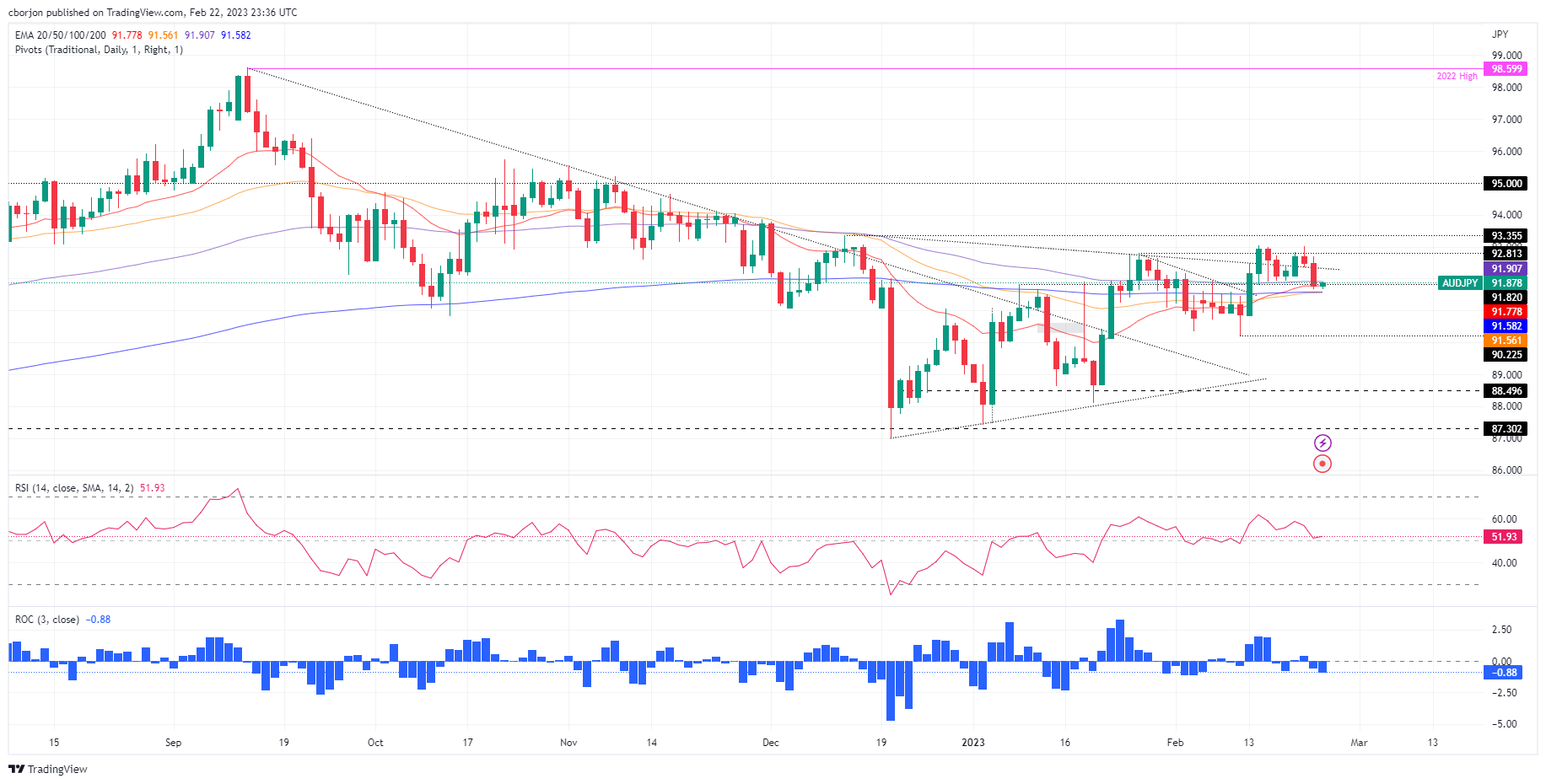
AUD/JPY Key technical levels
- Silver price remains sluggish after posting the biggest daily loss in two weeks.
- Clear U-turn from 100-DMA, bearish MACD signals favor XAG/USD sellers.
- Buyers need daily closing beyond $22.60 to retake control.
Silver price (XAG/USD) struggles for clear directions at the weekly low surrounding $21.50 during early Thursday, after posting the biggest daily slump in a fortnight.
Although the early hours of the day restrict the metal’s moves, the XAG/USD remains on the bear’s radar while observing the previous day’s clear U-turn from the 100-DMA hurdle. Adding strength to the downside bias are the bearish MACD signals.
As a result, the Silver price is well-set to test the 200-DMA support of $21.00. However, the 50% Fibonacci retracement level of the metal’s upside from October 2022 to February 2023, around $21.35 will precede the latest swing low near $21.20 to probe the immediate downside.
In a case where the Silver bears dominate past 200-DMA, the 61.8% Fibonacci retracement level around $20.60, also known as the golden Fibonacci ratio, could act as an intermediate halt during the quote’s likely fall toward the $20.00 psychological magnet.
On the flip side, the Silver buyers are less likely to get convinced even if the metal offers a daily closing beyond the 100-DMA hurdle of $22.00.
That said, the 38.2% Fibonacci retracement and an 11-week-old horizontal resistance area, respectively near $22.15 and $22.55-60, could act as the last defense of the XAG/USD bears.
Overall, the Silver price is likely to remain bearish despite the latest inaction.
Silver price: Daily chart
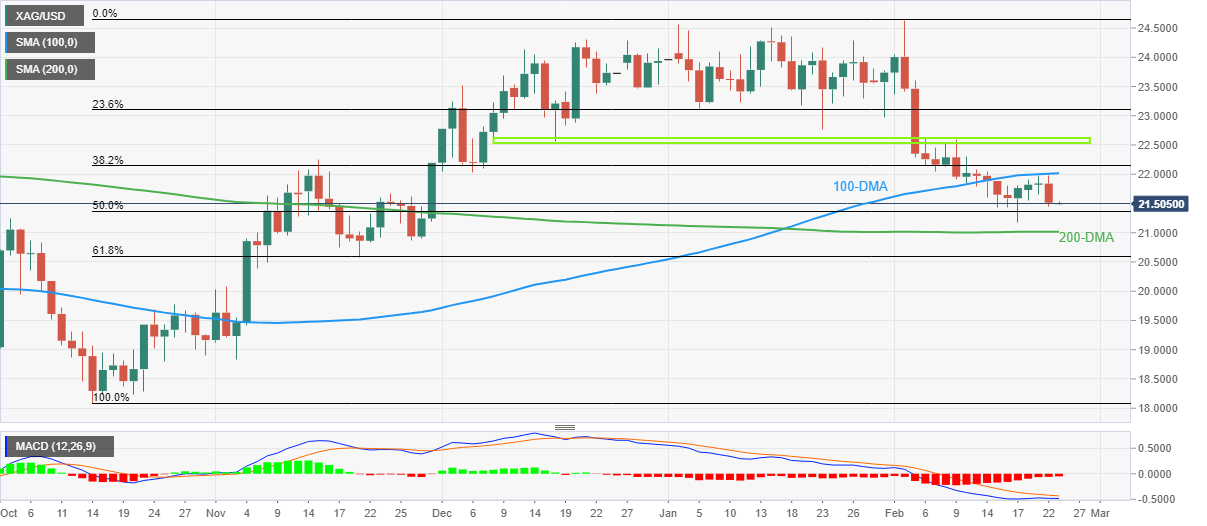
Trend: Further downside expected
- GBP/USD is gauging an intermediate cushion around 1.2040, however, the overall market mood is still negative.
- Fed policymakers are still reiterating higher interest rates for a longer period to achieve the 2% inflation target.
- The annualized US GDP Q4 data is seen stable at 2.9%.
The GBP/USD pair has sensed a pause in the downside momentum after dropping to near 1.2040 in the early Asian session. It would be early to consider a loss in the downside momentum for the Cable as higher volatility might stay ahead of the release of the preliminary United States Gross Domestic Product (GDP) data for the fourth quarter of CY2022. The annualized economic data is seen stable at 2.9%
The Cable witnessed an intense sell-off in the late New York session after the release of the hawkish Federal Open Market Committee (FOMC) minutes. Federal Reserve (Fed) chair Jerome Powell and his mates are still reiterating higher interest rates for a longer period to drag the Consumer Price Index (CPI) to near 2% target.
Fed policymakers are worried that China’s reopening after the rollback of lockdown curbs and ongoing Russia’s invasion of Ukraine advocate upside risks in inflation. Domestically, a shortage of labor could propel a higher wage price index ahead.
Meanwhile, S&P500 futures have shown a recovery in the Asian session. The 500-US stocks basket futures have recovered their entire losses shown on Wednesday. A sense of optimism has been observed in the overall risk aversion theme.
The optimism could fade as President Joe Biden told that it was a "big mistake" for Russian President Vladimir Putin to temporarily suspend Russia's participation in the last remaining nuclear arms treaty between the two countries. Earlier, US Biden announced “Russia was suspending its participation in the New START treaty, which implements caps on the number of nuclear weapons deployed by each country and inspections of nuclear sites,” as reported by ABC News.
The Pound Sterling looks struggling again as the recovery in manufacturing activities is not sufficient enough to avoid the recession ahead. The preliminary United Kingdom manufacturing activities remained upbeat at 49.2, however, a figure below 50.0 is considered a contraction. UK households are struggling to address their usual demand due to higher food inflation, which is impacting their confidence in the economic prospects.
- AUD/USD steadies around multi-day low, probes two-day losing streak.
- Hawkish Fed Minutes, fears emanating from China, Russia weigh on Aussie pair.
- Downbeat Australia data add strength to the bearish bias.
- Second readings of the US Q4 PCE, GDP will be important ahead of Fed’s preferred inflation gauge.
AUD/USD picks up bids to refresh intraday high around 0.6810 as bears take a breather around the 1.5-month low, after a two-day downtrend, during early Thursday. In doing so, the Aussie pair might have cheered the latest geopolitical hints from US President Joe Biden but the broad pessimism surrounding the Ukraine-Russia war and the Fed’s aggression keeps the Aussie bears hopeful.
That said, President Joe Biden said on Wednesday, in an interview with ABC News, that he did not read into Vladimir Putin's decision to temporarily suspend participation in a nuclear arms treaty as a signal the Russian President was considering using nuclear weapons. US President Biden, however, called it a "big mistake", reported Reuters.
Although the headlines ease the geopolitical fears by a bit, comments from China's top diplomat Wang Yi and Russian President Putin weigh on the sentiment and the risk-barometer AUD/USD pair. China’s Diplomat Wang Yi met Russian President Vladimir Putin and said that they are ready to deepen strategic cooperation with Russia on Wednesday, as reported by Reuters. The Chinese policymaker also added that their relations will not succumb to pressure from third countries. Meanwhile, Putin noted that it's very important for them to have a cooperation with China and said he is looking forward to Chinese President Xi Jinping visiting Moscow.
Elsewhere, hawkish Federal Reserve (Fed) Minutes and statements suggesting higher interest rates from the Fed also weigh on the AUD/USD. As per the latest Federal Open Market Committee’s (FOMC) Monetary Policy Meeting Minutes, all participants agreed more rate hikes are needed to achieve the inflation target while also favoring further Fed balance sheet reductions. Adding strength to the hawkish Fed Minutes were statements suggesting that a few participants favored a 50 basis point (bps) rate hike, while some believed there was an elevated risk of a recession in 2023.
On the same line, St. Louis Federal Reserve President James Bullard also mentioned that the Fed will have to go north of 5% to tame inflation, as reported by Reuters. The policymaker also stated that he believes there are good chances they could beat inflation this year without creating a recession. The same suggests higher Fed rates for longer and exerts downside pressure on the AUD/USD price. Additionally, Federal Reserve Bank of New York President John Williams also highlighted the hawkish Fed concerns and weighed on the AUD/USD as he said, “Fed is absolutely committed to getting inflation back to 2%.”
It should be noted that downbeat prints of Australia’s Wage Price Index for the fourth quarter (Q4) join softer Q4 Construction Work Done and unimpressive Westpac Leasing Index for January to weigh on the AUD/USD price.
Amid these plays, the US Dollar Index (DXY) stretched its previous run-up to refresh the multi-day high while the US 10-year and two-year Treasury bond yields retreat from their three-month high. Further, Wall Street closed mixed and should have put a floor under the AUD/USD.
Moving on, AUD/USD bears will be interested in seeing a strong print of the Personal Consumption Expenditures for the fourth quarter (Q4), as well as no disappointment from the second readings of the US Gross Domestic Product (GDP) for the said period.
Technical analysis
A daily closing below the three-month-old ascending trend line, now immediate resistance near 0.6820, needs validation from the 200-DMA support surrounding 0.6800 to convince the AUD/USD bears.
New York's Federal Reserve John Williams explained that the 2% inflation is the foundational target and that price stability is an absolute imperative,
Key notes
We are absolutely committed to getting back to 2% over the next few years.
Although goods prices have come down in last several months, there are signs this may not go as quickly as hoped.
We have demand that exceeds supply, labor market is extraordinarily strong.
Monetary policy must bring demand and supply back into balance.
Don't want to allow inflation expectations anchor to slip.
President Joe Biden said on Wednesday, in an interview with ABC News, that he did not read into Vladimir Putin's decision to temporarily suspend participation in a nuclear arms treaty as a signal the Russian President was considering using nuclear weapons. US President Biden, however, called it a "big mistake", reported Reuters.
Additional statements
It's a big mistake to do that. Not very responsible. But I don't read into that that he's thinking of using nuclear weapons or anything like that.
Well look, I think we're less safe when we walk away from arms control agreements that are very much in both parties' interests and in the world's interest.
The idea that somehow this means they're thinking of using nuclear weapons, intercontinental ballistic missiles, there's no evidence of that.
Putin earlier this week backed away from the New START arms control treaty - a 2010 agreement that limits the number of Russian and U.S. deployed strategic nuclear warheads - and warned that Moscow could resume nuclear tests.
Market implications
Such headlines weigh on risk appetite and exert downside pressure on the Gold price, trading near $1,820 support by the press time.
Also read: Gold Price Forecast: XAU/USD slides on hawkish Federal Reserve Minutes, United States data eyed
- USD/CHF is almost flat as Thursday’s Asian session kicks in.
- USD/CHF Price Analysis: Downward biased, though it appears to have bottomed around 0.9000.
The USD/CHF clings to 0.9300 as the Asian Pacific session begins, but it’s trading beneath its opening price after printing a new weekly high of 0.9318 and gaining 0.39% on Wednesday. At the time of typing, the USD/CHF exchanges hands at 0.9302.
The USD/CHF pair is neutral to downward biased, with the long-term Exponential Moving Averages (EMAs), the 100 and 200-day EMAs, sitting above the exchange rate each at 0.9383 and 0.9454, respectively. In addition, the USD/CHF spot price remains below the January 6 daily high of 0.9409, which, once broken, could send the pair rallying to test the 200-day EMA.
Even though the USD/CHF bias is tilted to the downside, the pair appears to have bottomed around 0.9059. Also, the Relative Strength Index (RSI) and the Rate of Change (RoC) are bullish, suggesting buyers are piling in.
Therefore, the USD/CHF path of least resistance is upward in the near term. The first resistance would be the last week’s high at 0.9331. A decisive break and the following resistance tested would be the 100-day EMA at 0.9383, ahead of the 0.9400 figure. Once those two supply zones are conquered, buyers will aim toward the 200-day EMA at 0.9454 before posing a threat of the 0.9500 figure.
Contrarily, if the USD/CHF drops below the 50-day EMA at 0.9281, that would exacerbate a fall toward the February 14 daily low at 0.9135.
USD/CHF Daily chart
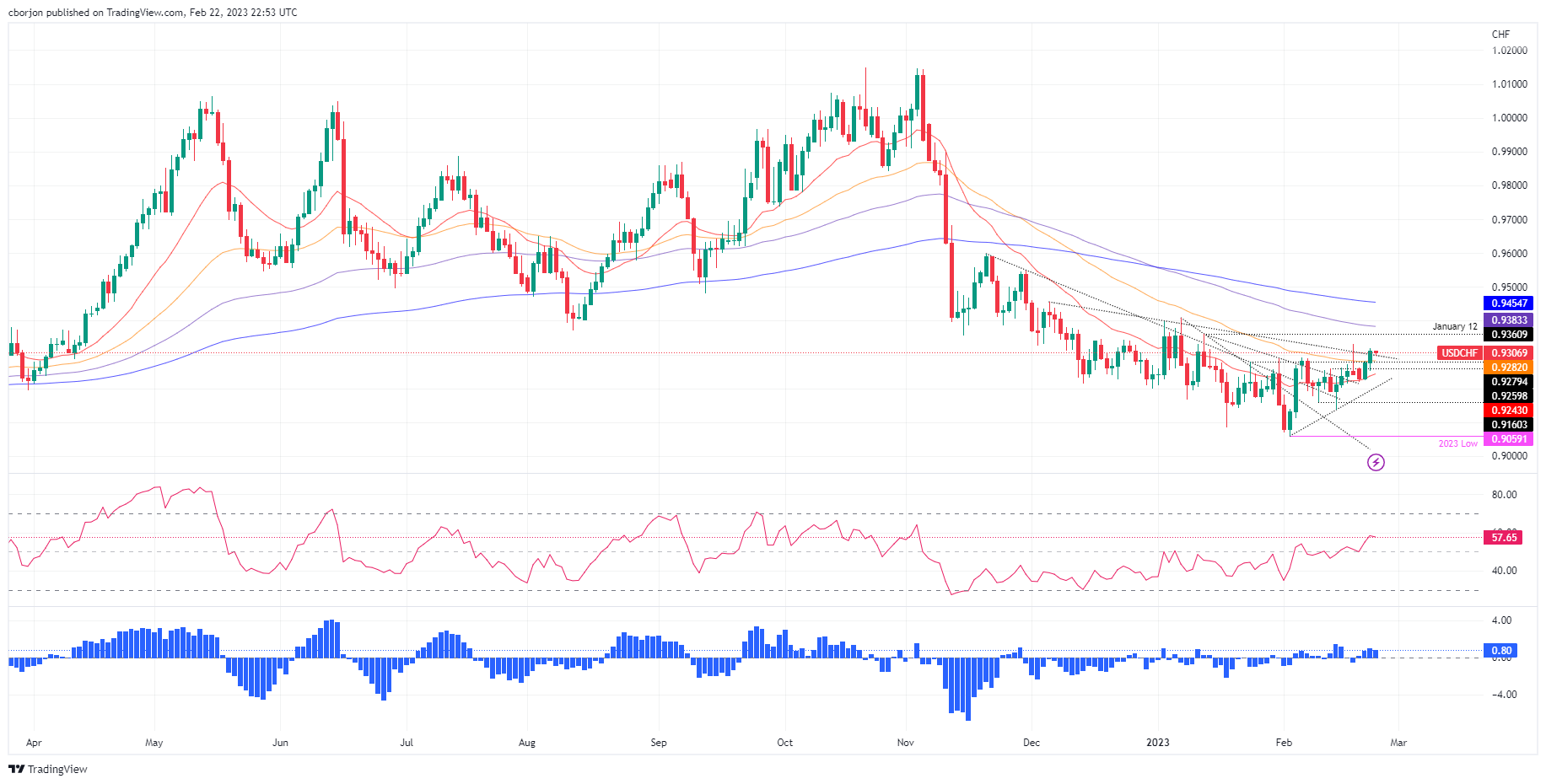
USD/CHF Key technical levels
- USD/CAD is looking to recapture the immediate resistance of 1.3550 amid a dismal market mood.
- An intense sell-off in the oil price after a heavy buildup of oil inventories reported by US API has impacted the Canadian Dollar.
- The RSI (14) is eyeing a break into the bullish range of 60.00-80.00 after a period of four months.
The USD/CAD pair is attempting to recapture the critical resistance of 1.3550 in the early Tokyo session. The Loonie asset witnessed a minor correction after a vertical upside move post hawkish Federal Open Market Committee (FOMC) minutes. The upside bias is still favored as the risk appetite of the market participants has weakened dramatically.
S&P500 futures are demonstrating marginal gains after a choppy trading session. The US Dollar Index (DXY) is aiming to test Friday’s high around 104.33 as investors have underpinned the risk-aversion theme.
Meanwhile, the oil price has refreshed its two-week low at $73.80 after the United States American Petroleum Institute (API) reported bumper oil stockpiles at 9.985 million barrels for the week ending February 17.
USD/CAD has overstepped the 61.8% Fibonacci retracement (placed from December 16 high at 1.3705 to February 2 low at 1.3262) at 1.3536 on a daily scale. The Loonie asset has also crossed the downward sloping trendline plotted from October 13 high at 1.3978, which indicates more upside ahead.
The 20-and 50-period Exponential Moving Averages (EMAs) are on the verge of delivering a bullish crossover at around 1.3445, which will be added to the upside filters.
Also, the Relative Strength Index (RSI) (14) is eyeing a break into the bullish range of 60.00-80.00 after a period of four months. An occurrence of the same will accelerate the upside momentum.
The Loonie asset might record more gains after surpassing February 22 high at 1.3568, which will drive the asset toward the round-level resistance at 1.3600 followed by November 29 high at 1.3645.
Alternatively, a break below February 6 high at 1.3474 will drag the asset to near 38.2% Fibo retracement at 1.3432. A slippage below the same will expose the asset to January 26 high of around 1.3408.
USD/CAD daily chart
-638127026243785618.png)
“Cyclone-related inflationary pressure may require higher rates for longer,” said Reserve Bank of New Zealand (RBNZ) Governor Adrian Orr during an interview with Bloomberg TV on early Thursday in Asia, late Wednesday elsewhere.
Also read: RBNZ's Orr: Core inflation is too high, expectations elevated
Additional comments
There would need to be a large inflationary shock to return to 75bp rate hikes.
RBNZ is optimistic about a return to steady, low inflation.
RBNZ has been aggressive in its tightening.
It’s worth noting that RBNZ’s Chief Economist Paul Conway also crossed wires, via Reuters, while stating that a cyclone that hit New Zealand earlier this month was leading to greater uncertainty around GDP projection. RBNZ's Conway was testifying at parliament's Finance and Expenditure committee meeting, per Reuters.
NZD/USD stays pressured
The news fails to ease pressured off the NZD/USD pair as it holds lower ground near 0.6215 at the latest.
Also read: NZD/USD bears on top as traders await more cues from US data
- Gold price remains pressured around short-term key support after three-day downtrend.
- XAU/USD drops as Federal Reserve Minutes suggest policymakers discussed need of more rate hikes.
- Geopolitical fears, comments from Fed’s Bullard also weigh on Gold price.
- Gold sellers poke 100-day Exponential Moving Average support with eyes on United States statistics.
Gold price (XAU/USD) bears the burden of hawkish Federal Reserve (Fed) bias, as well as the geopolitical fears, as the yellow metal pokes a short-term key support surrounding $1,820 during early Thursday. In doing so, the XAU/USD also justifies the hawkish comments from a Fed Official while portraying the cautious mood ahead of the second-tier United States data amid firmer US Dollar.
Gold drops on hawkish Federal Reserve Minutes
As per the latest the Federal Open Market Committee’s (FOMC) Monetary Policy Meeting Minutes, all participants agreed more rate hikes are needed to achieve the inflation target while also favor further Fed balance sheet reductions. Adding strength to the hawkish Fed Minutes were statements suggesting that a few participants favored a 50 basis point (bps) rate hike, while some believed there was an elevated risk of a recession in 2023.
Given the hawkish Fed Minutes, the odds of sustained rate hikes are high, which in turn weigh on the Gold price, via firmer US Dollar and Treasury bond yields.
Geopolitics, Fed’s Bullard also weigh on XAU/USD
In line with the FOMC Minutes, St. Louis Federal Reserve President James Bullard also mentioned that the Fed will have to go north of 5% to tame inflation, as reported by Reuters. The policymaker also stated that he believes there are good chances they could beat inflation this year without creating a recession. The same suggests higher Fed rates for longer and exert downside pressure on the Gold price.
Elsewhere, geopolitical fears surrounding China and Russia escalated and favored the rush towards the risk-safety, which in turn propelled the US Dollar and weighed on the XAU/USD. The reason could be linked to the comments from China's top diplomat Wang Yi who met Russian President Vladimir Putin and said that they are ready to deepen strategic cooperation with Russia on Wednesday, as reported by Reuters. The Chinese policymaker also added that their relations will not succumb to pressure from third countries. Meanwhile, Putin noted that it's very important for them to have a cooperation with China and said he is looking forward Chinese President Xi Jinping to visit Moscow.
US Dollar strength weigh on Gold ahead of data
Following the hawkish Federal Reserve minutes, comments from Fed’s Bullard and geopolitical fears, the US Dollar Index (DXY) stretched their previous run-up to refresh the multi-day high and pleased the Gold sellers.
That said, the DXY refreshed the weekly high and approached the seven-week high marked in the mid-February. It should be noted, however, that the US 10-year and two-year Treasury bond yields retreat from their three-month high and Wall Street also closed mixed, which in turn should have put a floor under the Gold price.
Gold price technical analysis
Gold price extends pullback from a 10-day Exponential Moving Average (EMA) towards testing the 100-day EMA support, following a failed attempt to cross the two-week-old resistance line.
The downside bias also takes clues from the Moving Average Convergence and Divergence (MACD) indicator’s bearish signals, which in turn suggests the downside break of the immediate 100-day EMA support of $1,820.
However, the Relative Strength Index (RSI) line, placed at 14, is near to the oversold territory and hence suggests the limited room towards the south. As a result, the 61.8% Fibonacci retracement level of the Gold price run-up from late November 2022 to early February 2023, close to $1,812, could challenge the XAU/USD bears.
In a case where the Gold price remains weak past $1,812, the $1,800 threshold and the last December’s low of $1,766 will be in focus.
Alternatively, the aforementioned two-week-old descending trend line and the 10-day EMA< respectively near $1,834 and $1,844, could challenge the XAU/USD rebound.
However, the Gold price recovery remains elusive unless crossing the February 09 swing high surrounding $1,890.
Overall, Gold price remains bearish but the downside room appears limited.
Gold price: Daily chart
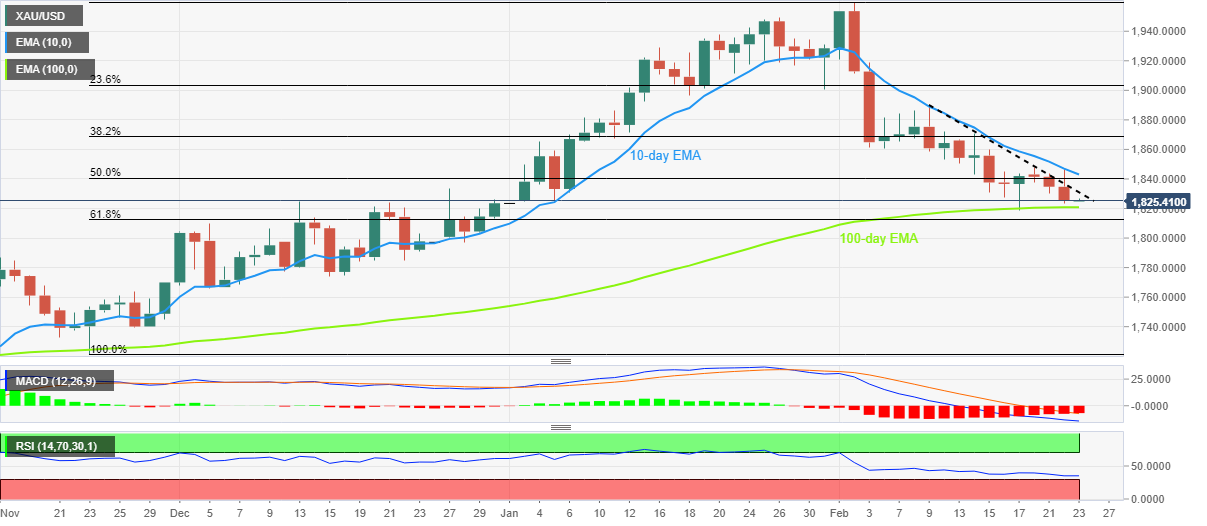
Trend: Further downside expected
- EUR/USD has sensed a loss in the bearish momentum around 1.0600, more downside looks favored.
- Risky assets have been heavily dumped as a few Fed policymakers favored a 50 bps interest rate hike in the February meeting.
- ECB Lagarde has confirmed the continuation of the 50 bps rate hike spell for March.
The EUR/USD pair has gauged a cushion around 1.0600 in the early Asian session. Despite the hawkish commentary in the Federal Open Market Committee (FOMC) minutes, the major currency pair has sensed a loss in the downside momentum. Risk-perceived assets have been heavily dumped as a few Federal Reserve (Fed) policymakers favored a 50 basis point (bps) interest rate hike in February monetary policy meeting to tame stubborn inflation.
It seems that Fed policymakers are not gay with the easing United States Consumer Price Index (CPI) in the last three months and need to see more progress. Fed policymakers have reiterated that higher rates are required for a sufficient period of time to achieve the 2% inflation target. Fed chair Jerome Powell and his teammates are worried that the inflationary pressures are still prone to upside risks due to China's economic reopening and Russia's war with Ukraine.
Fed minutes conveying that higher interest rates will sustain longer have infused fresh blood into the US Dollar Index (DXY). The USD Index is looking for sustainability above 104.00 amid the risk-off mood. S&P500 futures witnessed marginal losses on Wednesday, portraying a risk aversion theme. The demand for US government bonds has marginally improved despite hawkish Fed minutes. The return delivered on the 10-year US Treasury yields has trimmed to 3.92%.
On the Eurozone front, European Central Bank (ECB) President Christine Lagarde clearly announced “Headline inflation has begun to slow down but reiterated that they intend to raise the key rates by 50 basis points (bps) at the upcoming policy meeting. She also cited that the central bank is not seeing a wage-price spiral in the Eurozone.
- USD/JPY's line in the sand is 134.50 currently and bulls need to commit at this juncture.
- The bears will be looking for a weekly close below 134.50.
USD/JPY is holding in bullish territories while on the front side of the meanwhile bullish tren's dynamic support as illustrated on the daily chart above. There are prospects of a move towards the 137.40/50 for the foreseeable future while the support structure holds up.
USD/JPY daily chart
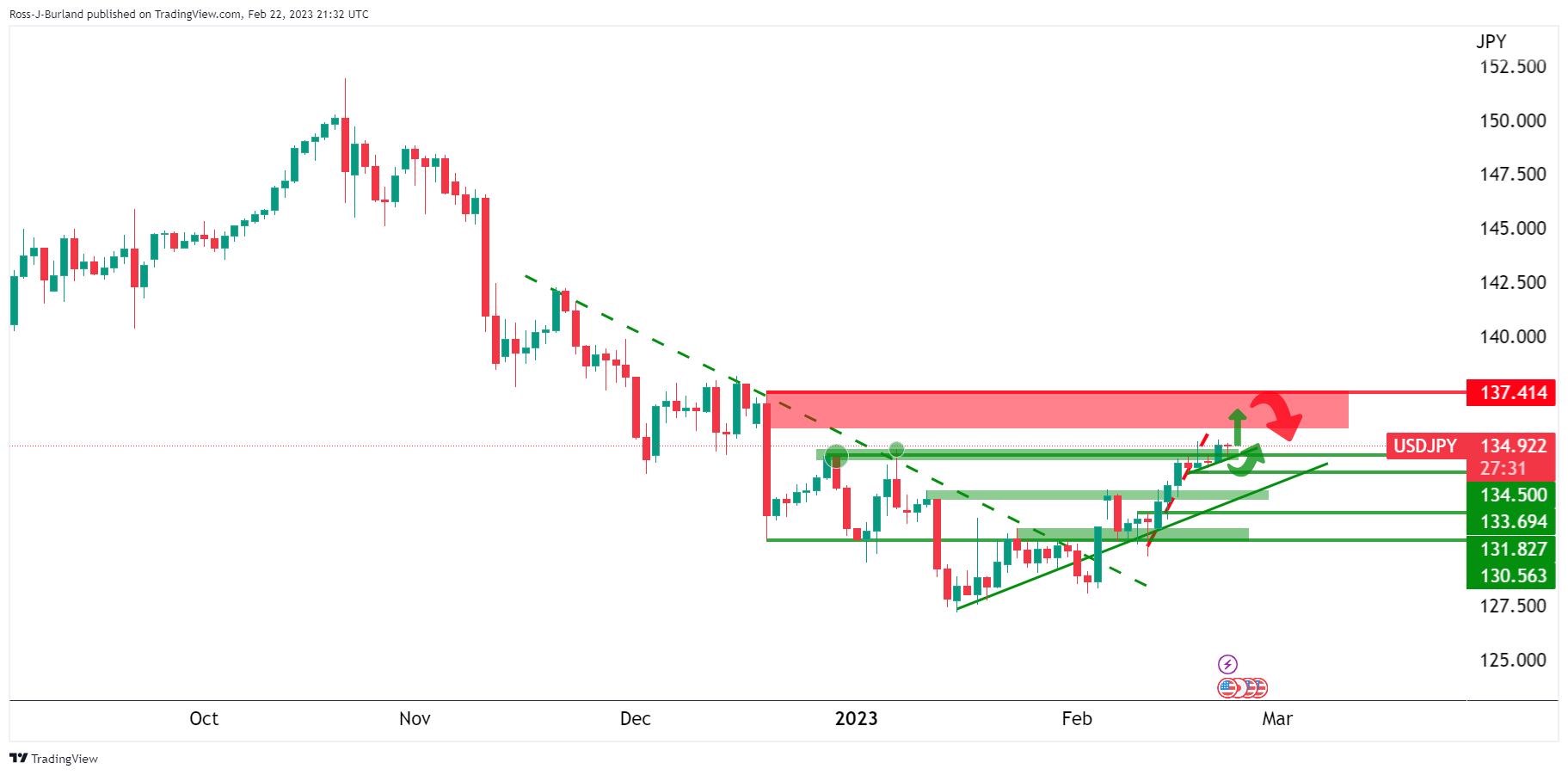
On the other hand, bears will be keen on a retest of the bull's commitments at 134.50 and should they break below with little fight from the bulls, then we could be looking at a very different scenario for the days and possibly weeks ahead:


The daily and weekly charts outline a bearish scenario if the bears really go to town on support and manage to get a weekly close below 134.50 this week or even next week.
- NZD/USD bears are in town on a stronger US Dollar.
- RBNZ struck a hawkish tone but US data dominates.
NZD/USD is bid by some 0.11% but pressured overall following the release of a hawkish set of Federal Open Market Committee minutes whereby a few participants had favoured raising rates by 50 basis points which has put a bid in the US Dollar but left the US Treasury Yield relatively stable.
''Markets have been forced to reprice interest rate expectations, not just higher, but also questioning the view that once peak rates are hit, central banks will pivot quickly to cutting interest rates,'' analysts at ANZ Bank said in a note on Thursday morning in Asia.
''The early 2023 indications are that economic activity is more resilient than data implied in Q4 and that monetary tightening is not yet bearing down on broader economic activity. Economic resilience is to be lauded, but central banks are uncomfortable with current levels of aggregate expenditure and labour market demand.''
''They need to stay hawkish and are not yet in a position to declare that interest rates are “sufficiently restrictive”. If the upcoming run of February data for the US confirm robust economic activity, it is difficult to see how risk will recover in the near term.''
Speaking of which, this week will provide The Fed’s favoured inflation measure, the PCE deflator. ''The market is expecting the January headline data to remain at 5.0% YoY, in line with the previous month,'' analysts at Rabobank said. ''This would strengthen concerns that the downtrend in inflationary indicators may have stalled.
Data in line with market expectations would thus add further weight to the view that the Fed will have to work harder to push inflation back to its target level. Currently implied market rates are pointing to a peak in Fed funds close to 5.33%.''
Domestically, the overall tone of the Reserve Bank of New Zealand's statement yesterday remained hawkish, and of note, they landed firmly on the side of economics rather than emotions, the analysts at ANZ Bank explained today.
''They also highlighted the longer-term inflationary risks surrounding cyclone recovery, which speak to stronger activity and a higher OCR. There isn’t enough information available just yet, but in time, that could play into NZD strength in upcoming meetings.''
- The minutes showed that some Federal Reserve officials wanted a 50 bps rate hike.
- Policymakers’ worries are linked to a tight labor market and commented inflation risks are tilted upwards.
- AUD/USD Price Analysis: Spiked towards 0.6830 before reversing its path to print a new weekly low of around 0.6801.
AUD/USD prolonged its losses during the Wednesday session and dropped nearby the day’s low of 0.6808 after the release of the Federal Open Market Committee (FOMC) minutes, which revealed that “few participants” favored a 50 bps rate hike. At the time of writing, the AUD/USD exchanges hands at 0.6826.
Summary of the FOMC’s minutes
The FOMC revealed in its minutes that some Federal Reserve policymakers wanted a more aggressive rate hike, with minutes citing that “a few participants favored raising rates by 50 bps.” Further, all the Fed board members agreed that more rate hikes are needed to achieve the Fed’s target and that balance sheet reduction would continue according to the plan.
Fed policymakers reiterated that inflation risks remain skewed to the upside, including China’s reopening and Russia’s invasion of Ukraine, reiterating that the labor market remains tight. Participants said the economic outlook is weighed on the downside, and some participants saw prospects of a recession in 2023.
AUD/USD Reaction to FOMC’s minutes
The AUD/USD 1-hour chart shows a spike towards 0.6832 before the AUD/USD reversed its course, breaching south of the S1 daily pivot point at 0.6825. It should be said that volatility has increased, and after reaching a low of 0.6808, as of late, the AUD/USD is tumbling sharply, eyeing a break below the 0.6700 mark.
AUD/USD 1-Hour chart
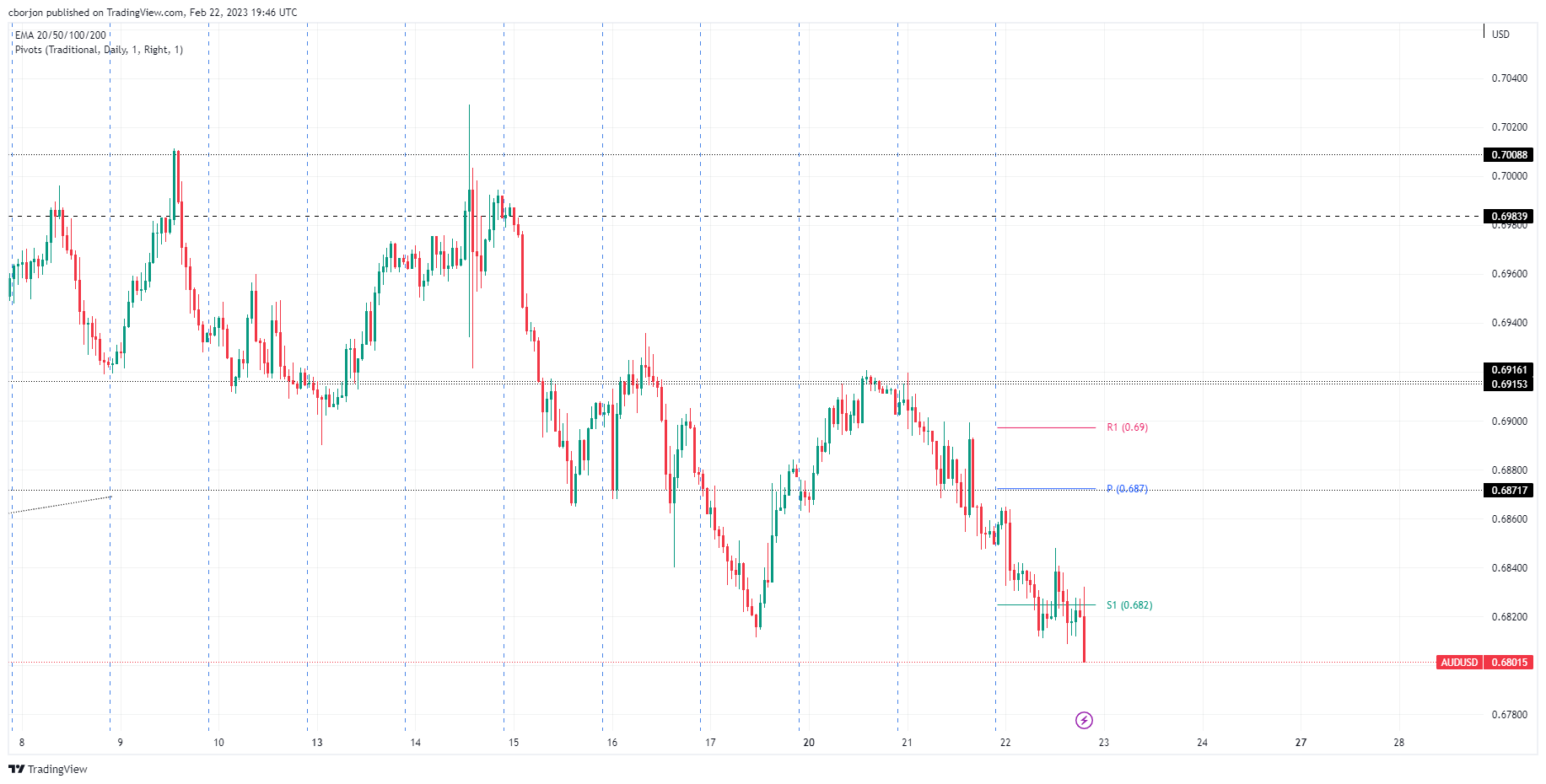
AUD/USD Key technical levels
- Gold price is in a bearish trend and the FOMC minutes have fuelled a sell-off.
- Gold price's weekly chart shows support near the 78.6% Fibonacci retracement level at $1,807.
Gold price is under pressure by some 0.3% on the day and remains in the hands o the bears following the first Federal Open Market Committee Minutes of 2023.
The minutes were released whereby investors have been searching for further insights into the near-term path for policy and any comments regarding the possibility of the Federal Reserve going back to 50 bps hikes. The minutes showed that a few participants had favoured raising rates by 50 basis points which has put a bid in the US Dollar but left the US Treasury Yield relatively stable. This has left the Gold price somewhat pressured around the low of the day near $1,825.54 after the yellow metal fell from a high of 41,846.05 earlier in the day.
FOMC minutes key notes
- A few participants favoured raising rates by 50 basis points.
- All participants agreed more rate hikes needed to achieve Federal Open Market Committee's job, inflation objectives.
- Participants said restrictive monetary policy needed until Fed confident inflation falling to 2%; added that process likely to take 'some time'.
- All participants favored further fed balance sheet reductions under current plan.
- Participants said uncertainty associated with outlooks for economy, job market and inflation was 'high'.
- Participants saw upside risks for inflation, including china's economic reopening and Russia's war in Ukraine.
- Participants said risks to economic outlook weighted to downside.
- A number of participants said drawn-out US debt limit process could pose 'significant risks' to the financial system, economy.
- Participants said job market 'very tight,' labor demand outstripping available supply.
- Participants said continued tight job market would contribute upward pressure to inflation.
- Participants said inflation in last three months has eased, but they need to see more progress.
- Some participants saw elevated prospect of recession in 2023.
Meanwhile, analysts at Rabobank noting the recent strength of recent economic data, explained that current remarks of Fed officials may be more forthcoming in terms of providing clues for the next FOMC meeting on March 23, than the February 1 minutes.
In this regard, St. Louis Fed President James Bullard reinforced the hawkish sentiment ahead of the Fed minutes on Wednesday. Bullard said that the Fed has to get inflation on to a sustainable path down toward its 2% goal this year or risk a repeat of the 1970s, when interest rates had to be repeatedly ratcheted up. '
Looking ahead for the rest of the week, in terms of forthcoming data releases, the market consensus is pointing to strength in the personal consumption and spending data signalling robust domestic demand. ''The Fed’s favoured inflation measure, the PCE deflator, is also due for release this week,'' analysts at Rabobank explained.
''The market is expecting the January headline data to remain at 5.0% y/y, in line with the previous month. This would strengthen concerns that the downtrend in inflationary indicators may have stalled. Data in line with market expectations would thus add further weight to the view that the Fed will have to work harder to push inflation back to its target level. Currently implied market rates are pointing to a peak in Fed funds close to 5.33%.''
Gold technical analysis

Gold price's weekly chart shows support near the 78.6% Fibonacci retracement level at $1,807. The market is on the backside of the prior bullish trend and on the front side of the bear trend as illustrated above, thus offering a bearish bias to the said and shown support structure.
What you need to take care of on Thursday, February 23:
The US Dollar maintained its hawkish bias, accelerating its advance by the end of the American session and following the Federal Open Market Committee (FOMC) Meeting Minutes. The document showed that a few participants favored a 50 basis point (bps) rate hike, while some believed there was an elevated risk of a recession in 2023. More relevant, all participants agreed more rate hikes are needed to achieve the inflation target while also favor further Fed balance sheet reductions. Finally, participants stated that the continued tight job market would continue to put upward pressure on inflation.
Mid-US session, St. Louis Federal Reserve President James Bullard said more aggressive interest rate hikes now would give the FOMC a better chance to tame inflation, adding he believes there are good chances they could beat inflation this year without creating a recession.
Stock markets, in the meantime, suffered from geopolitical tensions throughout the day, dipping further in the red with the FOMC statement. China’s top diplomat, Wang Yi, said on Wednesday that his nation is ready to deepen strategic cooperation with Moscow adding their relationship will not succumb to pressure from other countries. Russian President Vladimir Putin, on the other hand, highlighted the relevance of cooperation with China, adding he is looking forward to Chinese President Xi Jinping visiting Moscow.
The EUR/USD pair flirts with the 1.0600 level by the end of the American session. Earlier in the day, In Europe, Deutsche Bank lifted its forecast on the European Central Bank (ECB) terminal rate to 3.75% from 3.25% previously. ECB Governing Council member Francois Villeroy de Galhau, however, noted that the central bank is not obliged to raise borrowing costs at every meeting, as the deposit rate is already at restrictive levels, suggesting financial markets may have overshot when betting on the ECB rates’ peak.
GBP/USD trades at around 1.2050. AUD/USD defies the 0.6800 mark, while USD/CAD hovers around 1.3550. Finally, USD/JPY remains stable, just below the 135.00 level.
Spot gold collapsed ahead of FOMC Meeting Minutes and trades around $1,826 a troy ounce. Crude oil prices also edged sharply lower, with WTI now changing hands at $73.90 a barrel.
Assessing the chances of a Bitcoin price pullback due to FOMC minutes
Like this article? Help us with some feedback by answering this survey:
The Reserve Bank of New Zealand's governor, Adrian Orr has said that core inflation is too high and that expectations are elevated.
The top central banker is speaking at the Finance and Expenditure Committee on points related to the February Monetary Policy Statement.
Key notes
- Rebuild activity may add to inflationary pressure.
- Monetary conditions need to tighten further.
More to come...
The first FOMC Minutes of 2023 has been released with investors searching for further insights into the near-term path for policy and any comments regarding the possibility of the Federal Reserve going back to 50 bps hikes.
Key notes from FOMC minutes
A few participants favoured raising rates by 50 basis points.
All participants agreed more rate hikes needed to achieve Federal Open Market Committee's job, inflation objectives.
Participants said restrictive monetary policy needed until Fed confident inflation falling to 2%; added that process likely to take 'some time'.
All participants favored further fed balance sheet reductions under current plan.
Participants said uncertainty associated with outlooks for economy, job market and inflation was 'high'.
Participants saw upside risks for inflation, including china's economic reopening and Russia's war in Ukraine.
Participants said risks to economic outlook weighted to downside.
A number of participants said drawn-out US debt limit process could pose 'significant risks' to the financial system, economy.
Participants said job market 'very tight,' labor demand outstripping available supply.
Participants said continued tight job market would contribute upward pressure to inflation.
Participants said inflation in last three months has eased, but they need to see more progress.
Some participants saw elevated prospect of recession in 2023.
US Dollar and Treasury Yields update
The US Dollar ran higher from a new low at 104.25 in the NY session in anticipation of a hawkish outcome ad sat at 104.35 moments ahead of the release.
DXY is moving up to fresh highs on the prospects of a 50bp rate hike next time around. However, the price action is volatile and bears are fading bullish attempts within the first 15 min candle:
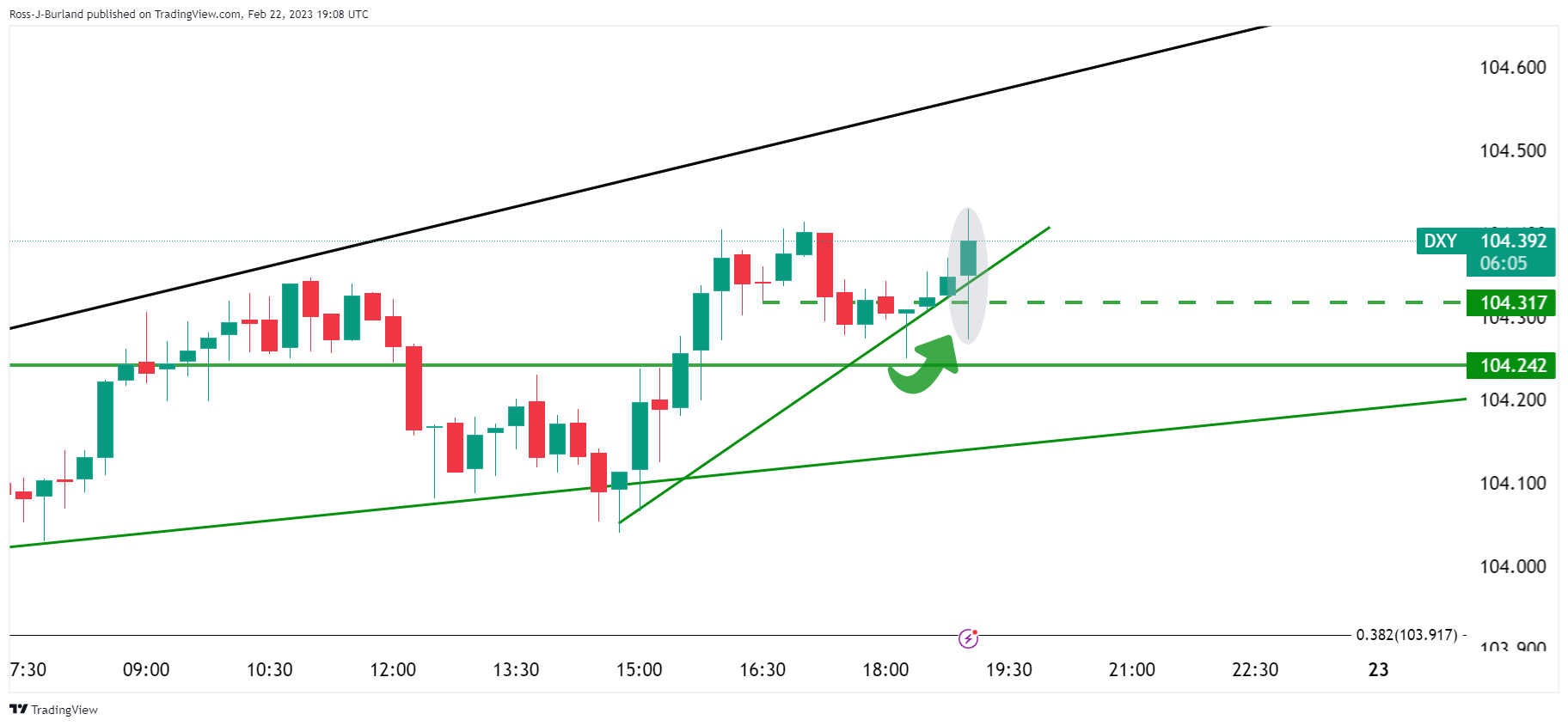
About the FOMC minutes
FOMC stands for The Federal Open Market Committee which organizes 8 meetings in a year and reviews economic and financial conditions, determines the appropriate stance of monetary policy and assesses the risks to its long-run goals of price stability and sustainable economic growth. FOMC Minutes are released by the Board of Governors of the Federal Reserve and are a clear guide to the future US interest rate policy.
- Western Texas Intermediate remains under pressure from a strong US Dollar.
- Expectations that the Fed would tighten further than expected reignited.
- Russia’s cutting oil production and China’s reopening are a tailwind for WTI.
Western Texas Intermediate (WTI), the US crude oil benchmark, is losing more than 2.50% on Wednesday, as investors remain uneasy on upbeat US economic data that could warrant further tightening by the Federal Reserve. Hence, WTI is trading at $73.97 per barrel, down by 2.86%.
The Federal Reserve Open Market Committee (FOMC) will reveal the minutes of their first reunion of 2023. Recent hawkish rhetoric by Fed officials is eyed by traders, who would like to assess how many members of the FOMC were open to considering a 50 bps rate hike.
Given the backdrop, speculations for a higher terminal rate for the Federal Funds Rate (FFR) bolstered the US Dollar (USD), as shown by the US Dollar Index advancing 0.23%, at 104.335. investors should be aware that WTI, denominated in US Dollars, would be more expensive for holders of other currencies, explaining WTI’s fall during the session.
China’s reopening continued to cap WTI losses on Wednesday due to an expected increase in oil demand. According to Morgan Stanley, global oil demand would grow by about 36%, based on China’s removal of Covid-19 restrictions.
Furthermore, Russia’s cutting its oil output by 500K bpd would likely keep oil prices underpinned.
WTI Technical analysis
From a technical perspective, WTI is neutral-to-downward biased, unable to dip below the $70.00 barrier, the YTD low. Momentum indicators remain bearish, namely the Relative Strength Index (RSI) and the Rate of Change (RoC); hence another leg-down is expected. WTI’s first support would be $74.00. Break below will expose the MTD low at $72.30, followed by the YTD low at $70.10.
In an alternate scenario, if WTI reclaims the 20-day Exponential Moving Average (EMA) at $77.41, that could pave the way for further upside.
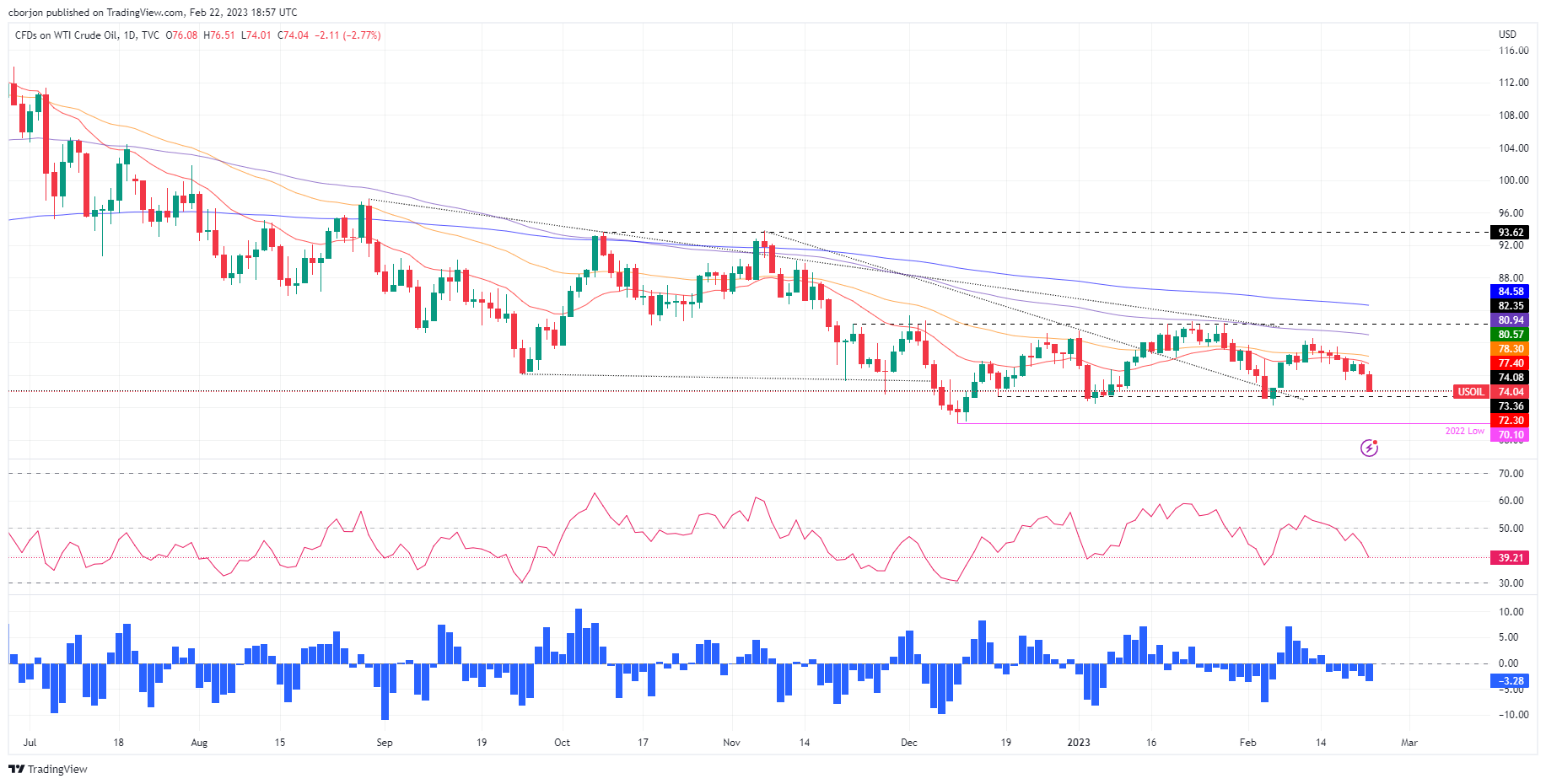
- DXY is on the move to the upside ahead of the FOMC minutes.
- Supported by a 38.2% Fibonacci on the daily chart, the 105.20s territories are eyed.
The US Dollar moved up on Wednesday as measured by the DXY index vs. a basket of currencies as traders get set for the Federal Open Market Committee minutes following a slew of strong economic data of late. At the time of writing, DXY is trading at 104.30 and it has ranged between a low of 104.006 and a high of 104.415 so far.
The FOMC February meeting minutes will provide further insights into the near-term path for policy but the Fed funds futures traders are now pricing the fed funds rate to reach 5.35% in July, and remain above 5% all year. The Fed's target range stands at 4.5% to 4.75%, having climbed strongly from 0% to 0.25% in March 2022.
The US data of late has eased recession fears but it has also reinforced worries that the Fed needs to stay higher for longer in terms of its interest rate hiking path. On top of a slew of past data, the latest survey data released on Tuesday showed US business activity unexpectedly rebounded in February to reach its highest in eight months and St. Louis Fed President James Bullard reinforced the hawkish sentiment ahead of the Fed minutes on Wednesday.
Bullard said that the Fed has to get inflation on to a sustainable path down toward its 2% goal this year or risk a repeat of the 1970s, when interest rates had to be repeatedly ratcheted up. ''Given the strength of recent economic data, current remarks of Fed officials may be more forthcoming in terms of providing clues for the next FOMC meeting on March 23, than the February 1 minutes,'' analysts at Rabobank said.
''In terms of forthcoming data releases, the market consensus is pointing to strength in the personal consumption and spending data later in the week signalling robust domestic demand. The Fed’s favoured inflation measure, the PCE deflator, is also due for release this week,'' the analysts explained further.
''The market is expecting the January headline data to remain at 5.0% YoY, in line with the previous month. This would strengthen concerns that the downtrend in inflationary indicators may have stalled. Data in line with market expectations would thus add further weight to the view that the Fed will have to work harder to push inflation back to its target level.''
US Dollar index technical analysis
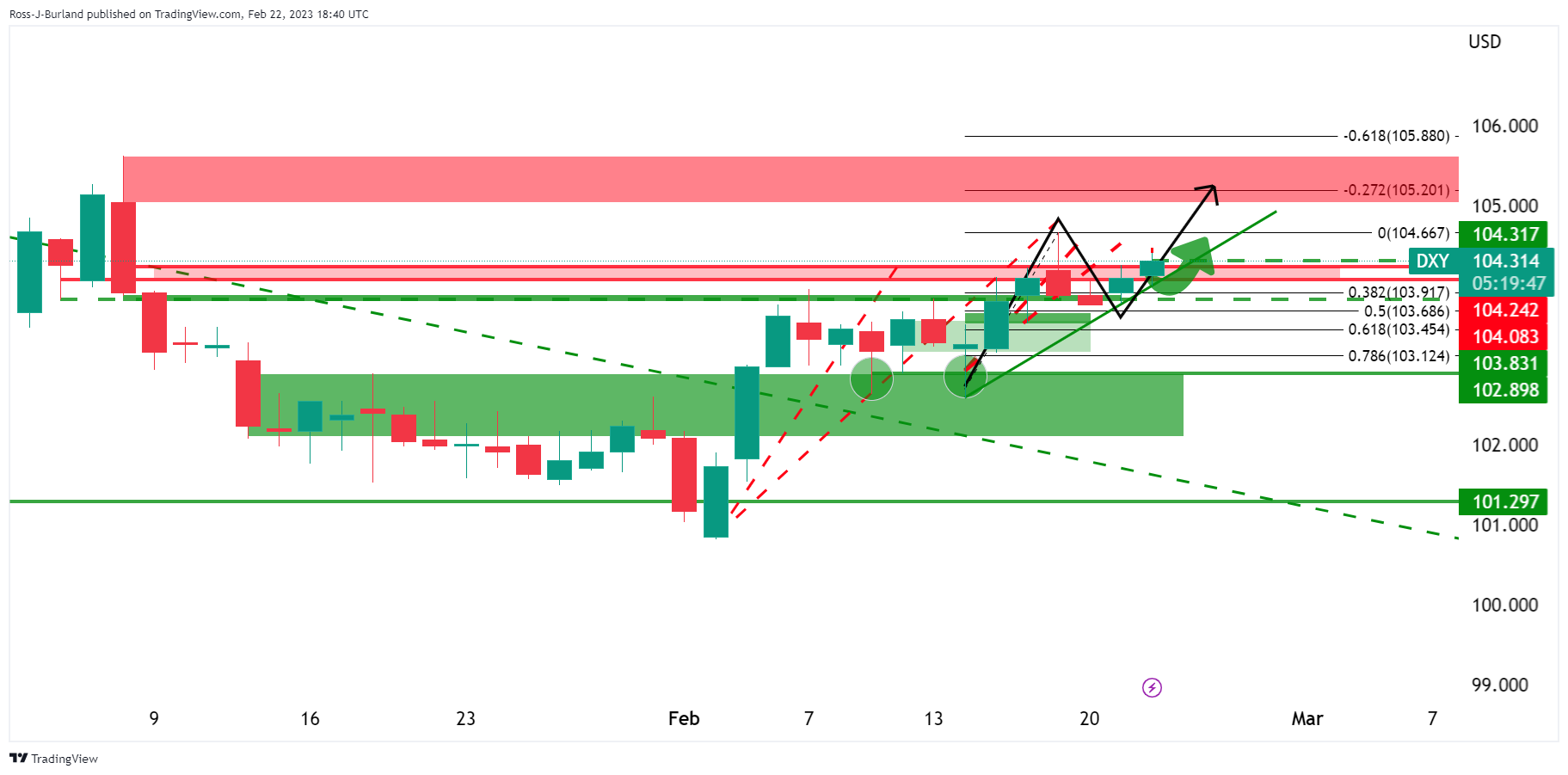
The index has been climbing along trendline support and has moved up from the correction into the 38.2% Fibonacci on the daily chart. A continuation through current resistance opens risk to test the 105.20s territories.
- GBP/USD bears eye a 50% mean reversion to test into the 1.2030s.
- Bulls could commit to the 38.2% support in the lows for the day so far, 1.2055.
As per the prior analysis, GBP/USD Price Analysis: Bulls spring to life on backside of bear trend, GBP/USD rallied through a key resistance area on the daily chart and it is now using this as a support zone as traders await the minutes from the Federal Open Market committee.
The US Dollar gained modestly on Wednesday due to a slew of recent strong economic data that while easing recession fears, the data has reinforced concerns that the Federal Reserve’s stance will remain hawkish for longer which is capping progress in the Pound vs. the US Dollar.
GBP/USD prior analysis
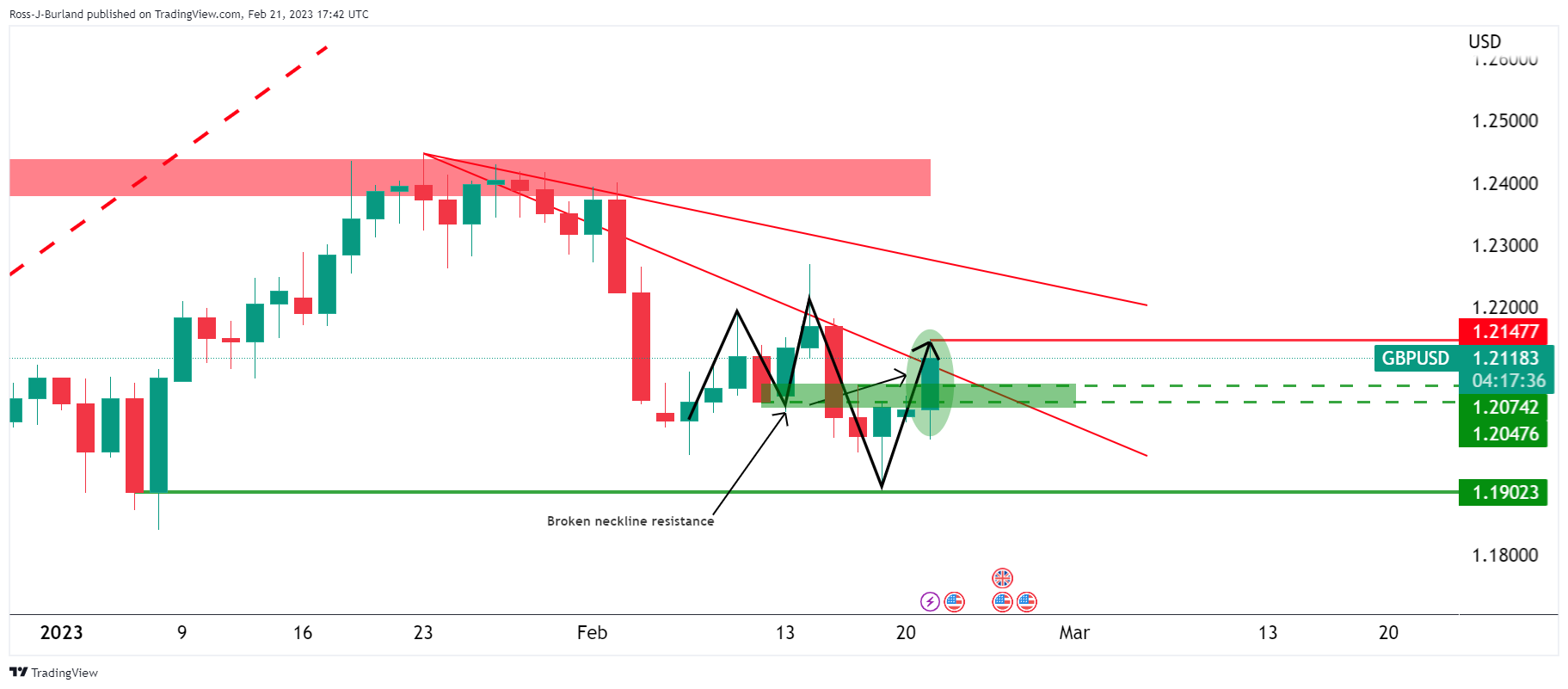
The M-formation's neckline was broken on Tuesday, invalidating a bearish thesis from the start of the week's analysis:
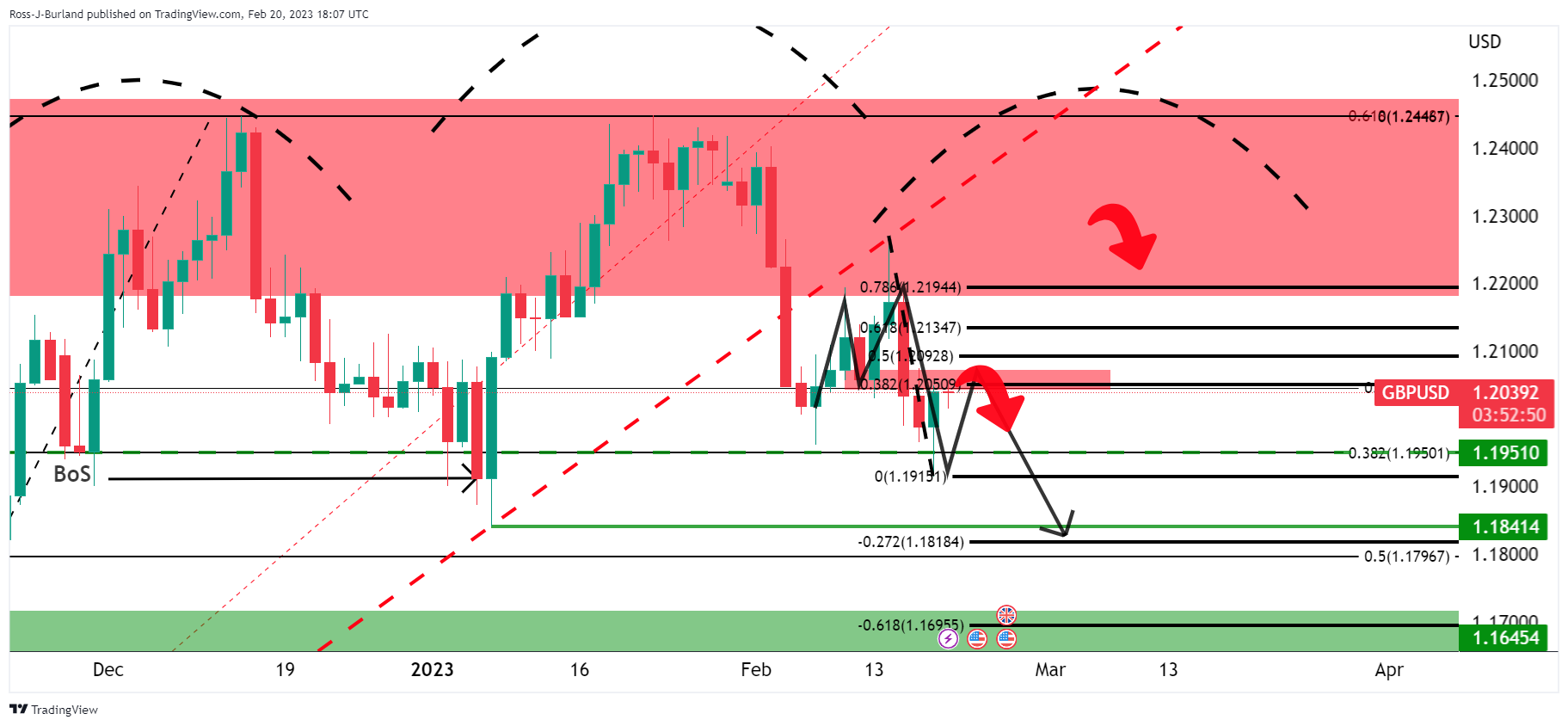
The bulls were in control and needed to rely on the 1.2070s as a possible newly formed support structure as illustrated below:
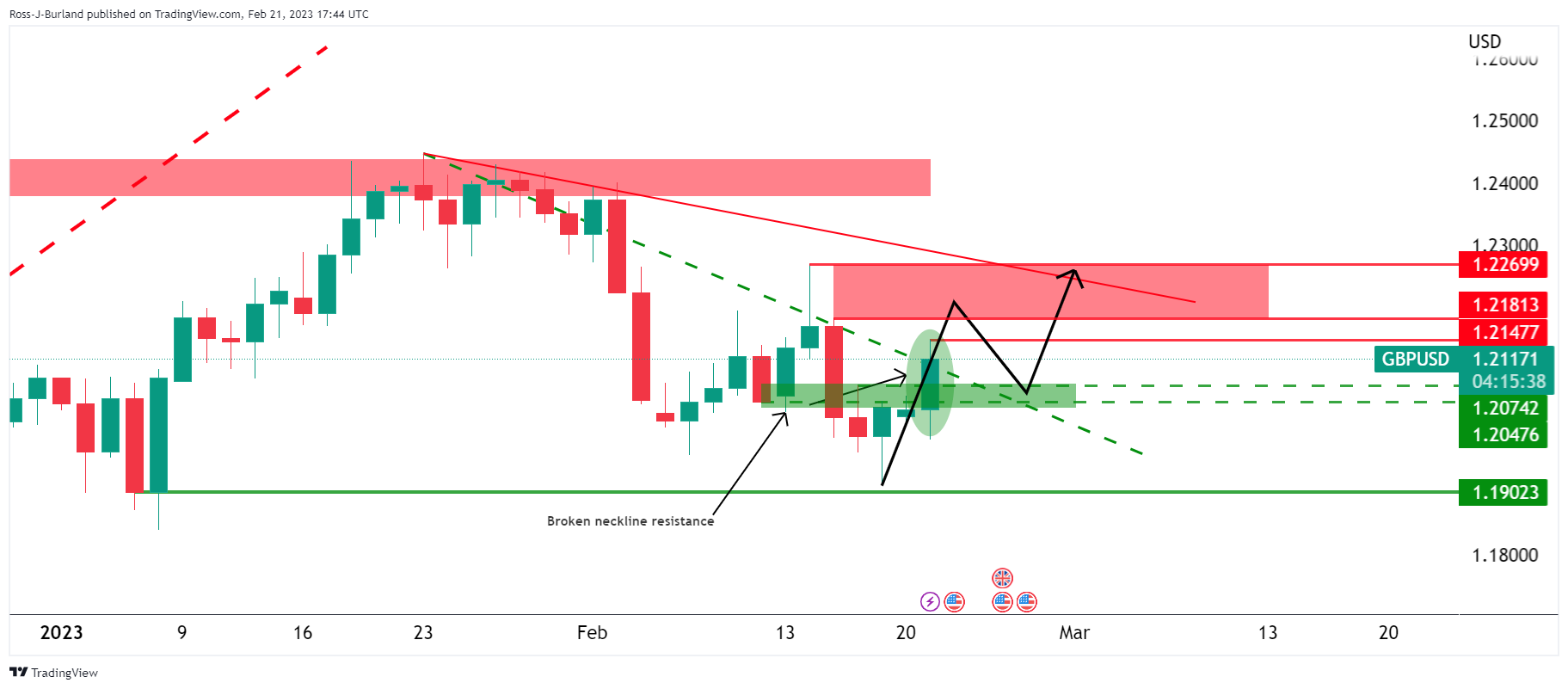
1.2270 was eyed as an upside target for the days ahead of the market and does not just remain in a consolidative structure bounded by 1.1900 and 1.2150.
GBP/USD update


The price is holding in the presumed support area and a 50% mean reversion is on the cards to test into the 1.2030s if the 38.2% does not hold first in the lows for the day so far, 1.2055.
- USD/CAD collides with solid resistance and retreats to its 1.3520s lows.
- Traders are bracing for additional forward guidance from the US Federal Reserve.
- If the BoC pauses, the USD/CAD will extend its gains.
The USD/CAD is barely unchanged ahead of the FOMC’s minutes release, though slightly tilted to the downside, with losses of 0.05%. Traders worried that the Fed would raise rates further than expected, dampening the market mood during the last couple of weeks. At the time of typing, the USD/CAD is trading at around 1.3530s.
USD/CAD turns negative, drops 0.06%, before FOMC’s minutes release
Wall Street’s bulls are taking a respite before the Fed releases its minutes. US economic data throughout the last two weeks justified the need for further tightening, meaning a higher USD/CAD exchange rate. Inflation data in the US slowed down, except for the monthly readings of the Producer Price Index (PPI), which came above estimates and the prior’s month data. In addition, a Fed regional manufacturing index reported on its survey that prices jumped the most in 10 months, exacerbating a reassessment of how high the Fed will go. Therefore, worried investors turned to safety and bought the US Dollar (USD).
Consequently, the US 10-year Treasury bond yield spiked 40 basis points (bps) and underpinned the greenback.
Aside from this, the Canadian side revealed that inflation cooled down, a sign for the Bank of Canada (BoC) to pause its hiking cycle. Meanwhile, New Home Prices in Canada dived 0.2% in January from December data from Statistics Canada showed on Wednesday, but the annual rate slowed to 2.7%.
Hence, the USD/CAD broke above 1.3500 after trading sideways for almost two months. Nevertheless, the major faced a four-month-old resistance trendline and was rejected after hitting multi-week highs at 1.3560 and dropping toward 1.3520s.
What to watch?

USD/CAD Key technical levels
- Silver price clashed with the 200-day EMA and retreated afterward.
- If XAG/USD dives below $21.50, a test of the YTD low at $21.18 is on the cards.
- Oscillators turned bearish, opening the door for Silver’s further downside.
Silver price battles at the 200-day Exponential Moving Average (EMA) at $21.93 though it failed to crack the latter and retraced towards Tuesday’s lows as the North American session progressed. Investors awaiting the latest FOMC minutes sought safety in the US Dollar (USD), a headwind for the white metal. At the time of typing, the XAG/USD is trading at $21.62, down 0.70% in the day.
From a daily chart perspective, XAG/USD remains neutral to downward biased, as the white metal stays beneath the important 200-day EMA. Wednesday’s price action remains negative, while the Relative Strength Index (RSI) and the Rate of Change (RoC) indicate that sellers are gathering momentum.
The XAG/USD 4-hour chart portrays the white metal as neutral to downward on an intraday bias. As of typing, Silver has breached the daily pivot point at $21.81, followed by the S1 pivot at $21.66. A bearish continuation is the most probable scenario due to several reasons. The Relative Strength Index (RSI) dived below the 50-mid line, a signal to go short, while the Rate of Change (RoC) is aiming aggressively downwards.
Therefore, the XAG/USD first support would be the S2 pivot point at $21.50. A breach of the latter will expose the S3 daily pivot at $21.35, ahead of the YTD low of $21.18. As an alternate scenario, XAG/USD reclaims the 200-day EMA could pave the way toward $22.00.
XAG/USD 4-hour chart
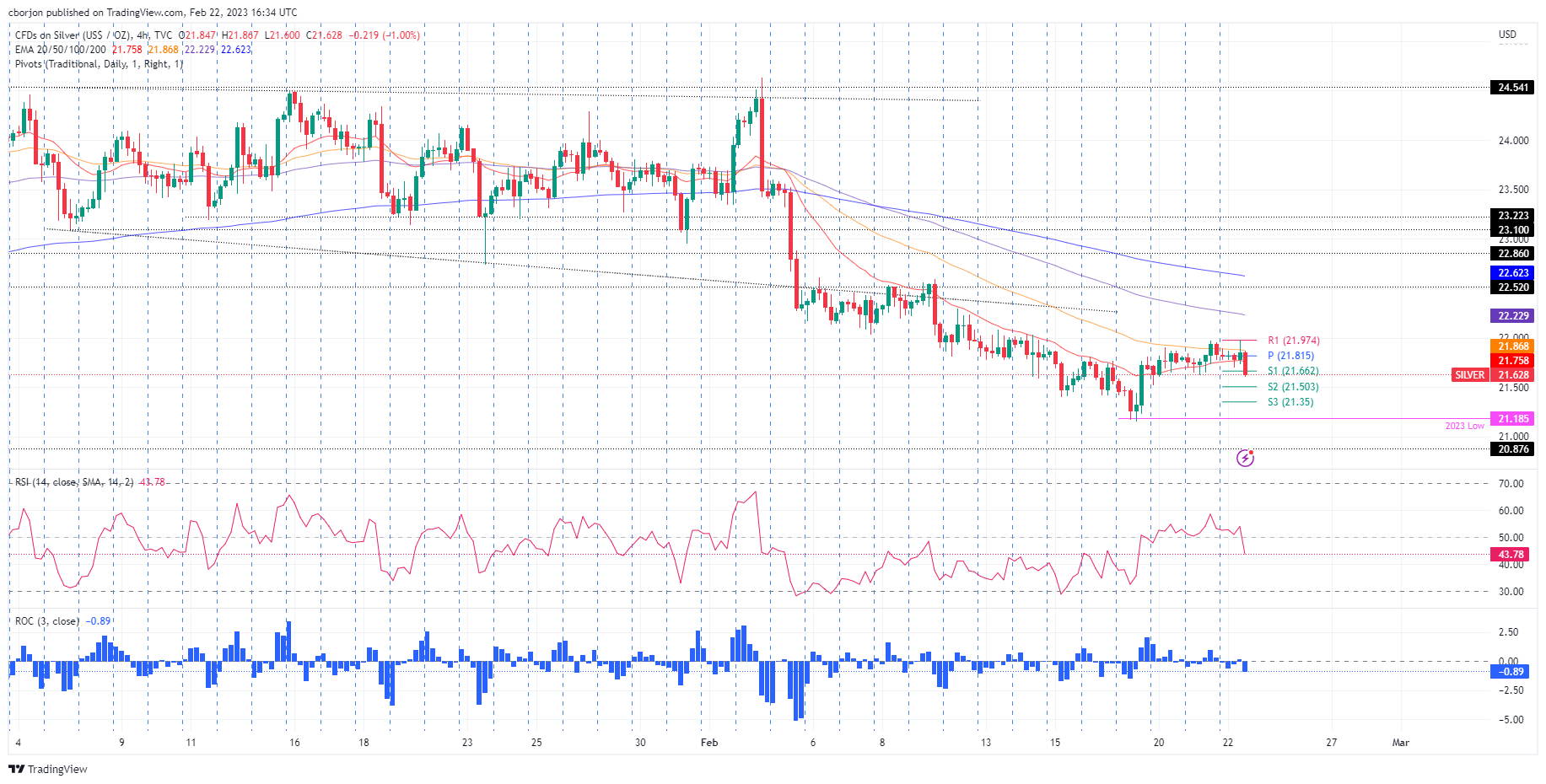
XAG/USD Key technical levels
Analysts at MUFG Bank have a neutral bias for the USD/JPY pair and they see it trading in the 128.00 – 138.00 range over the next weeks. They affirm that market attention is set to intensify again in the month ahead over potential shifts at the Bank of Japan ahead of Governor Kuroda’s final meeting.
Maintaining our neutral USD/JPY bias for the month ahead
“Stronger US growth and firmer inflation at the start of the year have also provided a more solid external backdrop for USD/JPY and will make a break back below the 130.00-level a tougher nut to crack in the near-term. On the topside the next important resistance level is provided by the 200-day moving average that comes in at just below the 137.00-level. After weighing up risks from the repricing of BoJ and Fed policy outlooks, we are maintaining our neutral USD/JPY bias for the month ahead.”
“Risks appear more titled to the upside for USD/JPY in the near-term. After finding good support at around the 130.00-level over the past month, the pair is moving back towards the 200-day moving average at just below the 137.00-level. A break above the 137.00-level could open the door to a more extended rebound. Potential fundamental triggers for a higher USD/JPY include: i) the Fed displaying more concern over persistent inflation risks and the lack of slowdown in the US labour market prompting it to signal that rates need to rise even further above 5.00%, and or ii) the new BoJ governor signaling a stronger desire to leave policy settings unchanged for longer until at least a comprehensive assessment of policy has been conducted.”
- Mexican Peso outperforms among emerging market currencies.
- USD/MXN holds near multi-year lows, despite risk aversion and higher US yields.
- Strong support emerges around 18.30 while critical resistance seen at 18.50.
The USD/MXN reversed after reaching a daily high near 18.50 and dropped to 18.35, matching the lowest level since 2018. The pair continues to move with a bearish bias despite risk aversion.
Looking at the FOMC minutes
Market participants await the outcome of the minutes from the latest FOMC meeting. They will look for clues about the future of US monetary policy.
Ahead of the minutes, the US dollar holds firms in the market supported by higher US yields and risk aversion. The latest round of economic numbers showed an unexpected recovery in the service sector, favoring expectations of a hawkish Fed.
Despite higher US yields, a firmer dollar and a deterioration in market sentiment, the Mexican Peso continues to rise versus the greenback. Among emerging market currencies, the MXN is one of the best performers of the last week and also over the last 30 days.
The Mexican Peso is receiving support from Banxico which is seen raising rates again at the next meeting after a hawkish surprise at the latest board meeting.
Key levels
Bias in USD/MXN continues to be tilted to the downside. The area around 18.30 is the key support. A break lower could open the doors for a slide toward 18.00. A recovery above 18.50 should alleviate the bearish pressure.
Technical levels
Strategists at Commerzbank have adjusted their Gold price forecast. They now expect XAU/USD to slump toward $1,800 in the first half of the year before drifting back higher toward $1,950 by year-end.
Gold likely to remain under pressure in the short term
“In the short term, the Gold price is likely to remain under pressure due to continued robust US economic activity and only slowly falling inflation, both supporting US interest rate hike expectations.”
“As soon as an end to US interest rate hikes becomes apparent, the precious metal's attractiveness should slowly increase again. This will be all the more the case if it becomes clear that the Fed will have to take back some of its interest rate hikes again.”
“We have lowered our forecasts for the first half of the year from $1,850 to $1,800. However, we remain optimistic for the second half of the year and continue to expect a gradual increase towards $1,950.”
Source: Commerzbank Research
On Thursday, the Bank of Korea meets and it is expected to stand pat. Economists at Société Générale expect the Won to struggle.
BoK to keep the key 7-day repo rate unchanged at 3.50%
“We expect the BoK to keep the key 7-day repo rate unchanged at 3.50% tomorrow. However, the board members’ view of terminal rate is likely to be evenly split between 3.50% and 3.75%. This may not be of much help to the currency.”
“For USD/KRW, an extension towards 1,320 could be on the cards if the FOMC minutes are hawkish and US PCE causes more inflation jitters on Friday.”
See – BoK Preview: Forecasts from four major banks, first pause in a year
- Gold remains firm at around $1,835, with traders awaiting Fed minutes.
- Money market futures began to price in interest rates in the US in the 5.25%-5.50%.
- Gold Price Analysis: Range-bound, trapped within the 50/100-DMA.
Gold price recovers some ground, though it remains almost flat compared to its opening price. However, it clings to minimal gains before the release of the US Federal Reserve’s (Fed) last monetary policy meeting minutes. At the time of writing, the XAU/USD is trading at $1,835.10 a troy ounce.
Financial markets await the FOMC’s last meeting minutes
US equities bounced at the Wall Street open, but traders remained cautious amidst growing speculations that the Fed would turn more hawkish than expected. Money market futures are projecting 75 bps of additional tightening, as seen in the CME Fed Watch Tool. Nevertheless, US Dollar (USD) bulls are taking a respite, with the US Dollar Index (DXY) edging lower by 0.07% at 104.088, undermined by US bond yields, mainly the 10-year benchmark note rate down five basis points (bps), at 3.900%.
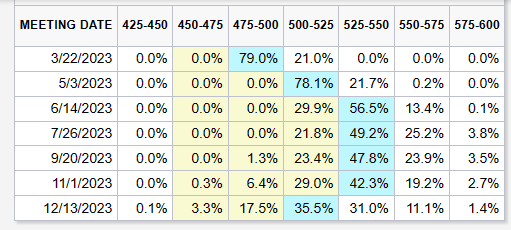
Source: CME FedWatch Tool
The economy in the United States is solid, justifying Fed official’s hawkish rhetoric
Tuesday’s data release, particularly S&P Global PMI for February, showed that business conditions in the United States (US) are improving, with both the Services and Composite PMIs exceeding estimates and expanding territory. The outlier was the Manufacturing Index, which improved but stood in a contractionary area.
US PMIs data summed up to last week’s inflation and justifies the need for additional rate hikes from the Fed, whose officials led by the Cleveland and St. Louis Fed Presidents Loretta Mester and James Bullard, stated that there was compelling evidence to raise rates by 50 bps on February’s one meeting.
What to watch?

Gold technical analysis
XAU/USD’s daily chart suggests the yellow metal consolidated after hitting a daily high of $1,846.09. Nevertheless, failure to pierce the weekly high at $1,847.45 could pave the way for further downside, but the release of the Fed’s minutes could rock the boat and trigger upward/downward movements in the yellow metal. Oscillators aim downward, namely the Relative Strength Index (RSI) and the Rate of Change (RoC).
Therefore, the XAU/USD first support would be the 100-day Exponential Moving Average (EMA) at $1,820.59, followed the last week’s low of $1,818.97. A breach of the latter will expose the 200-day EMA at the $1,803.04 mark.
As an alternate scenario, a break above $1,847.45 and the XAU/USD’s next target would be $1,850, immediately followed by the 50-day Exponential Moving Average (EMA) at $1,852.50 and the 20-day EMA at $1,862.52.
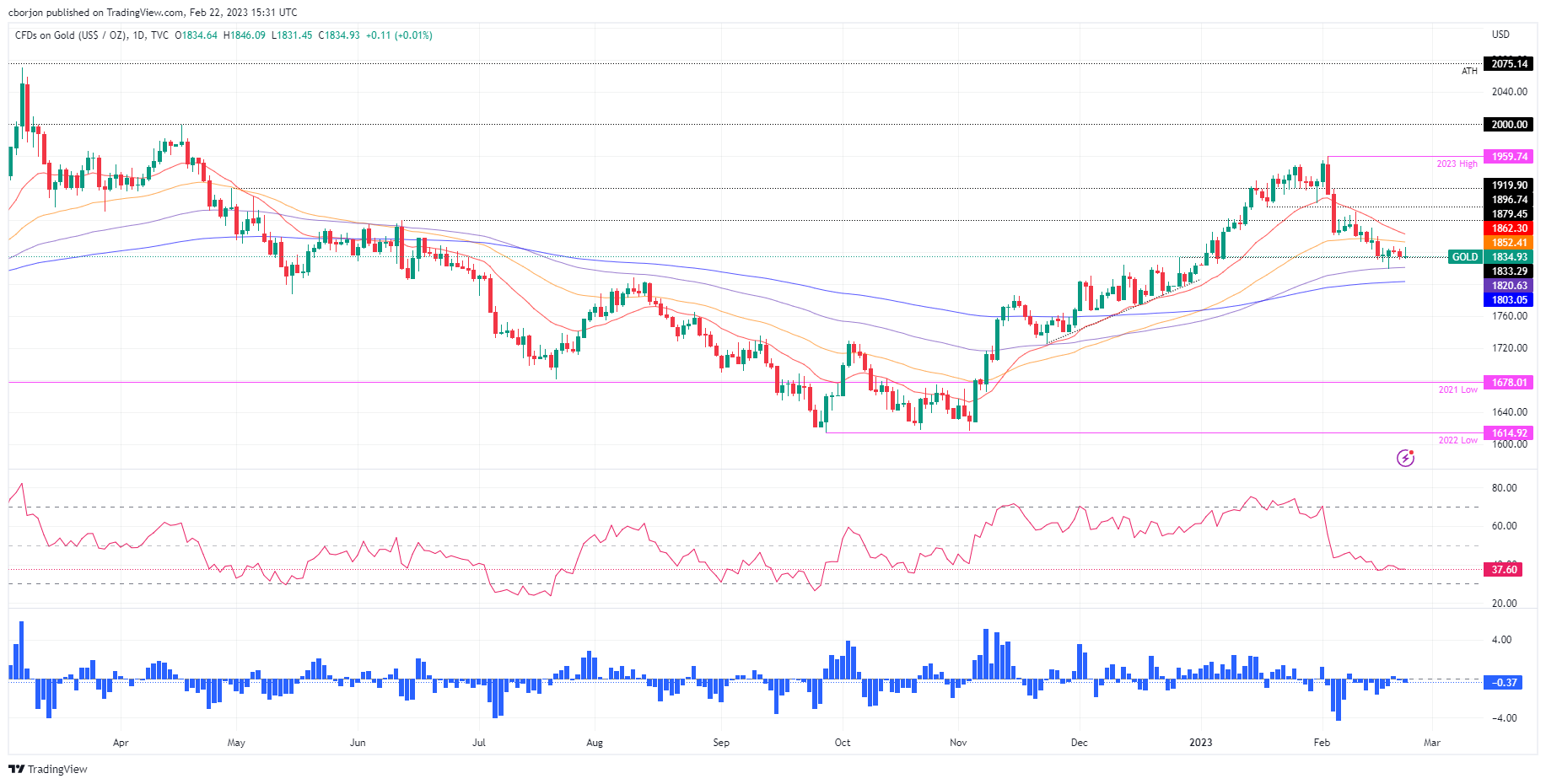
USD trades narrowly mixed. Shaun Osborne, Chief FX Strategist at Scotiabank, believes that a hawkish tone in FOMC Minutes could propel the Dollar.
USD set to gain a little ground in the near-term
“I’m still leaning towards the idea of the USD gaining a little ground in the near-term.”
“There are no major data releases scheduled for North America today. However, the Fed releases the Feb 1 FOMC minutes. The chances of the pace of policy tightening picking up again are low but a hawkish undertone to the minutes (more support for bigger hikes or a developing sense from policymakers that they view policy peaking at a slightly higher point) will bolster expectations that the Fed cycle will extend beyond 5.25% into mid-year and lift the USD.”
- FOMC minutes at the center stage, market participants await Fed’s clues.
- Japanese Yen among top performers on Wednesday as US yields pull back.
- USD/JPY unable to hold above 135.00, slides and losses momentum.
The USD/JPY is falling on Wednesday, retreating after hitting on Tuesday at 135.22, the highest level since mid-December. The pair bottomed at 134.35. It is hovering around 134.50/60 as market participants await the minutes from the latest FOMC meeting.
Bullish, limited by 135.00 ahead of the Fed
Again, the pair was rejected from above 135.00. It remains bullish in the short-term even despite some risk aversion. Recent US data has been supporting the perspective of a hawkish Fed, sending US yields to the upside, and hence, supporting the dollar.
At 19:00 GMT, the Federal Reserve will release the minutes of their latest monetary policy meeting in February 1. At that meeting, the Fed slowed down and raised rates by 25 basis points. Comments from Fed’s officials could trigger volatility across the board, although a lot had happen since early February and the minutes could be outdated.
As market participants continue to expect a hawkish Fed, policy normalization from the Bank of Japan is seen later this year, particularly after governor Kuroda’s last meeting on March 10. Some do not rule out a surprise.
“Although the USD is finding support on the market’s acceptance that Fed rates will likely stay higher for longer on the back of resilience in the US economy, we see potential for USD/JPY to edge moderately lower on a 12 month view on the assumption that the BoJ makes some cautious steps towards reversing its ultra-accommodative policy”, wrote Rabobank’s analysts. They see scope for the USD/JPY to move to 125 on a 12 months view.
Technical levels
The Reserve Bank of New Zealand (RBNZ) hiked interest rates by 50 basis points to 4.75%. Economists at TD Securities now forecast a 5.50% peak by July.
5.50% Terminal
“The RBNZ retained its focus on the medium-term outlook and hiked its cash rate 50 bps as expected, but a 75 bps hike was considered as the alternative option.”
“Our new call has us forecasting the RBNZ hiking the OCR an additional 50 bps, in 25 bps clips at its May and July meetings, taking terminal to 5.50%.”
USD/JPY is expected to move downward over the coming months. Economists at Rabobank see the pair at 125 on a 12-month view.
USD/JPY to edge moderately lower on a 12-month view
“Although the USD is finding support on the market’s acceptance that Fed rates will likely stay higher for longer on the back of resilience in the US economy, we see potential for USD/JPY to edge moderately lower on a 12-month view on the assumption that the BoJ makes some cautious steps towards reversing its ultra-accommodative policy.”
“We see scope for USD/JPY to move to 125 on a 12-month view.”
Economists at ING remain doubtful that the Dollar has further to run on the Fed story. However, a resurgence in geopolitical risk means that defensive USD positions may linger.
USD helped by geopolitical uncertainty
“Markets will watch with great interest the content of the FOMC minutes today. With markets pricing in close to a 5.50% peak rate, we would essentially need to see evidence that multiple members voiced the desire to hike by 50 bps at the start of February. That would back the cause for a 50 bps move in March and likely lift the USD. However, the bar is set quite high after the recent hawkish comments, and we don’t see a very high chance of a hawkish surprise today.”
“The current instability in the geopolitical picture warrants caution and a bit more support to the Dollar may be on the cards, even though we see a good chance that the USD upside correction has peaked.”
- EUR/USD looks under pressure near the monthly lows.
- The resistance line around 1.0915 keeps capping the upside.
EUR/USD extends the side-lined trade and remains close to the February lows.
If sellers regain the upper hand, pair could slip back to the February low at 1.0612 (February 17) in the near term. The breach of this level could see a potential test of the 2023 low at 1.0481 (January 6) emerge on the horizon.
So far, extra losses remain on the cards as long as the 3-month resistance line, today near 1.0915, caps the upside.
In the longer run, the constructive view remains unchanged while above the 200-day SMA, today at 1.0329.
EUR/USD daily chart
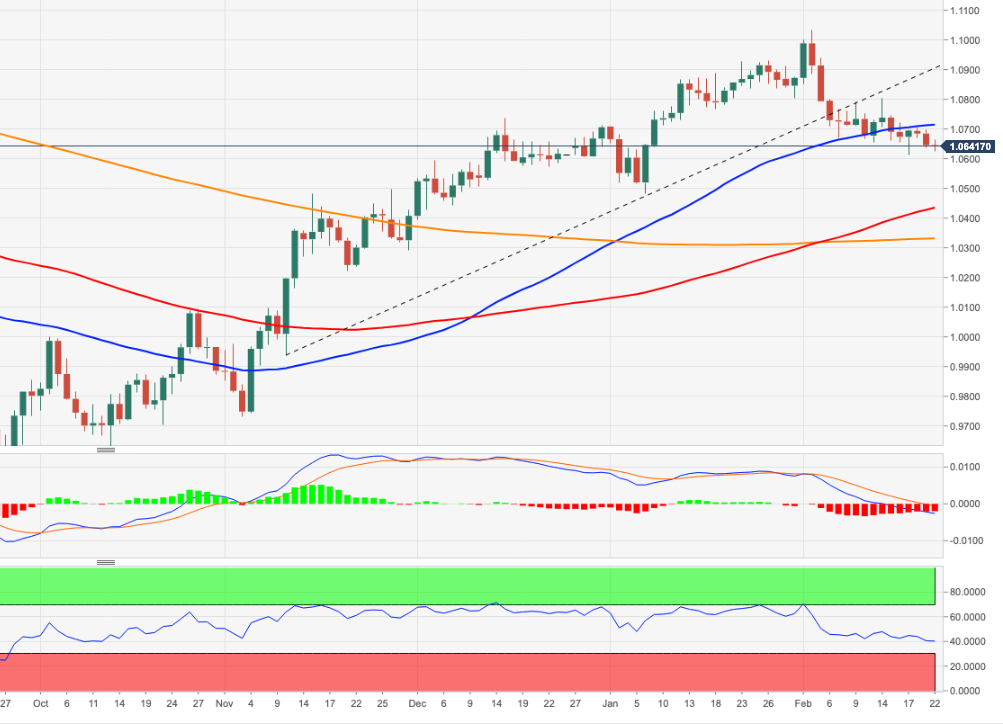
EUR/USD slips to low 1.06s. Economists at Scotiabank believe that the world’s most popular currency pair could sustain a sharp fall to the 1.04/05 zone.
A retest of last week’s low at 1.0613 looks inevitable
“There is a soft undertone to price action here, even if movement is relatively limited.”
“Sustained losses below support at 1.0680 points to more EUR weakness ahead; a retest of last week’s low at 1.0613 looks inevitable at this point and a deeper drop towards 1.04/1.05 is a real possibility (1.0461 is the 38.2% retracement of the 0.95/1.10 rally).”
- GBP/USD attracts some dip-buying on Wednesday, albeit lacks any follow-through.
- Bets for additional BoE rate hikes underpin the GBP and lend support to the major.
- Hawkish Fed expectations, looming recession risks benefit the USD and cap the pair.
- Traders also seem reluctant and prefer to wait for the release of the FOMC minutes.
The GBP/USD pair trims a part of intraday losses and climbs back closer to the 1.2100 mark during the early North American session on Wednesday. Spot prices, however, remain below a multi-day peak, around the 1.2145-1.2150 region touched the previous day, as traders keenly await the FOMC minutes before placing fresh bets.
Ahead of the key risk, some repositioning trade prompts some US Dollar selling and lends support to the GBP/USD pair. Apart from this, expectations for additional interest rate hikes by the Bank of England (BoE) act as a tailwind for the British Pound. The speculations were fueled by UK PMIs released on Tuesday, which indicated that business activity rose more than expected in February. This, in turn, lifted optimism that the YJ may be able to avoid a steep economic downturn.
The downside for the USD, meanwhile, is likely to remain limited amid growing acceptance that the Fed will stick to its hawkish stance for longer in the wake of stubbornly higher inflation. In fact, the US CPI and PPI data released last week showed that inflation isn't coming down quite as fast as hoped. Adding to this, several FOMC policymakers, including Fed Chair Jerome Powell, recently stressed the need to keep lifting rates gradually to fully gain control of inflation.
Hence, the FOMC minutes will be closely scrutinized for fresh clues about the Fed's future rate-hike path. This will play a key role in influencing the near-term USD price dynamics and help determine the next leg of a directional move for the GBP/USD pair. In the meantime, looming recession risks, along with geopolitical tensions, should benefit the Greenback's relative safe-haven status and contribute to capping any meaningful upside for the major, at least for the time being.
Technical levels to watch
- The index manages well to keep the trade above the 104.00 mark.
- Extra gains are likely and could retest the 2023 top around 105.60.
DXY tries to extend the weekly recovery further north of the 104.00 barrier on Wednesday.
The ongoing price action favours the continuation of the uptrend for the time being. Further bouts of strength should clear the February high at 104.66 (February 17) to allow for a probable challenge of the 2023 top at 105.63 (January 6).
In the longer run, while below the 200-day SMA at 106.44, the outlook for the index remains negative.
DXY daily chart
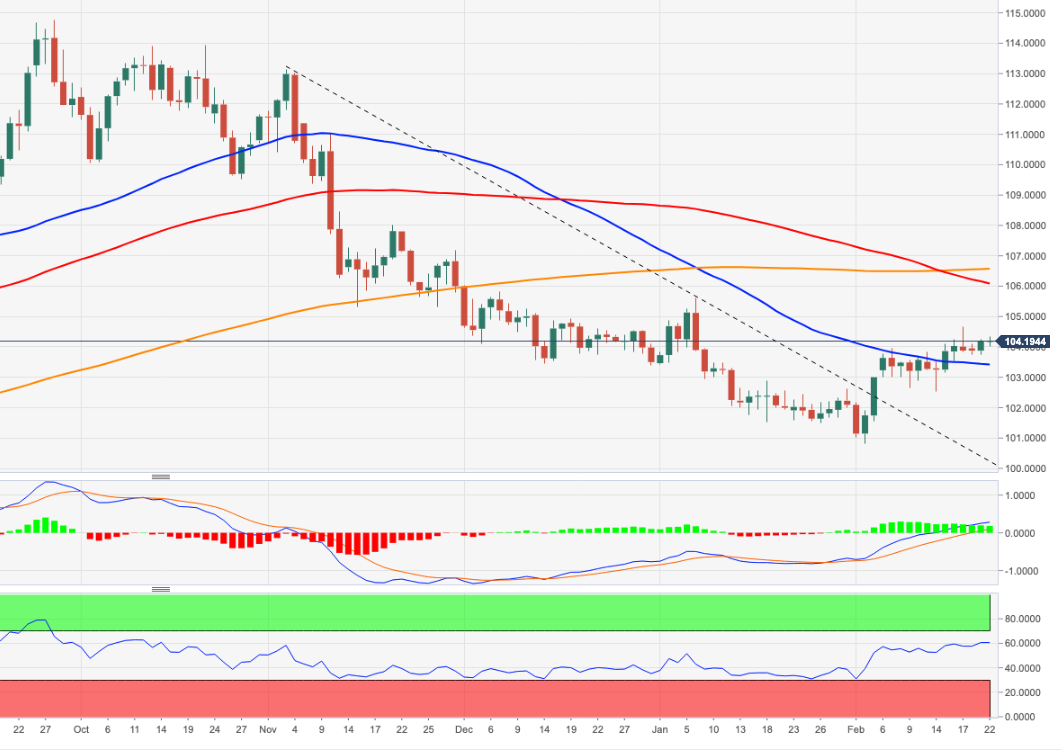
- USD/CAD pulls back from its highest level since January touched earlier this Wednesday.
- Sliding Oil prices undermine the Loonie and help limit the downside amid a bullish USD.
- The setup supports prospects for additional gains, though bulls await the FOMC minutes.
The USD/CAD pair retreats from the 1.3560 area, or the highest level since January 6 touched this Wednesday and drops to a fresh daily low in the last hour. Spot prices, however, quickly recover a few pips and hold steady around the 1.3535 region during the early North American session.
The US Dollar remains pinned near a multi-week high amid growing acceptance that the Fed will stick to its hawkish stance. Apart from this, bearish Crude Oil prices undermine the commodity-linked Loonie and act as a tailwind for the USD/CAD pair. Bulls, however, refrain from placing aggressive bets and prefer to move to the sidelines ahead of the FOMC meeting minutes, due for release later during the US session.
From a technical perspective, the overnight strong rally and a daily close above the 100-day Simple Moving Average (SMA) validated the recent bullish breakout through a descending trend channel. Adding to this, oscillators on the daily chart have been gaining positive traction and support prospects for a move towards reclaiming the 1.3600 mark, en route to the YTD peak around the 1.3680-1.3685 area touched in January.
On the flip side, the daily swing low, around the 1.3515 area, coinciding with the 100-day SMA, now seems to protect the immediate downside. Any further decline below the 1.3500 mark might be seen as a buying opportunity and is more likely to remain limited near the 1.3445-1.3440 horizontal zone. The latter should act as a pivotal point, which if broken might prompt technical selling and pave the way for deeper losses.
The USD/CAD pair could then slide towards the 1.3400 round figure. The corrective pullback could get extended further towards the next relevant support near the 1.3330-1.3325 area and the 1.3300 mark. Bears might eventually aim to challenge last week's swing low, around the 1.3275-1.3270 region.
USD/CAD daily cahrt
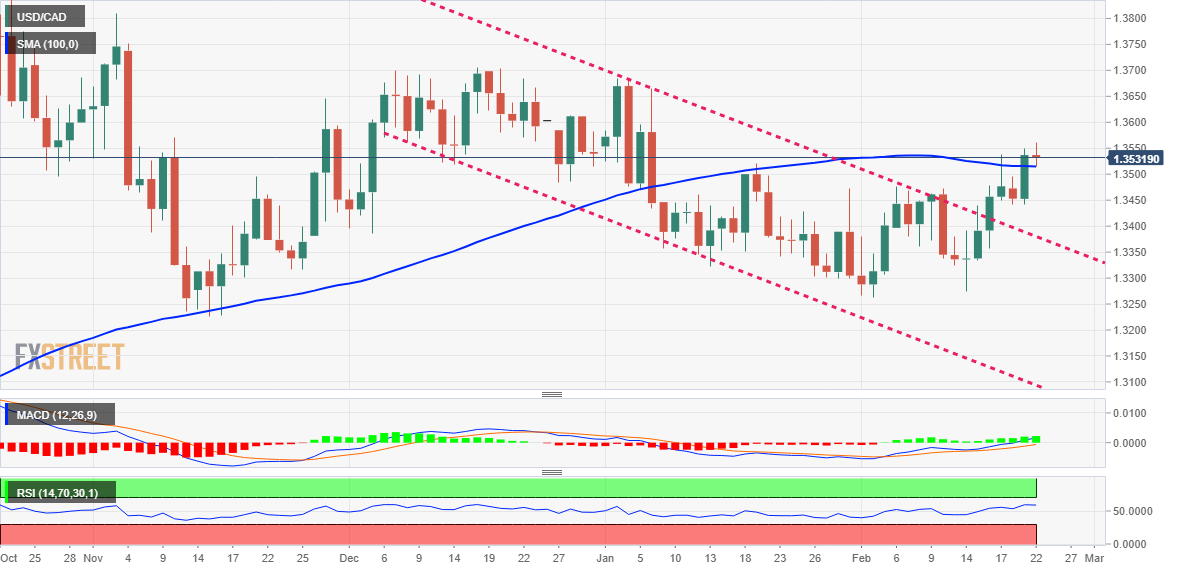
Key levels to watch
USD/CAD has established above the 1.35 level. Economists at Scotiabank expect the pair to test the 1.36/37 area.
Flows are liable to favour the USD
“Risk appetite looks soft and flows are liable to favour the USD in the short run.”
“A bullish alignment of intraday and daily DMI oscillators supports the bullish backdrop for the USD; the charts suggest a fairly easy push on to the 1.36/1.37 range from here to retest the peaks seen in December.”
See: CAD is likely to struggle to make considerable ground against USD and EUR for now – Commerzbank
Cable corrected sharp gains from Tuesday earlier in the session. Economists at Scotiabank believe that the GBP/USD pair could see more weakness ahead.
GBP vulnerable to more downside
“Intraday patterns look a little soft but not decisively so.”
“The main problem for the GBP is that yesterday’s bounce stalled just below the 55-Day Moving Average (1.2171) which has served as something of a block on gains recently.”
“Failure to progress leaves the GBP vulnerable to more downside probing and a test of key medium-term support around 1.1925 (where the 100 and 200-DMA converge currently).”
The Canadian inflation data for January surprised on the downside and caused the Loonie to trade weaker. Economists at Commerzbank expect the CAD to remain vulnerable against the USD and the EUR.
Some market participants worry that the BoC will drop behind compared with the Fed and ECB
“Some market participants might worry that – in view of a combination of weaker than expected inflation and a significant fall in retail sales – the BoC will drop behind compared with the Fed and ECB; that is putting pressure on the CAD.”
“The Loonie is likely to struggle to make considerable ground against USD and EUR for now, in particular, if weaker economic data reflects the slowing effect of monetary policy tightening in Canada over the coming months.”
“We expect that the BoC will turn out to be hawkish though and that this will also be reflected in its rhetoric in case of a continued tight labour market and/or continued stubborn core inflation levels. That should support the Loonie.”
- EUR/JPY comes under pressure following recent YTD peaks.
- Further upside should refocus on the December 2022 high near 146.70.
EUR/JPY faces some selling pressure after surpassing the 144.00 hurdle on Tuesday, or new 2023 tops.
While the cross looks somewhat side-lined for the time being, a convincing breakout of the 2023 high at 144.16 (February 21) could spark extra strength to, initially, the December 2022 peak at 146.72 (December 15).
In the meantime, while above the 200-day SMA, today at 141.34, the outlook for the cross is expected to remain positive.
EUR/JPY daily chart
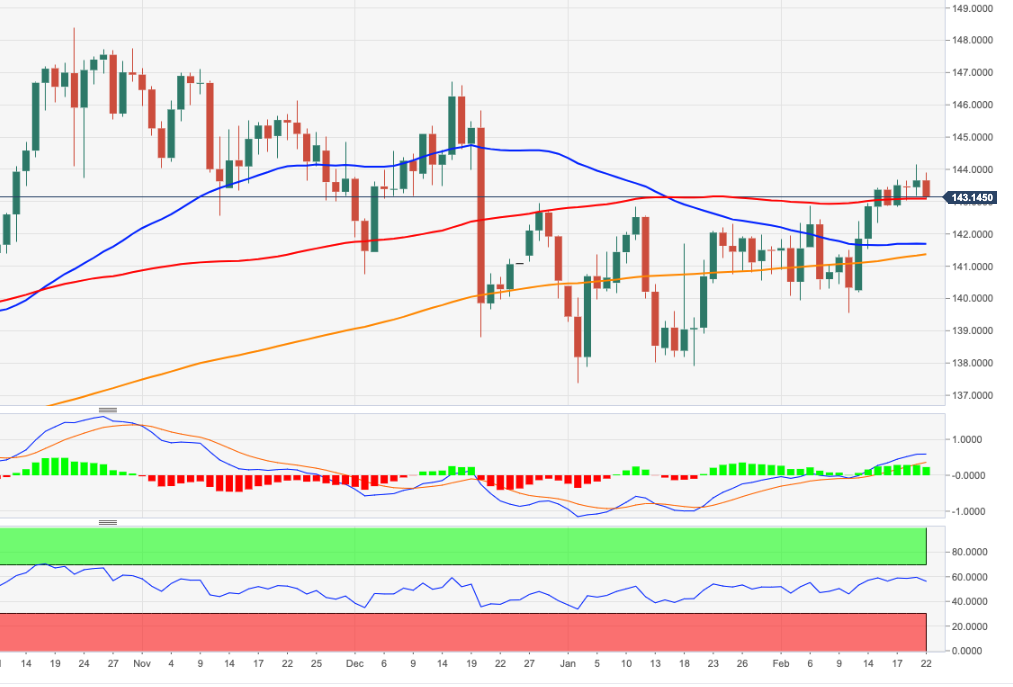
- AUD/USD drifts lower for the second successive day and drops to a fresh low since January.
- Hawkish Fed expectations, recession fears underpin the Greenback and weigh on the major.
- Investors keenly await the key FOMC meeting minutes before placing fresh directional bets.
The AUD/USD pair remains under some selling pressure for the second straight day on Wednesday and drops to the 0.6810 area, or a fresh low since January 6 during the mid-European session.
The US Dollar (USD) remains pinned near a six-week top amid hawkish Fed expectations and turns out to be a key factor weighing on the AUD/USD pair. In fact, the markets seem convinced that the US central bank will continue to hike interest rates in the wake of stubbornly high inflation. The bets were reaffirmed by the US CPI and PPI data released last week, which showed that inflation isn't coming down quite as fast as hoped.
Moreover, the incoming robust US macro data points to an economy that remains resilient despite rising borrowing costs. This comes on the back of hawkish comments by several FOMC officials, including Fed Chair Jerome Powell, stressing the need to keep lifting rates gradually to control inflation. The prospects for further policy tightening remain supportive of elevated US Treasury bond yields and underpin the Greenback.
Hence, the market focus will remain glued to the release of the FOMC meeting minutes, due later during the US session. Investors will look for fresh cues about the Fed's future rate-hike path, which will influence the USD and provide a fresh directional impetus to the AUD/USD pair. In the meantime, the looming recession risks, along with geopolitical tensions, should benefit the safe-haven buck and weigh on the risk-sensitive Aussie.
Nevertheless, the aforementioned fundamental backdrop suggests that the path of least resistance for the AUD/USD pair is to the downside. Even from a technical perspective, the recent breakdown and acceptance below the 50-day SMA favour bearish traders. Some follow-through selling below the 0.6800 mark will reaffirm the negative outlook and set the stage for a slide towards testing sub-0.6700 levels, or the YTD low set in January.
Technical levels to watch
EUR/USD is still trading south of 1.07. A break under last week’s low of 1.0615 could open up further losses to the 1.0485 mark, economists at BBH report.
Germany reported a mixed February IFO business climate survey
“The Euro is trading lower near 1.0625 and nearing a test of last week’s low near 1.0615. Break below that would set up a test of the January 6 low near 1.0485.”
“Headline came in at 91.1 vs. 91.2 expected and a revised 90.1 (was 90.2) in January. Current assessment came in at 93.9 vs. 95.0 expected and 94.1 in January, while expectations came in at 88.5 vs. 88.4 expected and 86.4 in January. While many of the survey indicators appear to have bottomed, we warn against getting too excited about the eurozone outlook as the hard data remain weak.”
St. Louis Federal Reserve President James Bullard told CNBC on Wednesday that the Fed will have to go north of 5% to tame inflation, as reported by Reuters.
Additional takeaways
"US economy is stronger than what we previously thought."
"We need to get inflation down in 2023."
"Silicon Valley layoffs have no bearing on overall strength of labor market."
"Still think we can get inflation down while maintaining a strong labor market."
"Still in a low productivity growth regime."
"Fed should only slow down once it's got to the terminal rate."
"Markets may be overpricing risk of recession in 2023."
"I forecast moderately slow growth this year with inflation declining."
"Fed's risk is inflation doesn't come down or inflation reaccelerates."
Market reaction
These comments don't seem to be having a noticeable impact on the US Dollar's performance against its rivals. As of writing, the US Dollar Index was up 0.08% on the day at 104.25.
Economist at UOB Group Enrico Tanuwidjaja reviews the latest results from the current account in Indonesia.
Key Takeaways
“Indonesia’s 4Q22 current account (CA) position recorded another quarter of surplus to the tune of USD4.3bn (or an equivalent of 1.3% of GDP), though slightly lower than 3Q22's USD4.5bn (1.3% of GDP).”
“The capital and financial account recorded a significantly lower deficit of just USD0.4bn (0.1% of GDP), down from USD5.5bn (1.6% of GDP) on the back of stellar FDI inflows into the country and the easing of portfolio capital outflows in 4Q22.”
“Overall, Indonesia recorded an even stronger CA surplus amounting to USD13.2bn in 2022 (1% of GDP), after registering USD3.5bn surplus in 2021 (0.3% of GDP). This comes on the back of more than a decade of persistent deficit amidst strong import demand. Nevertheless, we expect easing commodity prices (though remained steady), possibly higher imports notably due to higher services deficit, and higher primary deficit to turn its CA position into a deficit of circa 0.3% of GDP in 2023.”
The New Zealand Dollar has strengthened modestly. The main trigger for the Kiwi’s rebound has been the RBNZ’s latest policy update. However, economists at MUFG Bank expect the NZD bounce to be short-lived.
RBNZ disappoints expectations for a lower terminal rate peak
“The RBNZ decided to raise their key policy rate by a further 50 bps to 4.75% in line with the consensus.”
“The RBNZ still believes that it has work to do to get rates into more restrictive territory to bring inflation back to their target. The RBNZ’s updated forward rate guidance continued to signal that they plan to raise the policy rate to a peak of 5.50% this year. The timing of reaching the terminal rate was pushed back a little from Q3 to Q4.”
“The RBNZ is more inclined to slow the pace of hikes further by delivering smaller 25 bps hikes at upcoming policy meetings. One final larger 50 bps hike can’t though be completely ruled out in April.”
“At best we see today’s RBNZ policy outcome providing only temporary support for the Kiwi which has been one of worst performing G10 currencies so far this year.”
Economists at BNP Paribas discuss the USD outlook against the EUR and JPY.
Dollar to weaken somewhat versus the Euro
“We expect the Dollar to weaken somewhat versus the Euro. The USD's valuation is expensive, positioning in the market is very long and the long-term interest rate differential should narrow.”
“The Yen has already weakened significantly versus the Dollar, reflecting the increased policy divergence between Fed and BoJ. We expect USD/JPY to remain around current levels in the near term. In 2023, the Yen should strengthen versus the Dollar considering that the federal funds rate should have reached its terminal rate.”
Following his meeting with Russian President Vladimir Putin, China's top diplomat Wang Yi said that they are ready to deepen strategic cooperation with Russia on Wednesday, as reported by Reuters.
"Our relations will not succumb to pressure from third countries," Wang added.
Meanwhile, Putin noted that it's very important for them to have a cooperation with China and said he is looking forward Chinese President Xi Jinping to visit Moscow.
Market reaction
These comments don't seem to be having a significant impact on market mood. As of writing, US stock index futures were trading virtually unchanged on the day.
Economist at UOB Group Lee Sue Ann suggests the Bank of Korea could keep the policy rate unchanged at 3.50% at this week’s event (February 23).
Key Quotes
“Views are now mixed whether the BOK would carry on tightening its monetary policy after a cumulative 300bps rate hike since Aug 2021. The BOK was also clear in its messaging that the room for further monetary tightening remains.”
“However, barring a change to global inflation trajectory where price gains are expected to slow this year, we maintain our view that the BOK is done with its rate hikes and would stay on hold at 3.50% through 2023.”
The RBNZ's determination to get ahead of inflation will likely see it deliver a 5.5% OCR peak by mid-year, in the opinion of economists at Westpac.
The RBNZ is grappling with an uncertain environment
“We now expect a peak of 5.5% in the OCR this year, up from our earlier forecast of 5.25%.”
“The Reserve Bank remains committed to bringing inflation back under control and sees the risks as being to the upside of its already-strong forecasts. As a result, we expect that it will carry through with its plans, at least in the near term.”
“However, the RBNZ also recognises the downside risks to activity in the years ahead, as higher mortgage rates squeeze households’ spending power.”
“Cyclone Gabrielle will add to medium-term inflation pressures at the margin, but the scale of the impact is hard to gauge at this early point.”
Once USD/CNH clears the 6.9000 hurdle it could challenge the 6.9300 level in the near term, comment UOB Group’s Economist Lee Sue Ann and Markets Strategist Quek Ser Leang.
Key Quotes
24-hour view: “Our view USD to trade in range between 6.8530 and 6.800 was incorrect is it soared to a high of 6.8958 before closing at 6.8920 (+0.49%). While there is room for USD to break above 6.9000 today, the next major resistance level at 6.9300 is unlikely to come under threat. Support is at 6.8850, followed by 6.8750.”
Next 1-3 weeks: “Yesterday (21 Feb, spot at 6.8600), we indicated that ‘upward momentum has waned somewhat but only a break of 6.8480 would indicate that USD is not advancing further to 6.9000’ USD soared to a high of 6.8958 in NY trade and upward momentum is beginning to strengthen again. If USD were to break above 6.9000, the next level to monitor is at 6.9300. On the downside, a breach of 6.8480 (no change in ‘strong support’ level) would indicate that the USD strength that started early this month has ended.”
Antje Praefcke, FX Analyst at Commerzbank, does not expect the EUR/USD pair to ease much below 1.06.
Euro is likely to keep up quite well
“The Fed will receive some important information, such as the PCE index on Friday, the leading indicators (ISM index) as well as the labour market report and inflation data for February. All of these might push market expectations for the key rate a little further upwards and make the market more confident that the cycle will only end at 5.50%.”
In case of strong data, the Dollar might therefore appreciate a little further, but as expectations have also risen that the ECB might get into a similar situation, i.e. that its cycle will take longer and will go further, the Euro is likely to keep up quite well.”
“I do not expect EUR/USD to ease much below 1.06, but the lower end is nonetheless likely to remain the weaker one for now.”
- NZD/USD struggles near monthly low despite a hawkish RBNZ rate hike on Wednesday.
- The prospects for further policy tightening by the Fed underpins the USD and caps gains.
- Recession fears also benefit the buck and act as a headwind for the risk-sensitive Kiwi.
- Traders now await the release of the FOMC meeting minutes before placing fresh bets.
The NZD/USD pair struggles to capitalize on its modest intraday uptick and attracts fresh sellers in the vicinity of mid-0.6200s on Wednesday. The pair is currently placed just a few pips above the 0.6200 mark, or its lowest level since January 6 touched last Friday, and a technically significant 200-day Simple Moving Average (SMA).
The prospect of further policy tightening by the Fed keeps the US Dollar pinned near a multi-week top, which, in turn, is seen as a key factor acting as a headwind for the NZD/USD pair. In fact, the markets seem convinced that the US central bank will stick to its hawkish stance and have been pricing in at least a 25 bps lift-off at the next two FOMC meetings in March and May. The bets were further lifted by strong US PMI prints on Tuesday, which showed that business activity unexpectedly rebounded to an eight-month high in February.
This comes on the back of the upbeat US macro data, which pointed to an economy that remains resilient despite rising borrowing costs. Adding to this, the US CPI and PPI data released last week showed that inflation isn't coming down quite as fast as hoped. Moreover, several FOMC members, including Fed Chair Jerome Powell, recently stressed the need to keep lifting rates gradually to fully gain control of inflation. This remains supportive of elevated US Treasury bond yields, which, along with a softer risk tone, underpins the safe-haven buck.
The market sentiment remains fragile amid worries about an impending global recession. Apart from this, geopolitical tensions weigh on investors' sentiment and drive flows away from the risk-sensitive Kiwi. The aforementioned fundamental factors, to a larger extent, overshadow a hawkish rate hike from the Reserve Bank of New Zealand (RBNZ) earlier this Wednesday. This, in turn, suggests that the path of least resistance for the NZD/USD pair is to the downside, though a convincing break below the 200-day SMA is needed to confirm the bearish outlook.
Technical levels to watch
The British Pound registered impressive gains on the back of upbeat economic news on Wednesday. Nonetheless, economists at Rabobank expect the GBP to weaken as the UK still faces a lineup of sour economic fundamentals.
EUR/GBP to grind higher to 0.90 around the middle of the year
“Despite Tuesday’s better news, we remain unconvinced about the UK’s current fundamental backdrop. In the absence of a deal on the Northern Ireland protocol, we expect upside flurries in GBP to be short-lived.”
“The UK still faces a lineup of sour economic fundamentals and we continue to expect EUR/GBP to grind higher to 0.90 around the middle of the year.”
“We see plenty more scope for dips by Cable back below the 1.20 level in the weeks ahead.”
- USD/JPY struggles to gain any meaningful traction and remains confined in a narrow range.
- Hawkish Fed expectations continue to underpin the USD and act as a tailwind for the major.
- Recession fears, geopolitical tensions benefit the safe-haven PY and seem to cap the upside.
- Traders also seem reluctant to place aggressive bets ahead of the FOMC meeting minutes.
The USD/JPY pair oscillates in a narrow trading band through the first half of the European session on Wednesday and consolidates its recent gains to a two-month high touched the previous day. The pair is currently placed just below the 135.00 psychological mark as traders keenly await the release of the FOMC minutes for a fresh impetus.
The markets have been pricing in at least a 25 bps lift-off at the next two FOMC meetings in March and May. Hence, investors will look for fresh clues about the Fed's future rate-hike path. This, in turn, will play a key role in influencing the US Dollar price dynamics and help determine the next leg of a directional move for the USD/JPY pair. In the meantime, growing acceptance that the US central bank will stick to its hawkish stance acts as a tailwind for the Greenback and lend some support to the major.
The expectations were reaffirmed by strong US PMI prints on Tuesday, showing that business activity unexpectedly rebounded to an eight-month high in February. Moreover, the incoming positive US macro data pointed to an economy that remains resilient despite rising borrowing costs and should allow the Fed to keep raising rates to control inflation. This remains supportive of elevated US Treasury bond yields and assists the USD to stand tall well within the striking distance of a six-week high.
Market participants this week will further take cues from the newly nominated head of the Bank of Japan (BoJ) Governor Kazuo Ueda's testimony on Friday. Investors will scrutinize Ueda's view on the future of yield curve control (YCC) and super-easy monetary policy, which should drive the Japanese Yen (JPY). Heading into the key event risks, looming recession risks, along with geopolitical tensions, seem to benefit the JPY's safe-haven status and keep a lid on any meaningful upside for the USD/JPY pair.
Technical levels to watch
Open interest in natural gas futures markets extended the uptrend for yet another session on Tuesday, this time increasing by around 15.4K contracts according to preliminary readings from CME Group. Volume, too, added to the previous daily build and went up by around 56.3K contracts.
Natural Gas risks a drop to $1.80
There seems to be no respite for the decline in prices of the natural gas, which put the key $2.00 mark per MMBtu to the test for the first time since September 2020 on Tuesday. The downtick was on the back of rising open interest and volume and still underpins the idea of further weakness in the near term. Against that, the September 2020 low near $1.80 now emerges as the next support of relevance.
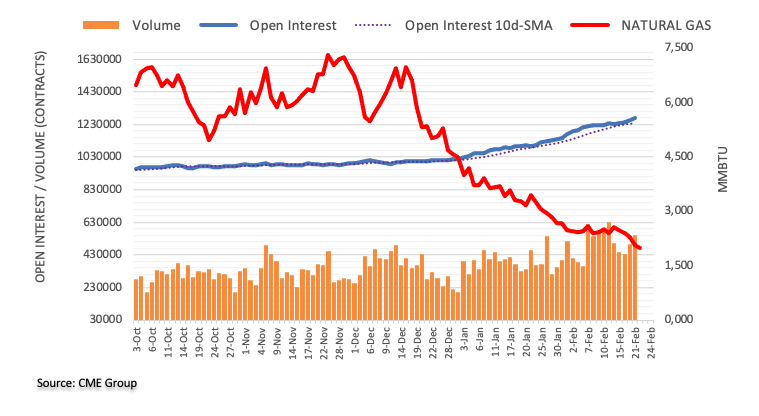
Over the past weeks, much has been written about the changes in the leadership of the Bank of Japan (BoJ). In the view of economists at Commerbznak, patience seems to be required as far as the BoJ is concerned.
The market is going to consider Ueda’s comments very carefully
“In view of an inflation rate that is high by Japanese standards – it reached 4% in January with the core rate standing at 3% with an upward trend – the market is going to consider Ueda’s comments very carefully. This might lead to erratic moves in JPY. I doubt that these will be sustainable.”
“Only the BoJ decision in early March, still under Kuroda, might provide a first indication as to how monetary policy will develop if Kuroda really was to pave the way for his successor by widening the yield range. Otherwise, we will have to wait patiently until late April when Ueda will be running his first meeting. And even then, it is rather unlikely that Ueda would immediately turn everything in monetary policy inside out.”
“In this respect, we will probably have to be patient with the BoJ as far as a possible turnaround in monetary policy is concerned.”
CME Group’s flash data for crude oil futures markets noted traders trimmed their open interest positions for the fourth session in a row on Tuesday, this time by around 11.2K contracts. In the same line, volume partially reversed the previous daily build and shrank by around 14.4K contracts.
WTI: A test of the 2023 low remains on the table
Prices of the barrel of the WTI resumed the downtrend on Tuesday amidst dwindling open interest and volume, which hints at the likelihood that a convincing decline seems out of favour for the time being. That said, the next support of note for the commodity remains at the YTD low at $72.30 (February 6).
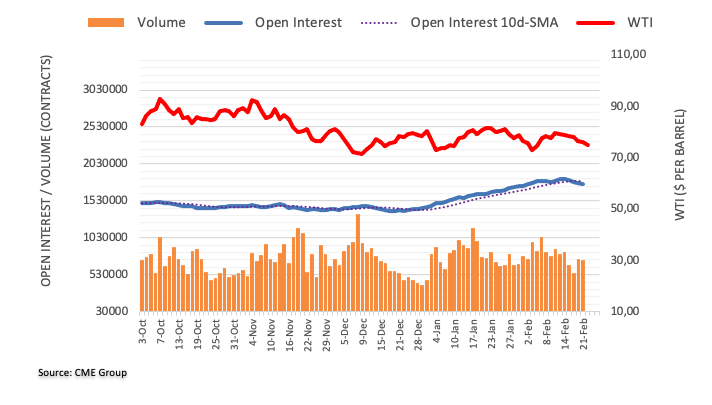
In the opinion of UOB Group’s Economist Lee Sue Ann and Markets Strategist Quek Ser Leang, further upside momentum could still encourage USD/JPY to revisit the 135.50 zone in the short term.
Key Quotes
24-hour view: “We did not anticipate the strong rise in USD to 135.22 yesterday (we were expecting USD to trade sideways). Despite the strong advance, there has been no significant increase in upward momentum and USD is unlikely to strengthen much further. Today, USD is more likely to consolidate between 134.20 and 135.20.”
Next 1-3 weeks: “On Monday (20 Feb, spot at 134.35) we highlighted that USD could consolidate for a couple of days before heading higher to the next target at 135.50. While USD rose to a high of 135.22 yesterday, upward momentum has not increased by much. However, as long as 133.60 (‘strong support’ level was at 133.30 yesterday) is not breached, the USD strength that started in the middle of last week is still intact. Looking ahead, if the USD breaks decisively above 135.50, the next level to watch is 137.00.”
- EUR/USD gyrates around Tuesday’s closing levels near 1.0650/40.
- Germany’s Business Climate improved a tad in February.
- The FOMC Minutes will take centre stage later in the session.
The single currency trades in a vacillating fashion and motivates EUR/USD to hover around the 1.0650/40 band in the European morning on Wednesday.
EUR/USD flattish ahead of FOMC Minutes
EUR/USD navigates without a clear direction in the mid-1.0600s amidst a mild bid bias surrounding the greenback.
The pair, in the meantime, keeps the range bound theme well in place, this time in the lower end of the monthly range against the backdrop of increasing prudence among traders in light of the release of the FOMC Minutes later in the NA session.
In the domestic calendar, final inflation figures in Germany showed the CPI rose 8.7% YoY in January and 1.0% vs. the previous month. Still in Germany, the Business Climate tracked by the IFO institute advanced modestly to 91.1 for the current month (from 90.1).
Across the pond and other than the publication of the FOMC Minutes, MBA Mortgage Applications will be the only data release of note.
What to look for around EUR
EUR/USD loses some traction amidst the gradual advance in the greenback on Wednesday.
In the meantime, price action around the European currency should continue to closely follow dollar dynamics, as well as the potential next moves from the ECB after the bank has already anticipated another 50 bps rate raise at the March event.
Back to the euro area, recession concerns now appear to have dwindled, which at the same time remain an important driver sustaining the ongoing recovery in the single currency as well as the hawkish narrative from the ECB.
Key events in the euro area this week: Germany Final Inflation Rate/IFO Business Climate, France Business Confidence (Wednesday) – EMU Final Inflation Rate (Thursday) – Germany Final Q4 GDP Growth Rate/GfK Consumer Confidence (Friday).
Eminent issues on the back boiler: Continuation of the ECB hiking cycle amidst dwindling bets for a recession in the region and still elevated inflation. Impact of the Russia-Ukraine war on the growth prospects and inflation outlook in the region. Risks of inflation becoming entrenched.
EUR/USD levels to watch
So far, the pair is retreating 0.01% at 1.0642 and a drop below 1.0612 (monthly low February 17) would target 1.0481 (2023 low January 6) en route to 1.0329 (200-day SMA). On the other hand, the next up barrier emerges at 1.0804 (weekly high February 14) seconded by 1.1032 (2023 high February 2) and finally 1.1100 (round level).
Economists at ING believe that a move below the 0.88 mark in the EUR/GBP pair is on the cards.
BoE unlikely to deliver more than one hike
“We are not convinced the BoE will ultimately deliver more than one hike, and given the Pound’s high sensitivity to the BoE story, we are struggling to see a sustainable outperformance of Sterling against the Euro in the coming months.”
“But we have to admit that a break below 0.8800 in EUR/GBP is a tangible possibility in the very near term, and a recovery from those levels (which is our base case) may only be gradual.”
In their latest forecast report, economists at Citigroup raised their outlook for global growth slightly while revising up their estimates for the US Federal Reserve (Fed) rate hikes.
Key quotes
“See 2023 global growth slowing to 2.2% vs 1.9% estimated earlier.”
“Expect US Fed to raise interest rates thrice in 2023, taking the funds rate into the 5% range.”
“Expect a “less hard” landing for the global economy in 2023.”
- GBP/USD comes under some selling pressure on Tuesday and snaps a three-day winning streak.
- Hawkish Fed expectations, looming recession risks underpin the USD and weigh on the major.
- Bets for additional rate hikes by the BoE could help limit losses ahead of the FOMC minutes.
The GBP/USD pair comes under some selling pressure following an early uptick to the 1.2135 region and drops to a fresh daily low during the first half of the European session. Spot prices currently trade around the 1.2080-1.2075 region, down nearly 0.30% for the day, and for now, seem to have snapped a three-day winning streak.
The US Dollar (USD) remains pinned near a six-week top amid expectations for further policy tightening by the Federal Reserve (Fed) and turns out to be a key factor weighing on the GBP/USD pair. In fact, the markets are now pricing in at least a 25 bps lift-off at each of the next two FOMC policy meetings in March and May. The bets were lifted by strong US PMI prints on Tuesday, which showed that business activity unexpectedly rebounded to an eight-month high in February.
This comes on the back of the incoming positive US macro data, which pointed to an economy that remains resilient despite rising borrowing costs. Moreover, several FOMC officials, including Fed Chair Jerome Powell, recently stressed the need to keep raising rates gradually to fully gain control of inflation. This remains supportive of elevated US Treasury bond yields, which, along with looming recession risks and geopolitical tensions, continue to underpin the safe-haven buck.
Hence, the market focus will remain glued to the release of the minutes from the latest FOMC monetary policy meeting. Investors will look for fresh clues about the Fed's rate-hike path, which will play a key role in influencing the near-term USD price dynamics and provide a fresh directional impetus to the GBP/USD pair. In the meantime, rising bets for additional interest rate hikes by the Bank of England (BoE) should lend support to the British Pound and help limit losses.
The UK PMIs released on Tuesday indicated that business activity rose more than expected in February and fueled optimism that the country may be able to avoid a steep economic downturn. This makes it prudent to wait for strong follow-through selling before confirming that the GBP/USD pair's recent recovery move from a technically significant 200-day SMA has run out of steam.
Technical levels to watch
Following the release of the German IFO Business Survey, the institute’s Economist Klaus Wohlrabe said that the “German economy will not get around recession but it will be mild.”
Additional quotes
45.4 percent of companies complained about supply chain bottlenecks in February (compared to 48.4 percent in January).
Share of german companies who want to increase prices has fallen.
German industry's export expectations are slightly down.
-
EUR/USD to climb back higher toward 1.0700-1.0750 before the weekend – ING
-
EUR/GBP struggles near 0.8800 mark, seems vulnerable amid BoE rate hike bets
Sterling rose significantly on Tuesday. However, Antje Praefcke, FX Analyst at Commerzbank, believes that the currency could struggle again ahead of the Bank of England (BoE) meeting in March.
Brexit remains an ongoing issue for the British economy
“If the British economy were to stand up better than expected it would be easier for the BoE to continue its rate hike cycle as it would have to show less consideration for economic developments. This view seemed to dominate the market yesterday thanks to the positive leading indicators and economic developments.”
“However, we are cautious to sound the all-clear at this stage. Due to high inflation levels, consumers are likely to remain cautious. Even if the rise of the index for the manufacturing sector is encouraging, it remains under the 50 mark, suggesting contraction. Brexit remains an ongoing issue for the British economy anyway.”
“I am pleased Sterling has been allowed a bit of respite, but what will be decisive for the currency will be how restrictive the BoE will come across in March. Until then there will be a few more data publications and speeches by BoE members that might cause difficulties for Sterling again.”
- German IFO Business Climate Index came in at 91.1 in February.
- IFO Current Economic Assessment for Germany dropped to 93.9 this month.
- February German IFO Expectations Index improved to 88.5.
The headline German IFO Business Climate Index advanced to 91.1 in February versus the previous reading of 90.2 and the forecast of 91.4.
Meanwhile, the Current Economic Assessment dropped to 93.9 points in the reported month as against January’s 94.1 and 95.0 expected.
The IFO Expectations Index – indicating firms’ projections for the next six months, increased to 88.5 in February from the previous month’s 86.4 and against the estimates of 88.3.
Market reaction
EUR/USD is weighed down by the mixed German IFO survey. At the time of writing, the pair is trading at 1.0636, down 0.08% on the day.
About German IFO
The headline IFO business climate index was rebased and recalibrated in April after the IFO Research Institute changed the series from the base year of 2000 to the base year of 2005 as of May 2011 and then changed the series to include services as of April 2018. The survey now includes 9,000 monthly survey responses from firms in the manufacturing, service sector, trade and construction.
- USD/CAD gains traction for the second straight day and climbs to its highest level since January.
- Tuesday’s softer Canadian CPI, bearish oil prices undermine the Loonie and remain supportive.
- Hawkish Fed expectations favour the USD bulls ahead of the crucial FOMC meeting minutes.
The USD/CAD pair attracts some buying for the second straight day on Wednesday and touched its highest level since January 6 during the first half of the European session. The pair currently trades around the 1.3550 region and seems poised to prolong its recent upward trajectory witnessed over the past week or so.
A combination of factors undermines the Canadian Dollar, which, in turn, assists the USD/CAD pair to capitalize on the previous day's strong move up and gain traction for the second straight day. The softer Canadian consumer inflation figures released on Tuesday fueled speculations that the Bank of Canada could pause the rate-hiking cycle. Adding to this, bearish Crude Oil prices - amid worries that rapidly rising borrowing costs will dampen economic growth and dent fuel demand - further weighs on the commodity-linked Loonie.
The US Dollar, on the other hand, continues to draw support from firming expectations that the Federal Reserve will stick to its hawkish stance. In fact, the markets are pricing in at least a 25 bps lift-off at the next two FOMC policy meetings in March and May. The bets were reaffirmed by strong US PMIs on Tuesday, which showed that business activity unexpectedly rebounded to an eight-month high in February. The data pointed to an economy that remains resilient and support prospects for further policy tightening by the Fed.
Moreover, several FOMC officials, including Chairman Jerome Powell, recently stressed the need to keep raising rates gradually to fully gain control of inflation. Hence, the focus will remain glued to the release of the FOMC monetary policy meeting minutes, due later during the US session. Investors will look for fresh cues about the Fed's rate-hike path, which will influence the USD and provide a fresh impetus to the USD/CAD pair. Apart from this, oil price dynamics could further contribute to producing meaningful trading opportunities.
Technical levels to watch
The New Zealand Dollar is trading stronger after the RBNZ 50 bps hike was paired with a hawkish tone. The central bank could provide more support into the second quarter, but external developments will be the main driver, economists at ING report.
RBNZ stays hawkish
“The RBNZ's decision overnight was fully in line with our expectations: a 50 bps rate hike to 4.75%, a hawkish tone, and unchanged rate projections.”
“We still think there is a high risk that the 5.50% peak rate will not be reached unless the impact of the cyclone effectively stops the deflationary process.”
“Markets are pricing in 35 bps for the 5 April meeting. A 25 bps increase looks more likely, but we wouldn’t exclude one last 50 bps move before data deteriorate in the second quarter. This means that the RBNZ could offer support to NZD into the start of Q2, but we then think that a worsening in data and slower inflation should leave further NZD/USD upside heavily dependent on a favourable external environment.”
“We still target 0.67 by the third quarter.”
EUR/USD edged lower and closed in negative territory at around 1.0650 on Tuesday. However, economists at ING expect the pair to move back higher toward 1.0700-50 before the weekend.
Support around 1.0640-1.0660 is enough of an encouraging sign
“We think that, at this stage, support around 1.0640-1.0660 is enough of an encouraging sign for EUR/USD given the strength of the Dollar against other pro-cyclical currencies.”
“A hawkish surprise in the FOMC minutes and/or more geopolitical risk being priced in would likely put the 1.0600 support at risk. But unless those two risks materialise, a good Ifo reading in Germany today and stabilisation in sentiment may actually start to favour a move back to 1.0700-1.0750 before the weekend.”
- EUR/GBP languishes near a fresh monthly low touched earlier this Wednesday.
- Bets for additional BoE rate hikes underpin the GBP and seem to cap the cross.
- Bears could aim to challenge the 100-day SMA support near the 0.8745 region.
The EUR/GBP cross enters a bearish consolidation phase and oscillates in a narrow trading band near a fresh monthly low touched earlier this Wednesday. The cross is currently placed just below the 0.8800 mark and seems vulnerable to extending its recent retracement slide from its highest level since September 2022 touched earlier this month.
The UK PMIs released on Tuesday indicated that business activity rose more than expected in February and fueled optimism that the country may be able to avoid a steep economic downturn. This, in turn, lifts bets for additional interest rate hikes by the Bank of England (BoE), which continues to underpin the British Pound and acts as a headwind for the EUR/GBP cross.
In contrast, the Eurozone PMI showed that business activity in the manufacturing sector deteriorated this month. Furthermore, the markets already seem to have fully priced in additional jumbo rate hikes by the European Central Bank (ECB) in the coming months. This, along with sustained US Dollar buying, is weighing on the shared currency and favours the EUR/GBP bears.
The aforementioned fundamental backdrop suggests that any attempted recovery might still be seen as a selling opportunity and runs the risk of fizzling out rather quickly. The EUR/GBP cross seems poised to slide further towards testing the 100-day SMA pivotal support, currently around the 0.8745 region. This is closely followed by the YTD low, around the 0.8720 zone, which if broken decisively will mark a fresh breakdown and pave the way for a further depreciating move.
Technical levels to watch
The January inflation data for the Eurozone could provide a mild tailwind for the Euro. Nevertheless, the lower end is likely to remain the weaker one for now, economists at Commerzbank report.
Storm clouds are gathering for the manufacturing sector
“Even though ECB representatives have sounded restrictive recently, a high inflation result today might push the rate expectations for the Eurozone upwards a little again, with this providing short-term support for the Euro. However, yesterday’s PMIs for the EZ illustrated that storm clouds are gathering for the manufacturing sector.”
“Concerns that the ECB’s monetary policy is beginning to increasingly slow the industrial sector might put pressure on the Euro again in the end. Another reason why the downside risk in EUR/USD is likely to dominate after all.”
“And there is another factor that could put a spoke in the Euro's wheel: increasing tensions between the US and Russia following Russia's announcement of the suspension of the nuclear disarmament (START) treaty. At least one eye should probably be kept on the developments in this matter.”
Here is what you need to know on Wednesday, February 22:
Choppy market action continues mid-week as investors await the next significant catalyst. IFO sentiment survey from Germany will be featured in the European docket on Wednesday. In the late American session, the US Federal Reserve will publish the minutes of its first policy meeting of the year. Market participants will also keep a close eye on comments from central bank officials.
Safe-haven flows dominated financial markets amid escalating geopolitical tensions on Tuesday and Wall Street's main indexes suffered heavy losses. In turn, the US Dollar managed to hold its ground against its major rivals and the US Dollar Index snapped a two-day losing streak to close above 104.00. Meanwhile, the data from the US revealed that S&P Global Services PMI recovered sharply to 50.5 in early February from 46.8 in January. Supported by the upbeat data, the benchmark 10-year US Treasury bond yield extended its rally and touched its highest level since early November at 3.96% on Tuesday before retreating toward 3.9% early Wednesday.
FOMC Minutes Preview: Did policymakers discuss returning to bigger rate hikes?
During the Asian trading hours, the Reserve Bank of New Zealand (RBNZ) announced that it raised its policy rate by 50 basis points to 4.75% as expected. In its policy statement, the RBNZ noted that 50 and 75 bps hikes were discussed during the meeting but unveiled that the terminal rate projection for June 2023 got revised lower to 5.14% from 5.41%. Commenting on the outlook, RBNZ Governor Adrian Orr said that they were still predicting a recession over a 9-12 month period. Following Tuesday's sharp decline, NZD/USD gained traction following the RBNZ event and was last seen trading modestly higher on the day at 0.6230.
The data from Australia revealed on Wednesday that Wage Price Index edged higher to 3.3% on a yearly basis in the fourth quarter from 3.1%. With this print falling short of the market expectation of 3.5%, AUD/USD turned south in the Asian session. At the time of press, the pair was trading in negative territory below 0.6850.
USD/JPY closed the third straight trading day in positive territory on Tuesday before going into a consolidation phase below 135.00. Bank of Japan (BoJ) board member Naoki Tamura reiterated that it would be appropriate to maintain monetary easing but added that a policy review will be required at some point in the future.
GBP/USD registered impressive gains on the back of upbeat UK PMI surveys on Wednesday. The pair stays relatively quiet on Wednesday but continues to trade above 1.2100.
EUR/USD edge lower and closed in negative territory at around 1.0650 on Tuesday. The pair is having a difficult time regaining its traction in the European morning.
Gold price stayed under modest bearish pressure on Tuesday amid rising US Treasury bond yields and closed below $1,840. XAU/USD moves up and down in a very narrow channel early Wednesday.
Bitcoin staged a downward correction on Tuesday and extended its slide toward $24,000 early Wednesday. Ethereum lost more than 2% on Tuesday and returned below $1,700. As of writing, ETH/USD was already down 1% on the day at $1,640.
- AUD/USD drifts lower for the second straight day and drops back closer to the monthly low.
- Hawkish Fed expectations, looming recession risks benefit the USD and exert some pressure.
- Investors keenly await the FOMC minutes to determine the near-term trajectory for the pair.
The AUD/USD pair adds to the previous day's heavy losses and remains under some selling pressure for the second successive day on Wednesday. The steady intraday descent extends through the early European session and drags spot prices to the 0.6825-0.6820 area, back closer to the lowest level since January 6 touched last week.
The US Dollar stands tall near a multi-week high amid hawkish Fed expectations and turns out to be a key factor weighing on the AUD/USD pair. In fact, the markets seem convinced that the Fed will continue to raise interest rates and have been pricing in at least a 25 bps lift-off at the next two policy meetings in March and May. The bets were lifted by strong US PMI on Tuesday, which showed that business activity unexpectedly rebounded to an eight-month high in February.
The incoming robust US macro data points to an economy that remains resilient despite rising borrowing costs and supports prospects for further policy tightening by the Fed. Moreover, several FOMC members, including Fed Chair Jerome Powell, recently stressed the need to keep raising rates gradually to fully gain control of inflation. Hence, the market focus will remain glued to the release of the latest FOMC monetary policy meeting minutes, due later during the US session.
Investors will look for clues about the Fed's rate-hiking path, which will drive the USD and provide a fresh directional impetus to the AUD/USD pair. In the meantime, looming recession risks, along with geopolitical tensions, further seem to act as a tailwind for the safe-haven buck and contribute to driving flows away from the risk-sensitive Aussie. Nevertheless, the fundamental backdrop suggests that the path of least resistance for the major is to the downside.
Technical levels to watch
The Bank of Korea (BoK) will hold its Monetary Policy Committee (MPC) meeting on Thursday, February 23 at 01:00 GMT and as we get closer to the release time, here are the expectations as forecast by the economists and researchers of four major banks.
BoK is expected to keep rates steady at 3.5%. At the last meeting on January 13, the bank hiked rates by 25 basis points to 3.5%.
ING
“We believe that the BoK’s rate hike cycle ended with the 25 bps hike in January. But given that January's consumer price index picked up again, we are expecting the BoK to maintain its hawkish stance.”
Standard Chartered
“We expect the BoK to keep the base rate at 3.5%. We expect the BoK to stop hiking and monitor the impact of previous hikes on economic growth and inflation. Despite inflation and growth concerns, we think the BoK will stay on hold as it waits to assess whether January CPI inflation was a one-time shock driven by the recent increase in oil and gas prices. Moreover, declining housing prices and an inactive property market may provide an additional reason to stay on hold this month.”
ANZ
“We expect the BoK to keep the policy rate on hold at 3.50%, marking its first pause in a year. The weak economic backdrop supports the case for a rate hold. The KRW has come under some downward pressure in recent weeks, but the correction has been fairly mild; coupled with reasonably stable energy prices, that would cap upside risks to imported inflation. Admittedly, continued tightening by the US Fed means that rate differentials with the US will become more unfavourable. However, improving terms of trade and likely World Government Bond Index (WGBI) inclusion should provide some buffer to the overall balance of payments and give the BoK more scope to prioritise domestic conditions. Overall, we continue to expect BoKwill embark on a prolonged rate pause.”
SocGen
“The BoK is expected to keep rates unchanged at 3.50%. Concerns about growth by policymakers appear to outweigh worries over inflation and capital outflows, which has already led to a decline in market interest rates. Although the policy statement is likely to reiterate that the BoK will maintain its tightening stance, a decision to hold the policy rates will effectively support our view that the rate-hike cycle had already ended in January. We expect one dissenting member to vote for a 25 bps hike. We also believe that the view of policy board members on terminal rates will continue to be evenly split at between 3.50% and 3.75%.”
AUD/USD risks extra losses while below the 0.6820 level in the next few weeks, suggest UOB Group’s Economist Lee Sue Ann and Markets Strategist Quek Ser Leang.
Key Quotes
24-hour view: “Yesterday, we highlighted that ‘despite AUD trading in a higher range, there is no marked improvement in momentum’ and we expected AUD to ‘trade sideways within a range of 0.6875/0.6925’. Instead of trading sideways, AUD dropped to a low of 0.6847 before closing on a weak note at 0.6856 (-0.80%). While the decline lacks momentum, there is room for AUD weaken further. However, the likelihood of a break below major support at 0.6820 is not high. Resistance is at 0.6885 but only a break of 0.6905 would indicate the current mild downward pressure has eased.”
Next 1-3 weeks: “We have held a negative AUD view since late last week. After AUD dropped to 0.6817 and rebounded, we highlighted on Monday (20 Feb, spot at 0.6880) that ‘downward momentum is beginning to wane and the chance for AUD to drop below 0.6820 in a sustained manner has decreased’. Yesterday, AUD dropped to 0.6847 and downward momentum has increased a tad. In order to keep the momentum going, AUD has to break and stay below 0.6820 within these 1-2 days or the chance of a clear drop below 0.6820 will diminish quickly. On the upside, a breach of 0.6925 (‘strong resistance’ previously at 0.6950) would indicate that AUD is not ready to head below 0.6820. Looking ahead, the next support below 0.6820 is at 0.6750.”
- The index maintains the consolidative fashion just beyond 104.00.
- US yields retreats from recent multi-week highs prior to Minutes.
- Weekly Mortgage Applications, FOMC Minutes next on tap in the docket.
The greenback, when tracked by the USD Index (DXY), keeps the range bound theme well in place for yet another session, this time just above the 104.00 barrier on Wednesday.
USD Index focuses on the FOMC Minutes
The index exchanges gains with losses in the low-104.00s midweek against the backdrop of a lacklustre rebound in the risk complex and some prudence ahead of the publication of the FOMC Minutes later in the NA session.
The macro scenario remains pretty much unchanged and gyrates around the (likely) continuation of the normalization process by the Federal Reserve, while speculation of a terminal rate beyond the 5% level continues to gather traction.
Later in the US data space, Mortgage Applications gauged by MBA will be the sole release prior to the FOMC Minutes of the February 2 gathering.
What to look for around USD
The dollar appears somewhat stable around the key 104.00 region as the cautious trade seems to prevail ahead of the FOMC Minutes.
The probable pivot/impasse in the Fed’s normalization process narrative is expected to remain in the centre of the debate along with the hawkish message from Fed speakers, all after US inflation figures for the month of January showed consumer prices are still elevated, the labour market remains tight and the economy maintains its resilience.
The loss of traction in wage inflation – as per the latest US jobs report - however, seems to lend some support to the view that the Fed’s tightening cycle have started to impact on the still robust US labour markets somewhat.
Key events in the US this week: MAB Mortgage Applications, FOMC Minutes (Wednesday) – Advanced Q4 GDP Growth Rate, Initial Jobless Claims, Chicago Fed National Activity Index (Thursday) – PCE, Core PCE, Personal Income/Spending, Final Michigan Consumer Sentiment, New Home Sales (Friday).
Eminent issues on the back boiler: Rising conviction of a soft landing of the US economy. Slower pace of interest rate hikes by the Federal Reserve vs. shrinking odds for a recession in the next months. Fed’s pivot. Geopolitical effervescence vs. Russia and China. US-China trade conflict.
USD Index relevant levels
Now, the index is retreating 0.07% at 104.09 and faces the next hurdle at 104.66 (monthly high February 27) seconded by 105.63 (2023 high January 6) and then 106.44 (200-day SMA). On the other hand, the breach of 102.58 (weekly low February 14) would open the door to 100.82 (2023 low February 2) wand finally 100.00 (psychological level).
Gold price is attempting a temporary recovery above the $1,830 mark. But XAU/USD remains exposed to downside risks, FXStreet’s Dhwani Mehta reports.
How will XAU/USD react to the Federal Reserve Minutes?
“The Gold price reaction to the Fed Minutes could be limited, as traders could see it as outdated and choose to pay more attention to Friday’s United States Core PCE inflation – the Fed’s preferred inflation gauge.”
“The critical horizontal trendline support from the January 5 low at $1,825 could hold the fort, as Gold sellers are seen threatening the $1,830 round figure. The next target for Gold bears is envisioned at Friday’s low of $1,819 on a sustained selling momentum.”
“Gold buyers need to find acceptance above the $1,850 psychological level on the road to recovery, above which a new run-up toward the flattish 50-Daily Moving Average (DMA) at $1,864 cannot be ruled out. Fresh buying opportunities will likely emerge above Valentine’s Day high at $1,870.”
See – Gold Price Forecast: XAU/USD to shrug off Fed Minutes – Commerzbank
- GBP/JPY holds lower grounds as it pares the biggest daily gains in a week.
- Firmer UK PMIs bolster hawkish BoE bets but Brexit, wage talks probe buyers.
- Mixed Japan data, BoJ concerns join a retreat in yields to weigh on prices.
GBP/JPY bulls take a breather around 163.30, after rising the most in seven days during early Wednesday.
The cross-currency pair’s latest gains could be linked to the upbeat UK data and hawkish concerns surrounding the Bank of England (BoE). However, sluggish yields and the Bank of Japan (BoJ) concerns seem to exert downside pressure on the GBP/JPY prices. Also likely to challenge the pair’s moves are the mixed data from the UK and Japan.
Earlier in the day, Reuters Tankan Manufacturing Index for Japan came in as -5.0 for February versus -6.0 in January. On the same line, Tankan Non-Manufacturing Index eased to 17 for the said month versus 20.0 prior.
Elsewhere, Brexit woes loom as the Eurosceptic Conservatives challenge UK Prime Minister’s talks with the European Union (EU) over the Northern Ireland (NI) border issue. The leader of Northern Ireland's largest unionist party (Jeffrey Donaldson, leader of the Democratic Unionist Party) said on Tuesday there was still work to be done to find a resolution to a dispute between Britain and the European Union over their post-Brexit trading arrangements with the province, per Reuters.
Alternatively, the preliminary readings of the UK S&P Global/CIPS data for February reported that the Manufacturing PMI rose to 49.2 versus 46.8 expected and 47.0 prior while Services PMI jumped to a seven-month high of 53.3 compared to 48.3 market forecasts and 48.7 previous readings.
Further, Japan’s wage talks and signals for higher payments to workers in Tokyo seem to underpin the need for hawkish Bank of Japan (BoJ) action even if the latest chatters favor Governor Haruhiko Kuroda’s one last shot at the ultra-easy monetary policy before he retires in April.
It should be noted that the expectations of stronger Fed bets and strong US data also underpin the US Treasury bond yields and propel the GBP/JPY prices.
Amid these plays, the US 10-year and two-year treasury bond yields seesaw around the three-month highs marked the previous day while S&P 500 Futures print mild gains despite Wall Street’s negative closing.
Looking ahead, a light calendar and cautious mood ahead of the Federal Open Market Committee’s (FOMC) Monetary Policy Meeting Minutes may restrict immediate GBP/JPY move. However, the hopes that BoJ Governor Haruhiko Kuroda will play one last shot before his retirement seem to underpin the bullish bias.
Technical analysis
A downward-sloping resistance line from late October 2022, close to 163.85 by the press time, challenges GBP/JPY buyers amid overbought RSI (14).
- Silver remains confined in a narrow trading band below the $22.00 mark, or the 100-day SMA.
- The technical setup favours bearish traders and supports prospects for a further near-term fall.
- A sustained strength beyond the 38.2% Fibo. level will negate the bearish bias for the XAG/USD.
Silver struggles to gain any meaningful traction on Wednesday and oscillates in a narrow trading range through the early European session. The white metal remains below the $22.00 round-figure mark and the technical setup still seems tilted in favour of bearish traders.
The aforementioned handle coincides with the 100-day Simple Moving Average (SMA) and keeps a lid on the recovery from the YTD low, around the $21.20-$21.15 region touched last Friday. Moreover, oscillators on the daily chart are holding deep in the bearish territory and add credence to the near-term negative outlook. This, in turn, suggests that the path of least resistance for the XAG/USD is to the downside.
That said, some follow-through buying beyond the 38.2% Fibonacci retracement level of the recent rally from October 2022, around the $22.15 zone, could negate the bearish bias and prompt some short-covering rally. The XAG/USD might then accelerate the momentum towards the $22.55-$22.60 supply zone, en route to the $23.00 mark, or the 61.8% Fibo. level, which could cap any further positive move.
On the flip side, the 50% Fibo. level, around the $21.35 area, now seems to act as immediate support ahead of Friday's swing low, around the $21.20-$21.15 zone. A convincing break below the $21.00 mark could drag the XAG/USD towards the $20.60 region. The downward trajectory could get extended further towards the $20.00 psychological mark and the next relevant support near the $19.75-$19.70 zone.
Silver daily chart
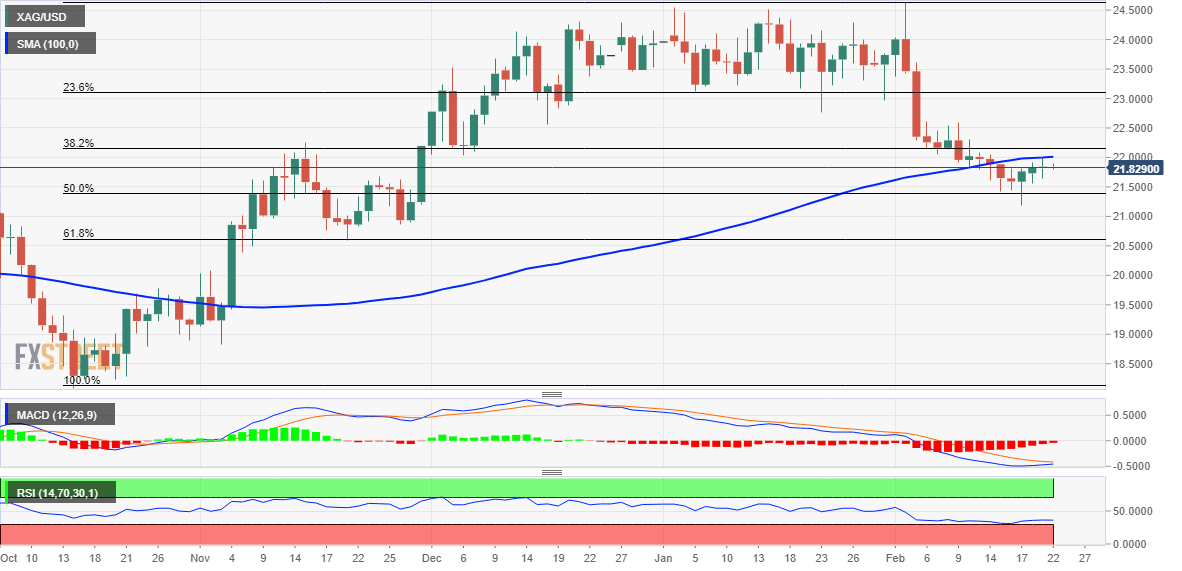
Key levels to watch
According to UOB Group’s Economist Lee Sue Ann and Markets Strategist Quek Ser Leang, GBP/USD is expected to maintain the 1.2000-1.2210 range in the next weeks.
Key Quotes
24-hour view: “The strong advance in GBP to a high of 1.2147 came as a surprise (we were expecting GBP to trade in a range). While overbought, the rapid rise could extend to 1.2165 before the risk of a pullback increases. The major resistance at 1.2210 is unlikely to come into view. Support is at 1.2065, followed by 1.2030.”
Next 1-3 weeks: “In our most recent narrative from Monday (20 Feb, spot at 1.2035), we indicated that ‘as long as the ‘strong resistance’ at 1.2100 is not breached within the next few days, there is still a slim chance for GBP to break below 1.1900’. Yesterday, GBP soared to a high of 1.2147. The breach of the ‘strong resistance’ level indicates that the weakness in GBP that started late last week (see annotations in the chart below) has ended. The current price movements appear to be part of a broad consolidation range and GBP is likely to trade between 1.2000 and 1.2210 for the time being.”
Considering advanced figures from CME Group for gold futures markets, open interest increased by nearly 47K contracts on Tuesday after three consecutive daily pullbacks. Volume followed suit and went up by almost 2K contracts, keeping the erratic performance well in place.
Gold could revisit the 2023 low near $1820
Tuesday’s retracement in gold prices was accompanied by increasing open interest and volume and is suggestive that extra weakness lies ahead for the yellow metal. Against that, the precious metal could retest the YTD low at $1818 per ounce troy (Friday 17).
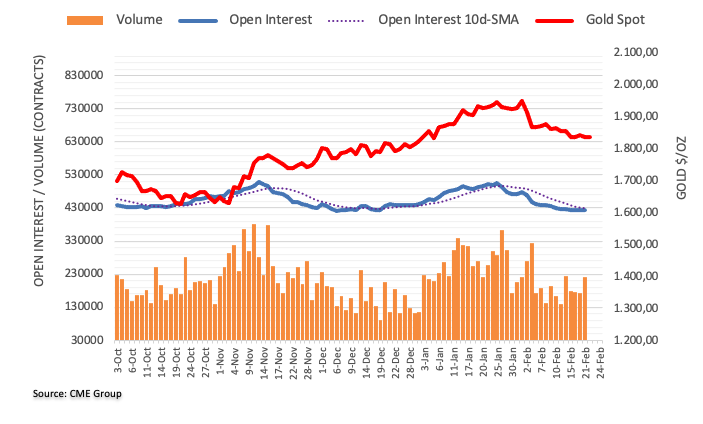
UOB Group’s Economist Lee Sue Ann and Markets Strategist Quek Ser Leang note EUR/USD faces extra weakness once 1.0615 is cleared.
Key Quotes
24-hour view: “Yesterday, we held the view that EUR ‘is likely to consolidate between 1.0660 and 1.0710’. Instead of consolidating, EUR traded in a relatively choppy manner as it popped to a high of 1.0697, dropped quickly to 1.0636 before closing at 1.0646 (-0.34%). Downward momentum has improved a tad and EUR is likely to edge lower. In view of the lackluster momentum, a sustained decline below the major support at 1.0615 is unlikely today. Resistance is at 1.0670, followed by 1.0695.”
Next 1-3 weeks: “In our latest narrative from two days ago (20 Feb, spot at 1.0685), we highlighted that ‘downward momentum has waned and the likelihood of a sustained decline in EUR below 1.0615 is not high’. Yesterday, EUR dropped to 1.0636 before settling at 1.0646 (-0.34%). Downward momentum has increased, albeit not much. While EUR could break below 1.0615, it has to stay below this level before further weakness is likely. Overall, only a breach of 1.0725 (‘strong resistance’ level previously at 1.0740) would indicate that the weakness in EUR that started late last week has stabilized. Looking ahead, the next support level below 1.0615 is at 1.0570.”
- WTI takes offers to renew intraday low, extends previous day’s fall.
- Clear U-turn from 100-SMA, downbeat MACD signals keep Oil bears hopeful.
- Buyers need validation from a multi-day-old downward-sloping resistance line.
WTI crude oil takes offers to extend the previous day’s losses to $76.00, refreshing the intraday low amid early Wednesday in Europe. In doing so, the black gold breaks a two-week-long ascending trend line, currently around $76.10.
The commodity’s latest weakness could be linked to its early-week retreat from the 100-bar Simple Moving Average (SMA). Adding strength to the Oil’s pullback moves could be the bearish MACD signals.
That said, WTI bears are well-set to poke the $75.00 round figure before approaching the monthly low surrounding $72.50.
It should be noted, however, that the Oil’s weakness past $72.50 could make it vulnerable to plunge toward the previous monthly low, also the lowest level since December 2021, near $70.30.
In a case where the energy benchmark remains bearish past $70.30, the $70.00 round figure appears crucial for the Oil bears to watch as it holds the key to further downside targeting the late 2021 swing low around $66.10.
Meanwhile, recovery moves need validation from the 100-bar SMA, close to $77.50 by the press time.
Even so, a convergence of the 61.8% Fibonacci retracement level of the commodity’s late January to early February fall and a downward-sloping resistance line from January 27, around $78.80-90, appears a tough nut to crack for the bulls.
Also acting as an upside filter is the $79.00 and multiple stops around the $80.00 psychological magnet.
WTI: Four-hour chart
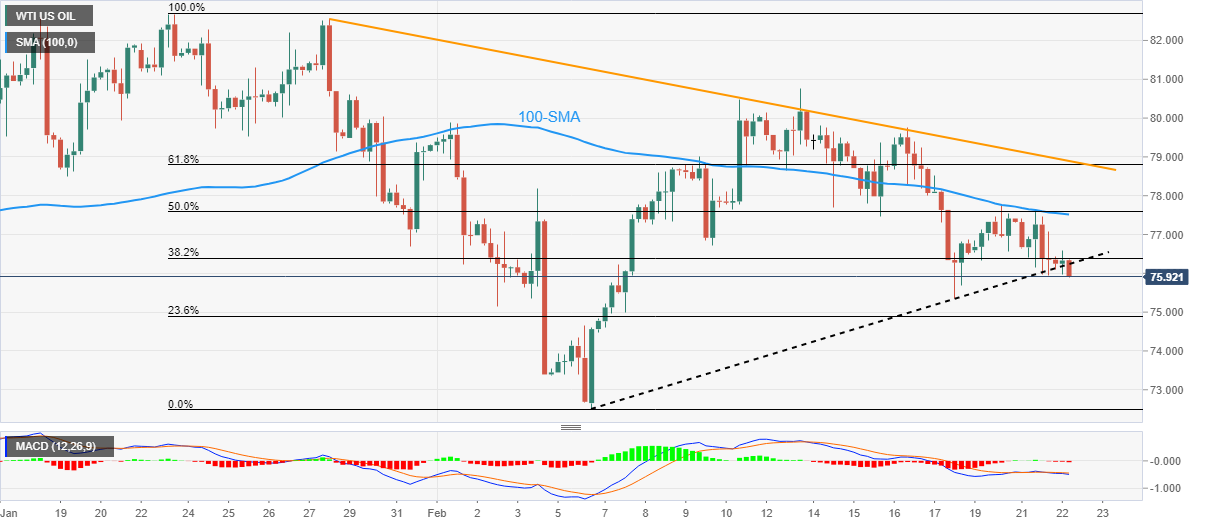
Trend: Further downside expected
An official at the South Korean Finance Ministry said on Wednesday, he “plans to meet FX dealers later on Wednesday and listen to the opinion on the current market situation.”
“Won's recent pace of weakening faster than other currencies,” the official added.
On Tuesday, Bank of Korea (BOK) Governor Rhee Chang-yong noted that they “will respond in a timely manner in case of uneasiness in financial and forex markets.”
Market reaction
USD/KRW is defending the $1,300 mark on the above comments, trading 0.24% lower on the day at $1,303, as of writing. The pair jumped to the highest level in two months at $1,314.53 on a broad-based US Dollar strength.
- NZD/USD is demonstrating a volatility contraction ahead of Federal Open Market Committee minutes.
- A recovery in the odds of policy tightening continuation by the Federal Reserve sent US Treasury yields on fire.
- Reserve Bank of New Zealand has hiked its Official Cash Rate by 50 bps to 4.75%.
- NZD/USD might display a sheer downside after surrendering the horizontal support plotted from 0.6190.
NZD/USD has turned sideways around 0.6230 in the early European session after wild movements showed post-hawkish monetary policy by the Reserve Bank of New Zealand (RBNZ). Volatility in the Kiwi asset has squeezed dramatically as investors have shifted their focus towards the release of the Federal Open Market Committee (FOMC) minutes, which are scheduled in the late New York session.
Investors’ risk-taking ability is improving gradually as the risk-sensitive assets have shown some recovery after observing sheer weakness on Tuesday. S&P500 futures have added some gains after recording the worst day of 2023. The US Dollar Index (DXY) is gradually marching towards 103.90. Weak momentum in the USD index could spoil the upside bias ahead. However, investors are expected to remain anxious ahead of the release of the FOMC minutes.
US yields print a three-month high after upbeat PMI figures
The tight labor market and solid monthly Retail Sales released this month already triggered fears of a rebound in the declining Consumer Price Index (CPI) in the United States. And, now upbeat preliminary S&P PMI (Feb) data have bolstered the case of a sheer revival in consumer spending. On Tuesday, the preliminary S&P Manufacturing PMI (Feb) climbed to 47.8 from the consensus of 47.3 and the former release of 46.9. The Services PMI soared to 50.5 from the estimates of 47.2 and the prior release of 46.8.
Economic activities in the United States were contracting in the past three months and investors started anticipating that the Federal Reserve (Fed) would consider a pause in the policy tightening spell this month. However, Fed chair Jerome Powell was reiterating that inflation is persistent and it would be premature to consider a pause or rate cut in the current monetary policy. Now, a sheer expansion in the scale of economic activities is conveying that the current monetary policy is not restrictive enough to tame stubborn inflation.
A recovery in the odds of policy tightening continuation by the Federal Reserve sent US Treasury yields on fire. The return generated on 10-year US Treasury bonds printed a fresh three-month high at 3.96%.
Federal Open Market Committee minutes hog the limelight
Investors are keenly awaiting the release of the Federal Open Market Committee (FOMC) minutes, which will provide a detailed explanation behind the 25 basis points (bps) interest rate hike by the Federal Reserve in its February monetary policy meeting. Apart from that, the minutes will determine what authorities are planning for the terminal rate and targets decided for inflation for the current year and a roadmap for achieving the 2% inflation target.
Recently, Cleveland Fed President Loretta Mester and St. Louis Fed President James Bullard have advocated for another 50 basis-point hike, which should be on the table for upcoming decisions, as reported by Bloomberg. A strong consideration for 50 bps rates might propel recession fears in the United States.
Reserve Bank of New Zealand hikes OCR by 50 bps to 4.75%
Inflationary pressures in the New Zealand economy have not peaked yet as the domestic demand is extremely solid. And Cyclone Gabrielle, considered as the worst storm, has created havoc that the price index could propel further. To strengthen the monetary tools in the battle against inflation, the Reserve Bank of New Zealand has hiked its Official Cash Rate (OCR) by 50 bps to 4.75%. In November monetary policy, Reserve Bank of New Zealand Governor Adrian Orr pushed interest rates by 75 bps.
A bumper rate hike was already expected by the RBNZ amid the fresh release of the helicopter money as New Zealand Prime Minister (PM) Chris Hipkins has promised a cyclone relief package of NZ$300 million ($187.08 million). Meanwhile, the labor market has started demonstrating devastating effects due to the continuation of policy tightening by the Reserve Bank of New Zealand.
In the monetary policy statement, Reserve Bank of New Zealand Governor Adrian Orr was loud and clear that the economy will see a recession in the period of nine to twelve months. He further added, “The central bank is encouraging savings by increasing deposit rates to avert inflation”. The central bank sees no evidence that inflation targets should be raised.
NZD/USD technical outlook
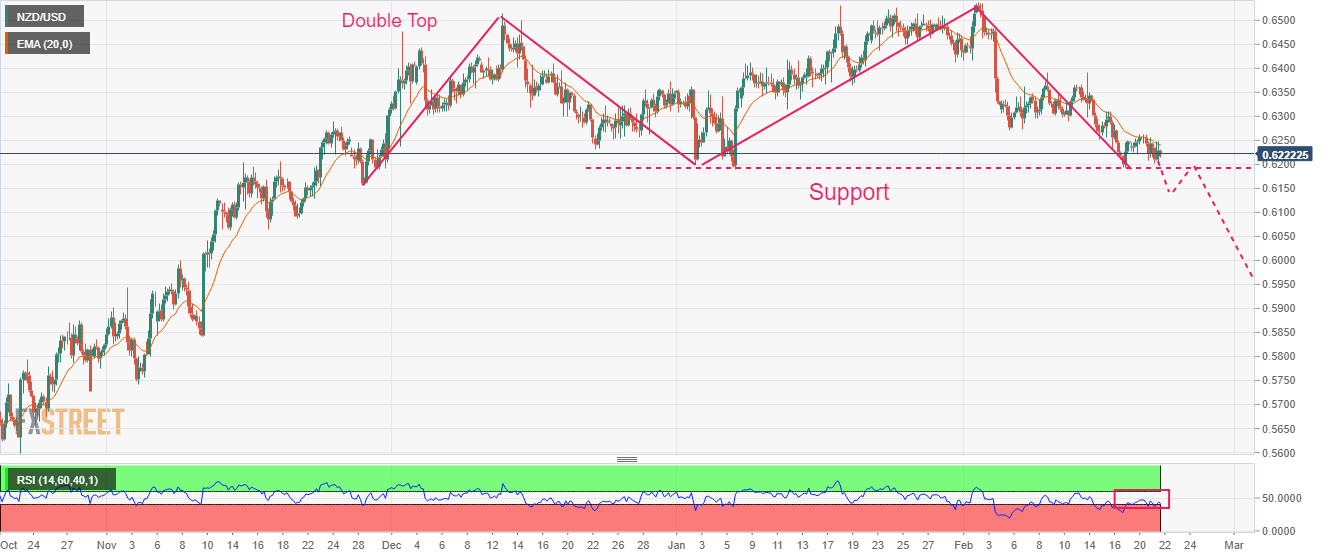
NZD/USD has been declining for the past few weeks after forming a Double Top chart pattern on a four-hour scale, which conveys a bearish reversal. The Kiwi asset has dropped to near the horizontal support plotted from January 6 low at 0.6190. A slippage below the above-mentioned horizontal support will trigger the downside momentum.
The 20-period Exponential Moving Average (EMA) at 0.6242 is acting as a major barricade for the New Zealand Dollar.
Meanwhile, the Relative Strength Index (RSI) (14) is on the verge of slipping into the bearish range of 20.00-40.00. An occurrence of the same will trigger a downside momentum.
- EUR/USD consolidates the first daily gains in three, retreats from intraday high of late.
- Strong EU data, hawkish ECB bets favor Euro buyers amid mixed sentiment.
- Geopolitical fears join upbeat US PMIs, yields to weigh on EUR/USD ahead of the key Fed Minutes.
- FOMC Minutes should stay away from chatters surrounding Fed’s policy pivot to keep bears hopeful.
EUR/USD extends pullback from intraday high to 1.0650 during the first positive day in three amid the early Wednesday.
That said, The Euro pair’s initial gains could be linked to the US Dollar’s retreat amid a cautious mood ahead of the Federal Open Market Committee’s (FOMC) Monetary Policy Meeting Minutes. Also adding strength to the EUR/USD run-up were the sluggish US Treasury bond yields after they refreshed a three-month high. Furthermore, concerns that the European Central Bank (ECB) will increase the benchmark rates to an all-time high also strengthened the pair’s rebound. However, the latest recovery in the bond coupons and receding optimism in the markets seem to weigh on the pair of late.
On Tuesday, Germany’s preliminary S&P Global/BME Manufacturing PMI for February unexpectedly dropped to 46.5 versus 47.8 expected and 47.3 previous readings. The Services counterpart, on the other hand, rose more than 51.0 expected to 51.3, compared to 50.7 prior. On the same line, Eurozone S&P Global Manufacturing PMI dropped to 48.5 for the said month, from 48.8 prior and versus 49.3 market forecasts. Further, the Services PMI rose to 53.0 from 51.0 expected and 50.8 previous readouts.
Overall, Germany’s Composite PMI improved to 51.1 from 49.9, compared 50.4 market forecast, whereas its Eurozone counterpart jumped to 52.3 versus 50.6 market forecasts and 50.3 prior. It should be noted that ZEW Survey for Germany and Eurozone were for upbeat for February. That said, ZEW Survey, Economic Sentiment rose to 28.1 and 29.7 for Germany and the bloc in that order, from 16.9 and 16.7 respectively.
It’s worth mentioning that the latest piece from the Financial Times (FT) highlights increasingly hawkish ECB bets to put a floor under the EUR/USD price. “Swap markets are pricing in a jump in the ECB’s deposit rate to 3.75 percent by September, up from the current 2.5 percent. That would match the benchmark’s 2001 peak, when the ECB was still trying to shore up the value of the newly launched Euro,” said FT.
On the other hand, US S&P Global Manufacturing PMI rose to 47.8 in February from 46.9 prior and versus 47.3 market forecasts while the Services PMI jumped to the eight-month high to 50.5 compared to 47.2 expected and 46.8 previous readings. As a result, the S&P Global Composite PMI surpassed 47.5 analysts’ consensus and 46.8 previous reading to mark 50.2 figure.
The strong data helped the FEDWATCH tool to suggest that the money market participants see the benchmark level peaking at 5.3% in July, and staying near those levels throughout the year, versus 5.10% expected by the US Federal Reserve (Fed).
Elsewhere, comments from US Secretary of State Antony Blinken and Russian President Vladimir Putin weigh on the market sentiment and the Gold price as both suggest further tension between Moscow and Kyiv, which also includes indirect participation of the West and China of late. Though, an absence of major updates in Asia seemed to have paused the risk-off mood and allowed the US Dollar bulls to take a breather earlier on Wednesday.
While portraying the mood, the US 10-year and two-year treasury bond yields seesaw around the three-month highs marked the previous day while S&P 500 Futures print mild gains despite Wall Street’s negative closing.
Looking ahead, the second version of Germany’s Harmonized Index of Consumer Prices (HICP) inflation gauge and IFO sentiment numbers could entertain EUR/USD traders ahead of the key Fed Minutes. That said, the signals for the Fed policy pivot will be enough to please the EUR/USD buyers.
Technical analysis
A daily closing below the 50-day Exponential Moving Average (EMA), around 1.0680 by the press time, keeps EUR/USD bears hopeful of refreshing monthly low, currently around 1.0610.
- USD/CHF pares the biggest daily gains in three weeks by reversing from golden Fibonacci ratio.
- Multiple trend lines, 200-SMA stand tall to challenge downside move, RSI conditions also suggest further grinding towards the north.
- Buyers seem to have a smooth road ahead of 0.9350 hurdle.
USD/CHF seesaws around 0.9265 as it consolidates the previous day’s gains with mild losses heading into Wednesday’s European session. In doing so, the Swiss Franc (CHF) pair makes a U-turn from the 61.8% Fibonacci retracement level, also known as the golden Fibonacci ratio, to pare the biggest daily jump since early February.
Even so, the most steady RSI (14), above 50, joins the bullish MACD signals, despite being sluggish of late, to keep the USD/CHF buyers hopeful.
That said, a one-week-old ascending trend line restricts the immediate downside of the USD/CHF pair near 0.9245.
Following that, the 50% Fibonacci retracement level and the 200-SMA could probe the bears around 0.9235 and 0.9220 in that order.
It’s worth noting that an upward-sloping support line from February 01, close to 0.9185 at the latest, appears the last defense of the USD/CHF bulls.
On the flip side, a clear break of the aforementioned key Fibonacci retracement level of 0.9275 could quickly propel the USD/CHF prices toward the 0.9300 round figure before highlighting the latest swing top near 0.9335.
Though, multiple hurdles near 0.9350 seem to challenge the USD/CHF pair’s upside past 0.9335, a break of which could easily challenge the previous monthly high surrounding 0.9490.
USD/CHF: Four-hour chart

Trend: Further upside expected
- USD/TRY bulls take a breather as markets turn cautious ahead of Fed Minutes.
- Mixed concerns on rate positions, earthquake at home challenges the Turkish Lira pair sellers.
- Upbeat US data underpins hawkish Fed bets but mention of policy pivot could weigh on prices.
- CBRT has been holding rates steady in the last three monetary policy meetings at 9.0%.
USD/TRY slides to $18.81, retreating from the all-time high marked the previous day, as the US Dollar eases ahead of the key Federal Open Market Committee’s (FOMC) Monetary Policy Meeting Minutes. Adding strength to the pullback moves could be the Turkish Lira (TRY) traders’ cautious mood before Thursday’s Central Bank of the Republic of Türkiye (CBRT) Interest Rate Decision.
It should be noted that the earthquake in Turkiye and Syria appeared the latest worry for the nations. However, the Turkish inflation eased in the last two months and hence defends the CBRT’s latest inaction surrounding the 9.0% interest rate.
On the other hand, strong prints of the preliminary US S&P Global PMIs for February joined the hawkish Fed bets to underpin the US Dollar Index’s first daily positive in three the previous day, down 0.07% intraday near 104.11 at the latest.
It’s worth observing that the monetary policy divergence between the US Federal Reserve (Fed) and the CBRT appears the biggest driver for the USD/TRY upside.
Elsewhere, comments from US Secretary of State Antony Blinken and Russian President Vladimir Putin weigh on the market sentiment and tease USD/TRY bulls as both suggest further tension between Moscow and Kyiv, which also includes indirect participation of the West and China of late. Though, an absence of major updates in Asia seemed to have paused the risk-off mood.
Against this backdrop, the US 10-year and two-year treasury bond yields seesaw around the three-month highs marked the previous day while S&P 500 Futures print mild gains despite Wall Street’s negative closing.
Looking forward, Turkish Capacity Utilization and Manufacturing Confidence for February could entertain USD/TRY traders ahead of the Fed Minutes. However, major attention will be given to Thursday’s CBRT Interest Rate decision for clear directions.
Technical analysis
Overbought RSI joins the $19.00 psychological magnet to challenge the USD/TRY bulls. The downside moves, however, remain elusive unless providing a daily closing below the 50-DMA support near $18.75.
- GBP/USD is confidently shifting its business above 1.2100 amid a recovery in the risk appetite theme.
- Consideration of a 50 bps rate hike in the FOMC minutes could stem the dismal market mood.
- The UK economy is avoiding recession, however, chances of further escalation in CPI are accelerating.
The GBP/USD pair is building the auction platform above the round-level support of 1.2100 in the Asian session. The Cable is getting some strength as the risk appetite of the market participants is improving gradually.
S&P500 futures have firmly rebounded after an intense sell-off on Tuesday, portraying a sense of optimism in the overall negative market mood. The US Dollar Index (DXY) is struggling to extend its recovery above 103.80. Also, the 10-year US Treasury yields have dropped marginally below 3.94%.
Investors should brace for a volatility explosion after the release of the Federal Open Market Committee (FOMC) minutes. The release of the FOMC minutes will provide a detailed explanation behind the 25 basis points (bps) interest rate hike in the first week of February. The context that will be keenly watched by the market participants is the guidance on the interest rates.
Two hawkish policymakers, Cleveland Fed President Loretta Mester and St. Louis Fed President James Bullard cited last week that they saw the case for doing another 50 basis-point hike at the meeting and that such larger moves should still be on the table for upcoming decisions, as reported by Bloomberg. And, consideration of a 50 bps rate hike could stem dismal market mood.
On the United Kingdom front, rising uncertainty over the Northern Ireland Protocol (NIP) is impacting the Pound Sterling. The context might be compromised this week, however, the impact on the economic outlook of the UK will be observed after a few months. Meanwhile, Conservative rebels are continuously opposing the proposal.
Meanwhile, Tuesday’s upbeat preliminary UK PMI data cleared that retail demand is solid and the labor demand will stay for longer. No doubt, the economy is confidently avoiding recession, however, the chances of further escalation in the inflationary pressures are accelerating. Economists at UOB Group are expecting 25bps hikes at the next 2 meetings on 23 Mar and 11 May by the Bank of England (BOE), seeing the Bank Rate peak at 4.5%.
- USD/CAD seesaws around six-week high after rising the most in three weeks the previous day.
- Descending resistance line from early November 2022 guards immediate upside.
- Upside break of 100-DMA, four-month-old trend line keeps buyers hopeful.
USD/CAD grinds near a 1.5-month high during early Wednesday, after crossing the key moving average and resistance line the previous day.
That said, the Loonie pair struggles to defend USD/CAD bulls as a downward-sloping resistance line from early November 2022, close to 1.3555 at the latest, challenges the immediate upside of the quote.
The upbeat performance of the USD/CAD price could be linked to the strong RSI (14), not overbought.
It should be noted, however, that the January 2023 peak surrounding 1.3685 and late 2022 top near 1.3705, could act as the last defense of the USD/CAD bears.
As a result, the USD/CAD upside appears to have limited room towards the north.
Meanwhile, a daily closing below the 100-DMA and the previous resistance line from early October 2022, respectively near 1.3515 and 1.3505, precede the 1.3500 round figure and could recall the USD/CAD bears.
Following that, the 50% Fibonacci retracement level of the pair’s August-October 2022 upside, near 1.3355, will challenge the USD/CAD bears before directing them to the 200-DMA and the 61.8% Fibonacci retracement level of 1.3210, also known as golden Fibonacci ratio.
Overall, USD/CAD remains on the bear’s radar even as the road to the north appears bumpy.
USD/CAD: Daily chart
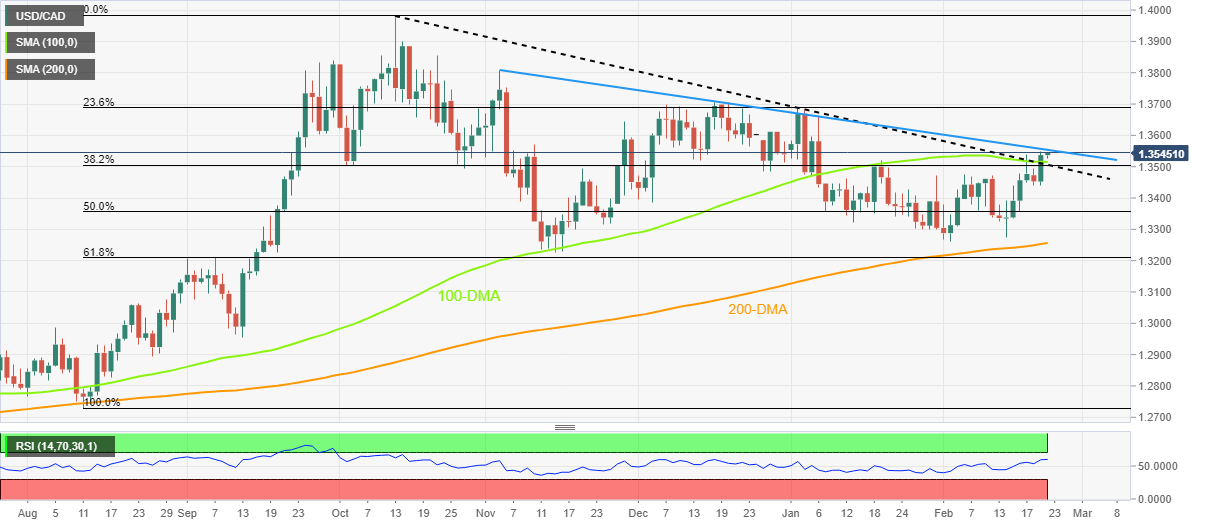
Trend: Further upside expected
- Gold price seesaws inside one-week-old trading range between 50-day EMA and 100-day EMA.
- Cautious mood ahead of FOMC Minutes, geopolitical fears surrounding Russia, China keeps XAU/USD bears hopeful.
- Fed Minutes should push back policy pivot talks to please Gold sellers.
Gold price (XAU/USD) probes a two-day downtrend as it treads water around $1,835 during early Wednesday. In doing so, the bright metal remains inside the weekly trading range of around $30.00 as traders await the Federal Open Market Committee’s (FOMC) Monetary Policy Meeting Minutes. It’s worth noting that the geopolitical fears and the US Dollar’s lackluster moves around the multi-day top seem to add filters to the XAU/USD traders.
That said, firmer prints of the preliminary US S&P Global PMIs for February joined the hawkish Fed bets to underpin the US Dollar Index’s first daily positive in three the previous day, down 0.07% intraday near 104.11 at the latest.
However, the US Treasury bond yields’ lackluster moves around the three-month high, marked the previous day, seem to restrict the XAU/USD momentum of late.
Also likely to probe the Gold traders could be the hawkish bias surrounding the US Federal Reserve (Fed) and looming policy pivot chatters.
Furthermore, comments from US Secretary of State Antony Blinken and Russian President Vladimir Putin weigh on the market sentiment and the Gold price as both suggest further tension between Moscow and Kyiv, which also includes indirect participation of the West and China of late. Though, an absence of major updates in Asia seemed to have paused the risk-off mood.
Amid these plays, the US 10-year and two-year treasury bond yields seesaw around the three-month highs marked the previous day while S&P 500 Futures print mild gains despite Wall Street’s negative closing.
Looking ahead, mixed mood and caution ahead of the FOMC Minutes can keep XAU/USD on a dicey floor but the signals for Fed policy pivot will be enough to recall the Gold buyers.
Gold price technical analysis
Gold price remains inactive between the 100-day Exponential Moving Average (EMA) and 50-day EMA following its break of the three-month-old support line, now resistance. Adding strength to the downside bias are the bearish MACD signals and a two-week-old descending trend line.
It’s worth noting, however, that the nearly oversold conditions of RSI (14) highlight the importance of the 100-day EMA level of $1,821 as the key support.
On the contrary, a downward-sloping resistance line from February 09, close to $1,838 restricts the XAU/USD’s immediate upside ahead of the 50-day EMA, near $1,853 by the press time.
Hence, the Gold price stays on the bear’s radar unless breaking the support-turned-resistance line from late November, close to $1,916, but the room for metal appears limited.
Gold price: Daily chart
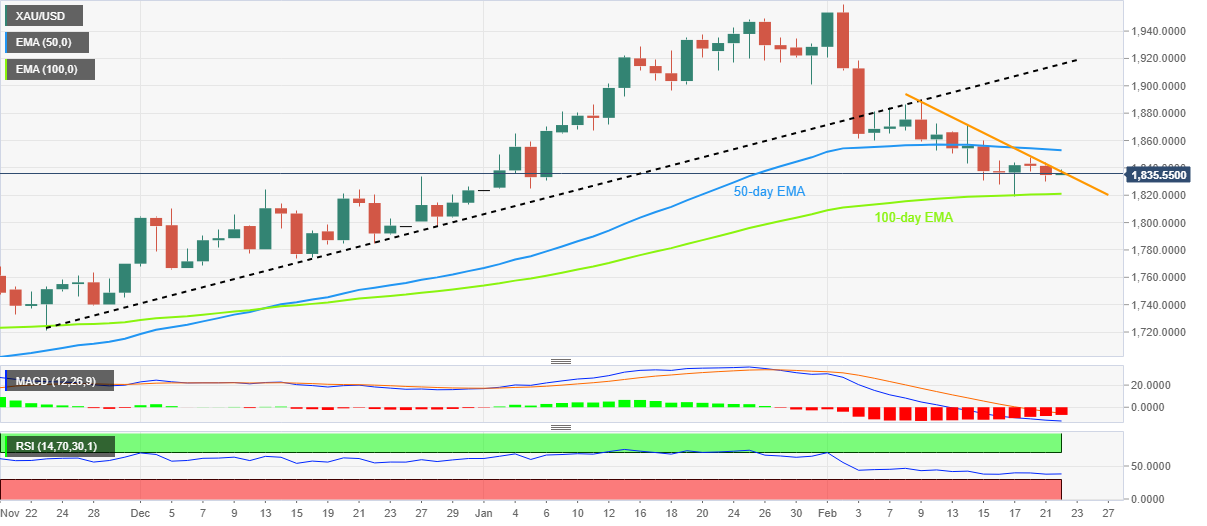
Trend: Further downside expected
- USD/INR is aiming to shift its auction profile above 82.80 amid recovery attempts by the USD Index.
- Investors are expected to remain anxious ahead of the release of the FOMC minutes.
- The 10-year US Treasury yields have dropped marginally to near 3.94% after printing a fresh three-month high of 3.96%.
The USD/INR pair is attempting to surpass the immediate resistance of 82.80 in the Asian session. The asset is expected to yet discount the impact of the overnight jump in the US Treasury yields, supported by upbeat preliminary S&P United States PMI data.
The preliminary S&P Manufacturing PMI (Feb) climbed to 47.8 from the consensus of 47.3 and the former release of 46.9. The Services PMI soared to 50.5 from the estimates of 47.2 and the prior release of 46.8. A rebound in economic activities is bolstering the case of further policy tightening by the Federal Reserve (Fed). No doubt, the expansionary economic activities indicate that consumer spending is recovering again and it could trigger a pause in the inflation softening in the United States.
The US Dollar Index (DXY) has attempted a rebound after a corrective move to near 103.70. The USD Index is aiming to recapture Tuesday’s high around 103.90 as investors are expected to remain anxious ahead of the release of the Federal Open Market Committee (FOMC) minutes.
S&P500 futures have shown a recovery move after a super-bearish Tuesday. The situation is not ripe for building longs in the risk-sensitive assets as the overall market mood is favoring the risk aversion theme. Meanwhile, the 10-year US Treasury yields have dropped marginally to near 3.94% after printing a fresh three-month high of 3.96% on Tuesday.
On the Indian Rupee front, rising chances of a further hike in the repo rate managed by the Reserve Bank of India (RBI) could support the Indian Rupee. Inflationary pressures in the Indian economy have not been trimmed yet, therefore, the RBI might favor the continuation of the 25 bps rate hike spell ahead.
- EUR/USD has rebounded above 1.0660 as the risk appetite of the market participants has improved.
- The formation of the Symmetrical Triangle below the 61.8% Fibo retracement is indicating a volatility contraction.
- ECB Lagarde has confirmed the continuation of the 50 bps interest rate hike ahead.
The EUR/USD pair has sensed a buying interest after dropping to near 1.0640 in the Asian session. The major currency pair has rebounded as the risk appetite of the market participants has improved. The US Dollar Index (DXY) is struggling to recover after a corrective move amid a rebound in the risk-on mood, however, it would be early considering the positive risk impulse extremely solid as investors are awaiting the release of the Federal Open Market Committee (FOMC) minutes.
S&P500 futures have some decent gains in the Asian session after an intense sell-off on Tuesday. Long weekend-inspired volatility and upbeat preliminary United States S&P PMI figures were sufficient to force investors to dump US stocks.
On the Eurozone front, European Central Bank (ECB) President Christine Lagarde clearly announced “Headline inflation has begun to slowdown but reiterated that they intend to raise the key rates by 50 basis points (bps) at the upcoming policy meeting. She also cited that the central bank is not seeing a wage-price spiral in the Eurozone.
EUR/USD is continuously facing barricades around the 61.8% Fibonacci retracement (placed from January 6 low at 1.0483 to February high at 1.1033) at 1.0693. The formation of the Symmetrical Triangle chart pattern is indicating a volatility contraction in the asset.
The 100-period Exponential Moving Average (EMA) at around 1.0700 will continue to act as a major barricade for the Euro bulls.
Meanwhile, the Relative Strength Index (RSI) (14) is on the verge of slipping into the bearish range of 20.00-40.00. An occurrence of the same will trigger a downside momentum.
A decisive downside move below February 17 low at 1.0613 will drag the asset toward December 22 low at 1.0573. A slippage below the latter will extend the downside toward January 6 low at 1.0483.
In an alternate scenario, a break above February 16 high at 1.0722 will drive the asset toward 50% Fibo retracement at 1.0758, followed by February 14 high around 1.0800.
EUR/USD two-hour chart
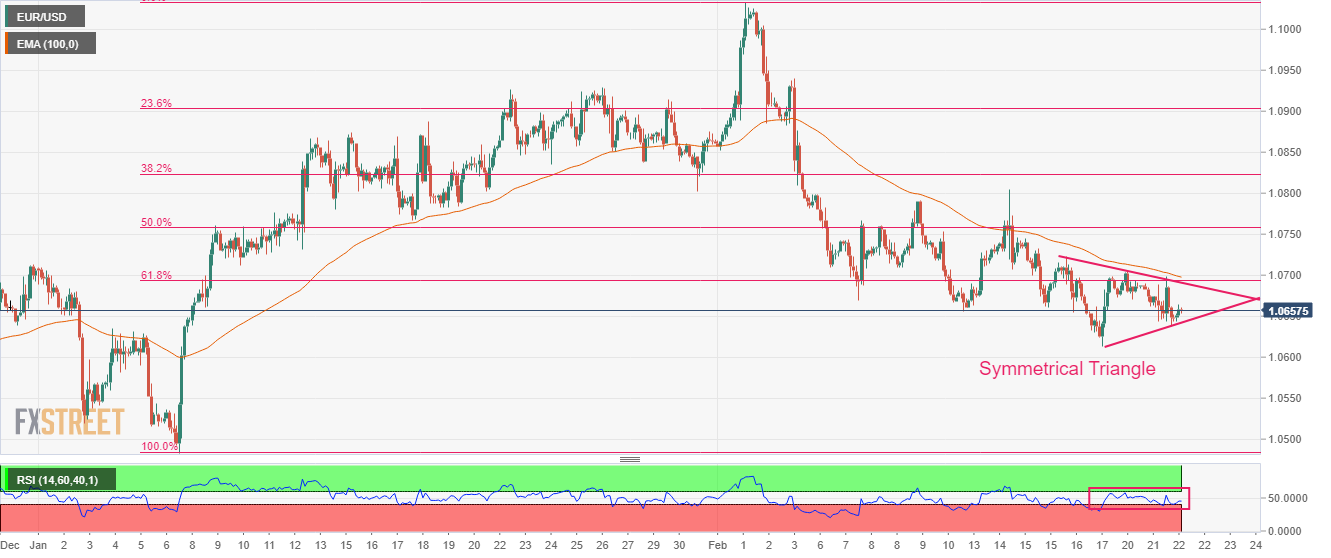
- AUD/USD renews intraday low, extends the previous day’s losses as softer Aussie data joins cautious mood.
- Australia’s Westpac Leading Index reprints -0.1% for January, Q4 Wage Price Index eased.
- Upbeat US data, firmer yields and hawkish Fed bets escalate anxiety ahead of FOMC Minutes.
AUD/USD drops 0.6835 as it stays on the bear’s radar for the second consecutive day ahead of the all-important Federal Open Market Committee’s (FOMC) Monetary Policy Meeting Minutes early Wednesday. In doing so, the Aussie pair not only portrays the market’s cautious mood but also bears the burden of downbeat data at home, as well as strong US statistics.
That said, Australia’s Westpac Leading Index marked -0.1% figure in January, the second time in a row, whereas the fourth quarter (Q4) Wage Price Index eased to 0.8% QoQ versus 1.0% expected and prior.
On the other hand, the preliminary US S&P Global Manufacturing PMI rose to 47.8 in February from 46.9 prior and versus 47.3 market forecasts while the Services PMI jumped to the eight-month high to 50.5 compared to 47.2 expected and 46.8 previous readings.
The strong data helped the FEDWATCH tool to suggest that the money market participants see the benchmark level peaking at 5.3% in July, and staying near those levels throughout the year, versus 5.10% expected by the US Federal Reserve (Fed).
It should be noted that the AUD/USD pair’s risk barometer status also keeps it weak amid the geopolitical concerns surrounding China and Russia. The comments from US Secretary of State Antony Blinken and Russian President Vladimir Putin were the top catalysts that weigh on the market sentiment as both suggest further tension between Moscow and Kyiv, which also includes indirect participation of the West and China of late.
While portraying the mood, the US 10-year and two-year treasury bond yields seesaw around the three-month highs marked the previous day while S&P 500 Futures print mild gains despite Wall Street’s negative closing.
Moving on, a light calendar ahead of the Fed Minutes can keep the AUD/USD on the bear’s radar and hence further declines toward Friday’s low of 0.6811, also the lowest level in six weeks, can’t be ruled out. However, the Minutes’ signal that the Fed policymakers discussed pivot, may quickly trigger the Aussie pair’s rebound.
Technical analysis
A daily closing below 200-day Exponential Moving Average (EMA), around 0.6860 by the press time, directs AUD/USD bears to poke a three-month-old ascending support line, close to 0.6820 at the latest, a break of which becomes necessary for the Aussie sellers to keep the reins.
- USD/JPY snaps three-day uptrend as it reveres from two-month-old resistance line.
- Overbought RSI (14) conditions also favor the pullback move.
- Convergence of previous resistance line from January, three-week-old ascending trend line restricts immediate downside.
USD/JPY bulls take a breather as the quote drops to 134.70 while printing the mild losses, the first in four days, during early Wednesday. In doing so, the Yen pair portrays a U-turn from the upward-sloping resistance line from late December 2022.
Given the overbought RSI (14) also assenting to the USD/JPY pullback, the intraday sellers are likely to have a bit longer good time.
However, a convergence of the monthly resistance-turned-support line and an upward-sloping trend line from February 03, close to 134.00 at the latest, appears a tough nut to crack for the USD/JPY bears.
In a case where the Yen pair sellers manage to conquer the 134.00 key support, the odds of witnessing a slump toward the 200-SMA level surrounding 131.00 can’t be ruled out. It should be observed that six-week-long horizontal support near 132.90 can act as a buffer during the anticipated fall towards 131.00.
On the contrary, buyers need a successful break of the aforementioned multi-day-old resistance line from the last December, close to 135.20 by the press time, to keep the reins.
Following that, the late 2022 peak surrounding 138.20 and the 140.00 psychological magnet may gain the market’s attention.
USD/JPY: Four-hour chart
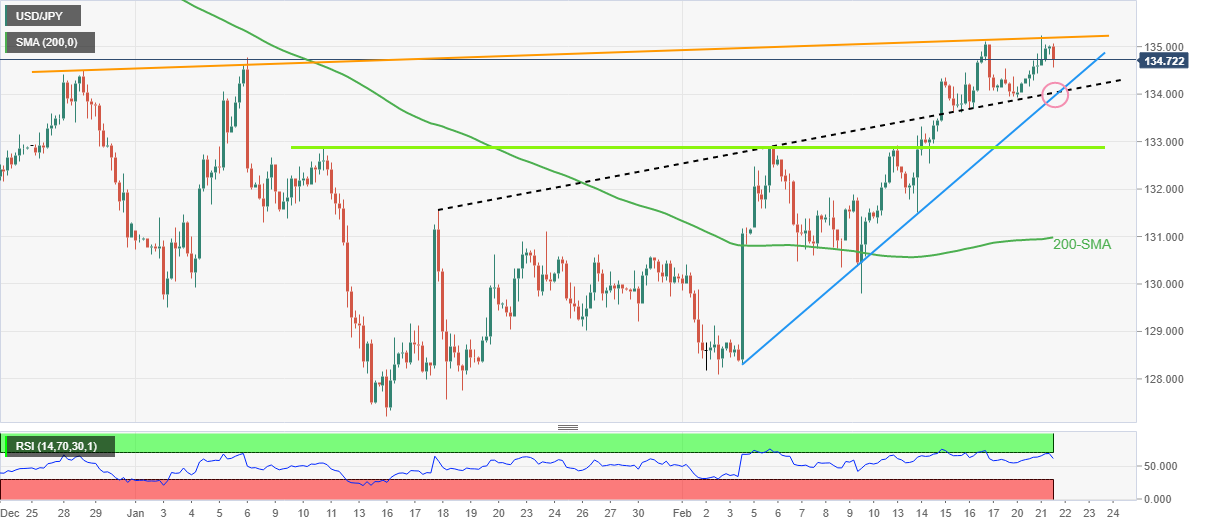
Trend: Limited downside expected
| Raw materials | Closed | Change, % |
|---|---|---|
| Silver | 21.839 | 0.11 |
| Gold | 1834.93 | -0.39 |
| Palladium | 1522.2 | 0.97 |
- NZD/USD extends pullback from intraday high as RBNZ Governor Adrian Orr speaks.
- RBNZ matched market forecasts of 0.50% rate hike but Governor Orr sounds cautiously optimistic.
- Mixed sentiment ahead of FOMC Minutes also challenge NZD/USD bulls.
NZD/USD retreats to 0.6225 as it consolidates the Reserve Bank of New Zealand (RBNZ) inspired gains on Governor Adrian Orr’s unimpressive presser during early Wednesday. The market’s cautious mood ahead of the Federal Open Market Committee’s (FOMC) Monetary Policy Meeting Minutes also probes the Kiwi pair buyers of late.
After RBNZ announced its 10th rate hike and showed readiness for more such measures, Governor Adrian Orr stated that they continue to forecast a 9-12 month recession. The policymaker also said that the demand must slow significantly. The same raises doubts about the future rate hikes of the New Zealand central bank, which in turn probe the NZD/USD bulls.
On the other hand, recently hawkish Fed bets join the chatters surrounding policy pivot at the US central bank to highlight the importance of today’s FOMC Minutes. As a result, the global markets appear more cautious ahead of the event and the same cap the Kiwi pair prices.
Elsewhere, comments from US Secretary of State Antony Blinken and Russian President Vladimir Putin were the top catalysts that weigh on the market sentiment as both suggest further tension between Moscow and Kyiv, which also includes the West and China of late. The same challenge the NZD/USD buyers due to New Zealand’s close ties with China and dependence on commodities.
It should be noted that the US Dollar Index (DXY) grinds near 104.15 after rising the most in a week the previous day after US data propelled hawkish Fed bets and the Treasury bond yields.
That said, the preliminary US S&P Global Manufacturing PMI rose to 47.8 in February from 46.9 prior and versus 47.3 market forecasts while the Services PMI jumped to the eight-month high to 50.5 compared to 47.2 expected and 46.8 previous readings. As a result, the S&P Global Composite PMI surpassed 47.5 analysts’ consensus and 46.8 previous reading to mark 50.2 figure. The strong data helped the FEDWATCH tool to suggest that the money market participants see the benchmark level peaking at 5.3% in July, and staying near those levels throughout the year, versus 5.10% expected by the US Federal Reserve (Fed).
Against this backdrop, the US 10-year and two-year treasury bond yields seesaw around the three-month highs marked the previous day while S&P 500 Futures print mild gains despite Wall Street’s negative closing.
Moving on, NZD/USD remains at the mercy of the risk catalysts ahead of the Fed Minutes as bulls appear less convinced.
Technical analysis
NZD/USD remains a bit far from the seller’s radar even as bearish MACD signals and a three-week-old descending trend line portray the Kiwi pair’s recent south-run.
Also challenging the NZD/USD bears is a convergence of the 100-DMA and 200-DMA, near 0.6170 by the press time.
However, the recovery moves need validation from the aforementioned resistance line from February 02, close to 0.6285 by the press time, to aim for the previous weekly high of 0.6390.
Meanwhile, a downside break of the stated DMA confluence, near 0.6170, could quickly drag the NZD/USD price towards the mid-November 2022 low near 0.6065.
To sum up, NZD/USD is likely to grind lower around the stated moving averages.
NZD/USD: Daily chart
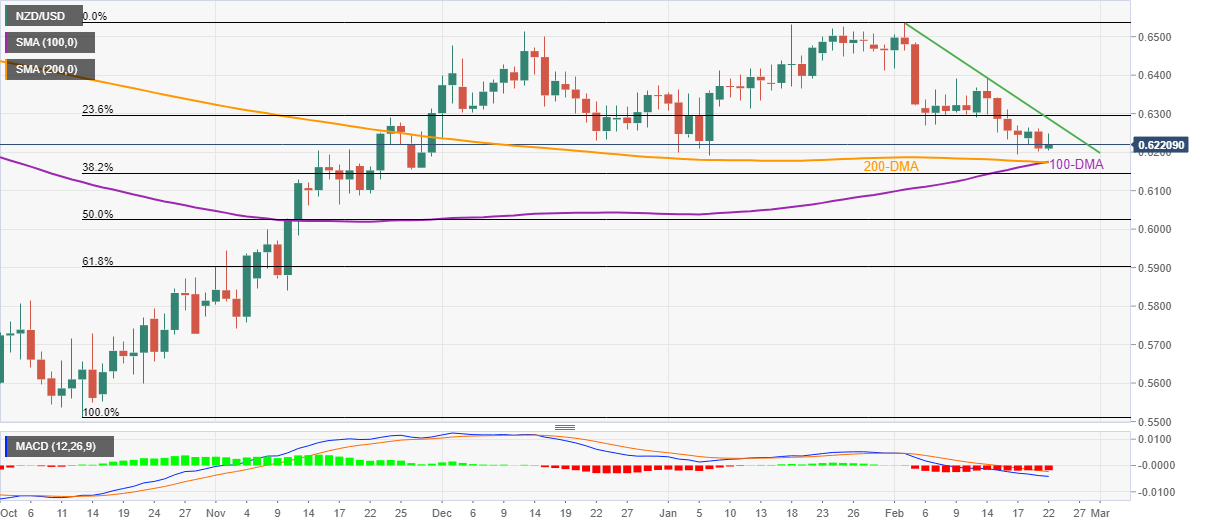
Trend: Limited downside expected
Reserve Bank of New Zealand (RBNZ) Governor Adrian Orr is speaking at the February post-monetary policy meeting press conference this Wednesday, sticking with the central bank’s hawkish outlook following a 50 basis points (bps) Official Cash Rate (OCR) rate hike announcement.
Key quotes
"We are still predicting a recession over a 9-12 month period."
“Too early to determine impact of Cyclone Gabrielle.”
“Prices for some goods are likely to spike in the weeks ahead.”
“Demand must slow significantly.”
“Increased deposit rates will promote savings.”
“More savings will relieve inflationary pressures.”
“Discussions heavily focussed on 50bp hike.”
“All options remain on the table including 25, 50 and 75 bps hikes.”
“Demand for labour has increased due to the impact of the cyclone.”
“Very little discussion of a 25bp rate hike, most focus was on 50bp.”
“There are early signs of easing spending.”
“Core inflation will gradually decline.”
“We estimate that rebuild will increase gdp by 1% over time.”
Meanwhile, RBNZ's Chief Economist Paul Conway said that “near-term price pressures will stay high.”
Additional comments
The economy is severely capacity constrained.
There is possibility for rebuilding to fan inflation.
-
NZD/USD pares RBNZ-led gains above 0.6170 support confluence as Governor Orr utters recession
Bank of Japan (BoJ) board member Naoki Tamura is speaking at a scheduled event on Wednesday, noting that “Japan's consumer inflation is likely to slow pace of increase towards the latter half of next fiscal year.”
Additional quotes
For now, we must carefully, humbly look at how markets will stablize, to what extent market functions will improve.
Widening of yield band in Dec was not aimed at tightening monetary policy.
Financial transmission function being smoothly exerted for now.
Personally feel that prolonged, massive easing may have curbed effect of market mechanism.
At some point in the future, BoJ must conduct assessment of monetary policy framework, feasibility of its policy by looking at balance of benefits, costs.
But for now, it is appropriate to maintain easy monetary policy.
Japan's economy likely to recovery but uncertainty regarding outlook is extremely high.
What's unique about recent price rises is that it is driven by change in corporate price-setting behaviour.
There is a risk inflation could overshoot expectations.
Japan has yet to see conditions where our 2% inflation is stably, sustainably achieved.
What's important is whether positive economic cycle is achieved, in which price rises are accompanied by higher corporate profits, wage increases.
I see fairly good chance strong wage hikes will be achieved in spring wage negotiations.
Market reaction
The USD/JPY pair keeps its recovery mode intact toward 135.00 on the dovish comments. The spot is trading at 134.75, down 0.18% on the day.
- GBP/USD picks up bids to renew intraday high, grinds near the previous daily top.
- 50-DMA caps Cable pair prices in the last three weeks.
- Looming bulls cross on MACD, sustained trading beyond 200-DMA favor buyers.
- One-month-old descending trend line adds to the upside filters.
GBP/USD sticks to mild gains around 1.2130, up 0.20% intraday, as bulls attack the 50-DMA resistance early Wednesday.
In doing so, the Cable pair extends its previous weekly rebound from the 200-DMA while making rounds to Tuesday’s high surrounding 1.2150.
It should be noted that the pair’s successful trading above 200-DMA joins the impending bull cross on the MACD to keep GBP/USD buyers hopeful.
That said, the 50-DMA and a downward-sloping resistance line from late January, respectively near 1.2160 and 1.2200, restrict short-term GBP/USD upside.
Following that, the last weekly top surrounding 1.2270 could probe the GBP/USD buyers before directing them to the multiple tops marked around 1.2445-50.
On the contrary, pullback moves may initially aim for the 1.2100 and 1.2050 support levels ahead of highlighting the 200-DMA level of 1.1935.
Should the GBP/USD bears dominate past 1.1935, January 2023 low near 1.1840 and the 61.8% Fibonacci retracement level of the pair’s November 2022 to February 2023 upside, near 1.1645, will be in the spotlight.
To sum up, GBP/USD remains on the front foot but the pair’s further upside needs validation from the 50-DMA and aforementioned monthly resistance line.
GBP/USD: Daily chart
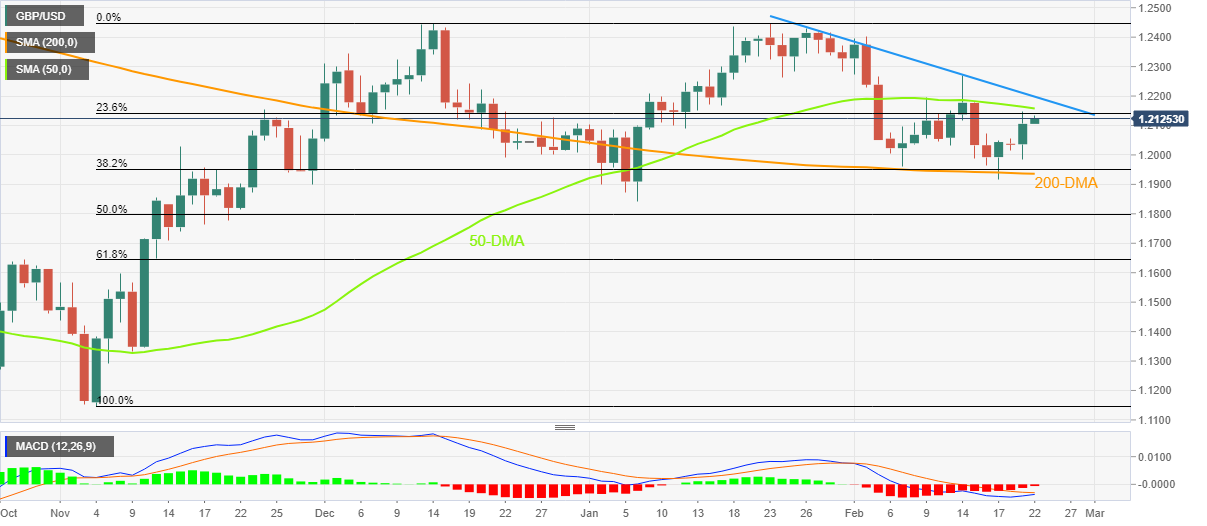
Trend: Further upside expected
Bank of Japan's board member Naoki Tamura has crossed the wires and said that the central bank is currently at a point where it must closely monitor whether Japan can accomplish a positive cycle of rising salaries and inflation.
Further comments
A policy review is required at some point in the future.
It is appropriate to maintain monetary easing.
It will take more time to assess the impact of the Bank of Japan's actions thus far on market function.
USD/JPY update
A rally in US bond yields had been supporting the pair but the Yen is firming in Asia and headed towards a test of the 134.50s.
134.50 is a key structure level:
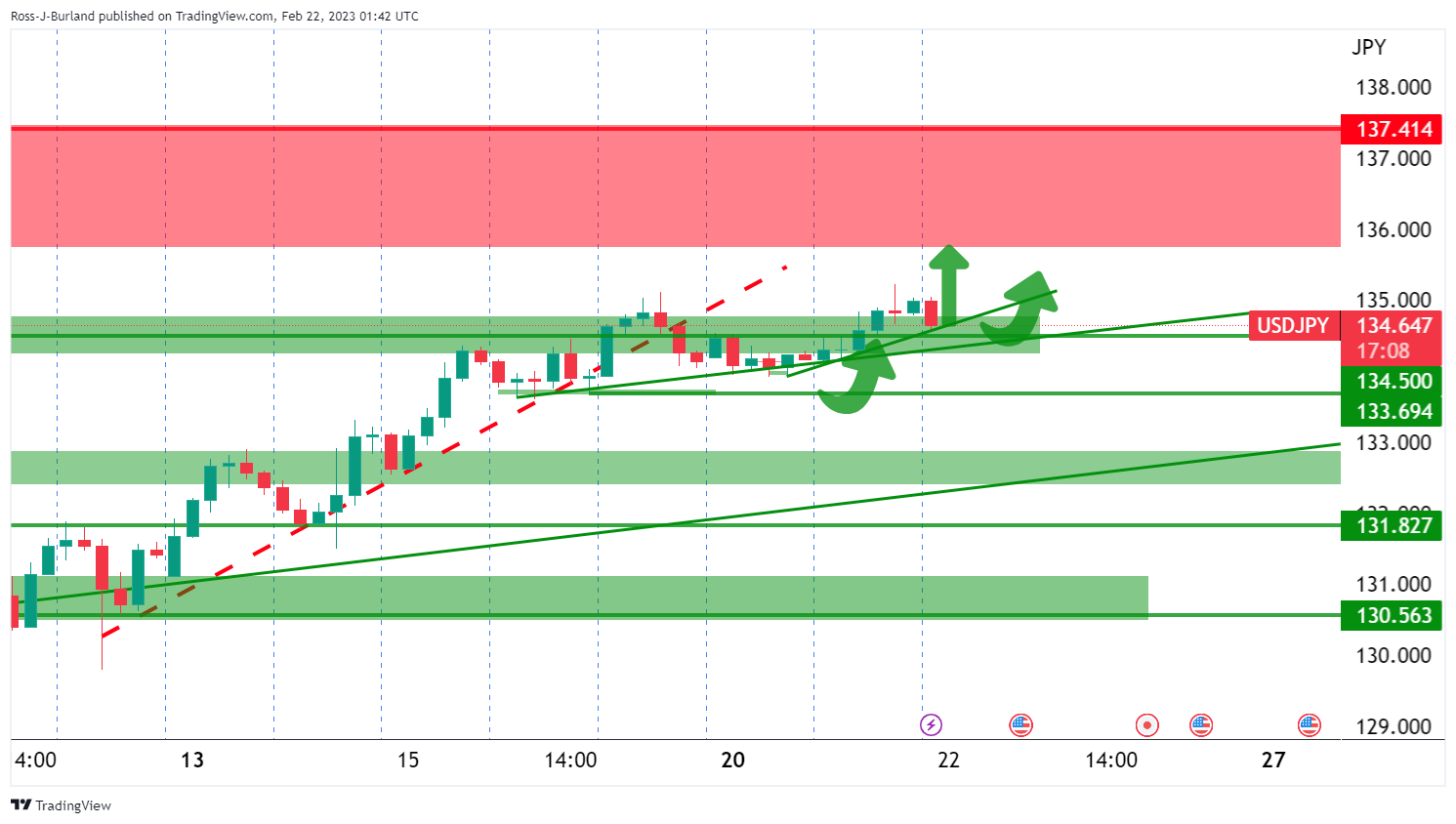
- Gold price has scaled above $1,840.00 as the USD Index has sensed a minor correction.
- Investors will look for cues that will provide guidance on terminal rate and inflation projections from the FOMC minutes.
- Gold price is auctioning in a Symmetrical Triangle chart pattern that indicates a sheer volatility contraction.
Gold price (XAU/USD) has attempted a break above $1,838.00 despite the anxiety among the market participants ahead of the release of the Federal Open Market Committee (FOMC) minutes. The precious metal is broadly showing a volatility contraction as investors are refraining themselves from building aggressive positions ahead of the FOMC minutes release.
Some gains have been scored by the S&P500 futures after the index dived on Tuesday amid fears that the Federal Reserve’s (Fed) monetary policy is not restrictive enough to tame the stubborn inflation. However, the market participants still need to be precautionary as the overall market mood is quite risk-averse.
The US Dollar Index (DXY) is attempting to rebound after a mild correction to near 103.70. Meanwhile, the yields on US government bonds have corrected minutely. The 10-year US Treasury yields have dropped below 3.95%, however, the upside seems favored amid hawkish Fed bets.
Investors are shifting their focus completely towards the release of the FOMC minutes, which will provide a detailed explanation of the 25 bps interest rate hike in February’s monetary policy meeting. Apart from that, investors will look for cues that will provide guidance on terminal rate and inflation projections for the mid-term and for a longer horizon.
Gold technical analysis
Gold price is auctioning in a Symmetrical Triangle chart pattern that indicates a sheer volatility contraction on an hourly scale. The downward-sloping trendline of the above-mentioned chart pattern is placed from February 20 high at $1,847.59 while the upward-sloping trendline is placed from February 17 low at $1,818.93.
The 20-period Exponential Moving Average (EMA) at $1,836.33 is overlapping on the asset price, which indicates indecisiveness in the sentiment of the market participants.
Meanwhile, the Relative Strength Index (RSI) (14) is oscillating in the 40.00-60.00, which signals a lackluster performance ahead.
Gold hourly chart

- NZD/JPY renews intraday high, jumps 40 pips on RBNZ rate hike.
- RBNZ matches market forecasts of 50 bps rate lift by increasing benchmark rate to 4.75%.
- Yields grind near three-month high ahead of US Fed Minutes.
- Geopolitical risks emanating from China, Russia should be eyed for clear directions.
NZD/JPY bulls flirt with the 84.00 threshold, after cheering a jump to 84.22, as they reassess the Reserve Bank of New Zealand (RBNZ) headlines early Wednesday. Also challenging the pair buyers could be the recently sluggish Treasury bond yields.
RBNZ announced its 10th rate hike as the policymakers struggle to tame the inflation fears, cutting the benchmark rate by 0.50% to 4.75%. Following the RBNZ decision, the quarterly Rate Statement said, “There are early signs of lessening price pressures.” The same should have challenged the NZD/JPY bulls.
Other than the RBNZ, downbeat Japan data also favor the NZD/JPY bulls. That said, Reuters Tankan Manufacturing Index for Japan came in as -5.0 for February versus -6.0 in January. On the same line, Tankan Non-Manufacturing Index eased to 17 for the said month versus 20.0 prior.
On the other hand, the US 10-year and two-year treasury bond yields seesaw around the three-month highs marked the previous day as markets await the Federal Open Market Committee’s (FOMC) Monetary Policy Meeting Minutes. It’s worth noting that the strong US data and hawkish Fed bets propelled the US Treasury bond yields to a multi-day high the previous day.
Elsewhere, comments from US Secretary of State Antony Blinken and Russian President Vladimir Putin were the top catalysts that weigh on the market sentiment as both suggest further tension between Moscow and Kyiv, which also includes the West and China of late.
Above all, Japan’s wage talks and looming concerns over the Bank of Japan’s (BoJ) exit from the ultra-easy monetary policy, not to forget the risk-negative headlines, seem to keep the NZD/JPY bears hopeful.
Technical analysis
One-month-old descending resistance line guards immediate NZD/JPY upside near 84.25.
In recent trade today, the People’s Bank of China (PBOC) set the yuan at 6.8759 vs. the previous fix of 6.8557 and the prior close of 6.8870.
About the fix
China maintains strict control of the yuan’s rate on the mainland.
The onshore yuan (CNY) differs from the offshore one (CNH) in trading restrictions, this last one is not as tightly controlled.
Each morning, the People’s Bank of China (PBOC) sets a so-called daily midpoint fix, based on the yuan’s previous day's closing level and quotations taken from the inter-bank dealer.
- AUD/NZD pierces the key support confluence surrounding 1.1000 on RBNZ moves.
- RBNZ meets the market consensus of 50bp rate lift to 4.75%.
- Cautious optimism ahead of Fed Minutes, mixed data challenge the pair buyers.
AUD/NZD slumps nearly 60 pips to 1.0980 during early Wednesday morning in Europe as the Reserve Bank of New Zealand (RBNZ) announced its much-awaited interest rate decision. In doing so, the cross-currency pair ignores geopolitical fears surrounding Chin and North Korea, as well as fears of less hawkish RBNZ move due to the natural calamities in New Zealand.
That said, the RBNZ announced its 10th rate hike as the policymakers struggle to tame the inflation fears, cutting benchmark rate by 0.50% to 4.75%. Following the RBNZ decision, the quarterly Rate Statement said, “There are early signs of lessening price pressures.” The same should challenge the AUD/NZD bears.
Elsewhere, comments from US Secretary of State Antony Blinken and Russian President Vladimir Putin were the top catalysts that weigh on the market sentiment. That said, the US Secretary of State Blinked said the United States suspects China is considering providing military support to Russia. On the same line are the market concerns of the US-Taiwan trade deal. On the other hand, Russia suspended its nuclear arms treaty with the US and pledged to maintain its military actions in Ukraine.
Furthermore, Russian President Vladimir Putin delivered his state of the nation address to Russia’s Federal Assembly while speaking to both houses of parliament on Tuesday. During the speech, Russian President Putin clearly mentioned, “Our task is to lead our economy to new frontiers,” which in turn highlights further geopolitical tension surrounding Ukraine. On the same line, US Deputy Treasury Secretary Wally Adeyemo said on Tuesday, “US and allies plan new sanctions this week to continue to isolate Russia over the war in Ukraine.”
Amid these plays, the US 10-year and two-year treasury bond yields seesaw around the three-month highs marked the previous day while S&P 500 Futures print mild gains despite Wall Street’s negative closing.
Having witnessed the initial reaction of the RBNZ’s move, the AUD/NZD pair traders should concentrate on the risk catalysts, mainly surrounding China and Russia, for clear directions. Should the geopolitical woes keep hunting the market’s optimism, the quote may witness further downside.
Technical analysis
A daily closing below the convergence of the 200-DMA and a two-month-old ascending support line, around 1.1000 by the press time, becomes necessary for the AUD/NZD bears to retake control.
The Reserve Bank of New Zealand raised the OCR by 50 bps to 4.75% in February.
NZD/USD has rallied to 0.6245 as markets look past the Cyclone Gabrielle-led damage and the prospects of a more hawkish Federal Reserve. Instead, investors are wary of the RBNZ's higher inflation expectations from 3.8% to 4.2% by March 2024.
Key notes
- RBNZ sees the OCR at 5.14% in June 2023 (previous 5.41%)
- Employment remains above its maximum sustainable level, and short-term inflation expectations remain high.
- Demand continues to outstrip supply.
- 50 and 75 bps increases were discussed.
- RBNZ still expects the cash rate to peak at 5.5%.
- While there are early signs of lessening pricing pressures, core consumer price inflation remains excessive.
- Core inflation remains too high.
- Monetary conditions must be tightened even more.
- Sees the OCR at 5.14% in June 2023 (previous 5.41%)
- There are early signs of lessening price pressures.
- Committee members agreed that monetary conditions needed to tighten much more.
- The committee remains committed to implementing monetary policy.
- RBNZ expects annual cpi to be 4.2% by March 2024 (previous 3.8%).
- Expects the official cash rate to be 4.05% in March 2026.
NZD/USD update
NZD/USD is showing signs of resilience to US Dollar strength on the interest rate decision:
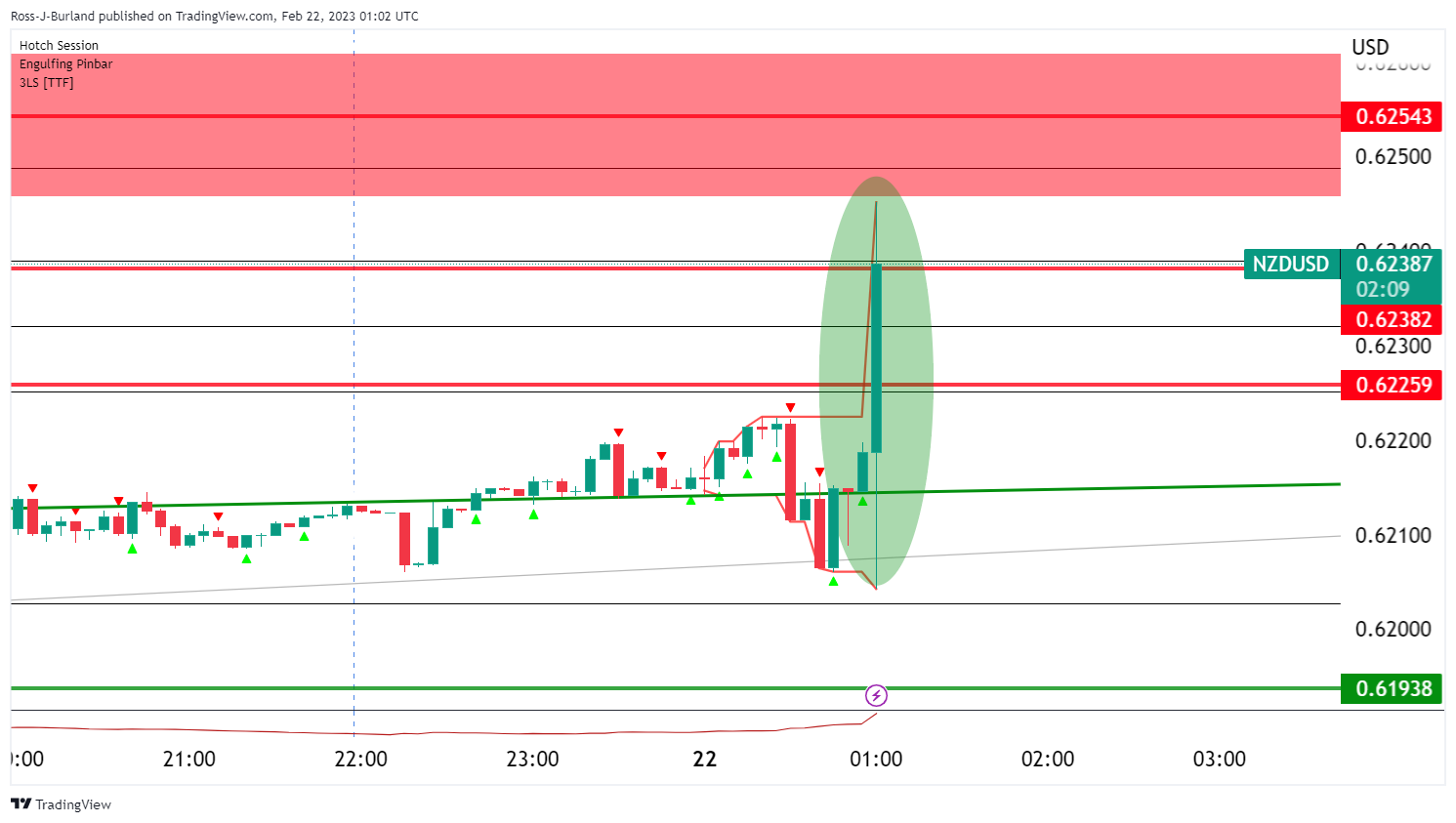
Traders are looking to the RBNZ’s peak rate forecast and Governor Adrian Orr’s press conference later today. These will likely hold the key for NZD in the short term.
About the RBNZ interest rate decision
RBNZ Interest Rate Decision is announced by the Reserve Bank of New Zealand. If the RBNZ is hawkish about the inflationary outlook of the economy and rises the interest rates it is positive, or bullish, for the NZD.
- NZD/USD has scaled firmly to near 0.6240 as the RBNZ has hiked its OCR by 50 bps to 4.75%.
- A promise of a cyclone relief package from NZ Hipkins could propel inflationary pressures further.
- The USD Index will dance to the tunes of the FOMC minutes release.
The NZD/USD pair has witnessed a significant buying interest as the Reserve Bank of New Zealand (RBNZ) has adopted a hawkish tone on interest rates. RBNZ Governor Adrian Orr has hiked the Official Cash Rate (OCR) by 50 basis points (bps) to 4.75%. A decision of 50 bps interest rate hike was widely anticipated. Investors should note that the RBNZ announced a 75 bps rate hike in its November monetary policy meeting.
A bumper rate hike was already expected by the RBNZ as the central bank has failed in easing the Consumer Price Index (CPI) in the New Zealand economy significantly. Inflationary pressures in the NZ economy have not peaked yet while the labor market has started demonstrating devastating effects due to the continuation of policy tightening by the RBNZ.
Meanwhile, the fresh release of the helicopter money as New Zealand Prime Minister (PM) Chris Hipkins has promised a cyclone relief package of NZ$300 million ($187.08 million), carries the potential of propelling inflationary pressures further.
Going forward, the monetary policy statement will dictate whether the RBNZ retains the target of a 5.5% OCR peak by May.
In the early Asian session, Statistics New Zealand released January's exports and imports figures. Exports were lower at $5.47B against the prior figure of $6.72B while Imports were higher than their former release. This indicates that the domestic demand is extremely robust.
Investors' risk appetite is improving as risk-perceived assets are gaining some strength, however, the caution still persists as investors have started discounting Federal Reserve’s (Fed) interest rates to 5%. The US Dollar Index (DXY) is facing barricades in overstepping the critical resistance of 103.90. Going forward, the USD Index will dance to the tunes of the Federal Open Market Committee (FOMC) minutes release.
- EUR/USD bulls move in following strong US Dollar on Tuesday.
- Eurozone and US data were solid and inflation risks are in vogue.
The US Dollar rose against all G10 except sterling while EUR/USD was choppy but ultimately 40 pips lower to 1.0637. At the time of writing, EUR/USD is trading at 1.0655 and has stuck to a narrow range of 1.0655/42 so far.
In Europe, analysts at Westpac explained that Eurozone PMIs showed an outperformance in services which rose to 53.0 (est. 51.0, prior 50.8). However, manufacturing fell to 48.5 (est. 49.3, prior 48.8), the composite rose to 52.3 (est. 50.7, prior 50.3). They explained that the ZEW Survey saw gains in both expectations and current conditions for Germany and the Eurozone. German expectations rose to 28.1 (est. 23.0, prior 16.9), with current conditions of -45.1 (est. -50.5 and prior -58.6). Eurozone expectations rose to +29.7 (prior 16.7), with current conditions of -41.6 (prior -54.8).
The US Dollar held on to modest gains against its peers on Tuesday, supported by strong US economic data. US S&P flash February PMIs were firmer than expected, with services rising to 50.5 (est. 47.3, prior 46.8), manufacturing at 47.8 (est. 47.2, prior 46.9), and the composite at 50.2 (est. 47.5, prior 46.8).
FOMC minutes eyed
The data followed a slew of recent robust data on Retail Sales, the labour market and manufacturing production. This all is suggesting solid momentum and US Treasury yields hit new highs on Tuesday while investors are setting up for a longer-than-anticipated stiff monetary policy stance by the Federal Reserve following a slew of strong economic data. ''This process still has a ways to go, in our view,'' analysts at Brown Brothers Harriman explained.
The analysts noted that the WIRP suggests 25 bp hikes in March, May, and June that takes Fed Funds to 5.25-5.50%. ''Given how strong the data have been recently, we see growing risks of a fourth 25 bp hike that takes us up to 5.50-5.75%, though that is not being priced in yet. This should eventually change,'' the analysts said.
''Strangely enough, an easing cycle is still expected to begin in Q4 but at much lower odds. Eventually, it should be totally priced out into 2024 in the next stage of Fed repricing.''
Looking ahead, the next major catalyst will be the Federal Reserve's release of the minutes of its last meeting on Wednesday, which will give traders a glimpse of how high officials are projecting interest rates will go following this impressive run of recent data.
''Fed speak before the Feb FOMC meeting and the presser that followed pointed to a more dovish Fed stance. However, strong inflation and labor market data since then have turned Fed speak more hawkish,'' analysts at TD Securities explained. ''The final version of the minutes is likely to somewhat downplay the clear dovishness at the time. Overall, the minutes are likely to be too outdated to impact markets meaningfully.''
- US Dollar Index struggles to extend the previous day’s run-up around six-week high.
- Upbeat US data, geopolitical fears underpinned the DXY’s rise on Tuesday.
- Strong US Treasury bond yields also pleased greenback buyers on US traders’ return from long weekend.
- Fed Minutes should avoid mentioning policy pivot to keep DXY bulls on board.
US Dollar Index (DXY) renews its intraday low near 104.12 as it pares the biggest daily gains in a week during early Wednesday.
That said, the greenback’s gauge versus the six major currencies rose the most in one week the previous day as the US business activity numbers matched the likes of previously published US inflation numbers, Retail Sales and employment data. Also fueling the DXY were the market’s geopolitical fears surrounding China and Russia.
As per the latest readings, the preliminary US S&P Global Manufacturing PMI rose to 47.8 in February from 46.9 prior and versus 47.3 market forecasts while the Services PMI jumped to the eight-month high to 50.5 compared to 47.2 expected and 46.8 previous readings. As a result, the S&P Global Composite PMI surpassed 47.5 analysts’ consensus and 46.8 previous reading to mark 50.2 figure.
The strong data helped the FEDWATCH tool to suggest that the money market participants see the benchmark level peaking at 5.3% in July, and staying near those levels throughout the year, versus 5.10% expected by the US Federal Reserve (Fed).
Talking about geopolitical risk, comments from US Secretary of State Antony Blinken and Russian President Vladimir Putin were the top catalysts that weigh on the market sentiment and fuelled the US Dollar’s haven demand. That said, the US Secretary of State Blinked said the United States suspects China is considering providing military support to Russia. On the same line are the market concerns of the US-Taiwan trade deal. On the other hand, Russia suspended its nuclear arms treaty with the US and pledged to maintain its military actions in Ukraine.
Furthermore, Russian President Vladimir Putin delivered his state of the nation address to Russia’s Federal Assembly while speaking to both houses of parliament on Tuesday. During the speech, Russian President Putin clearly mentioned, “Our task is to lead our economy to new frontiers,” which in turn highlights further geopolitical tension surrounding Ukraine. On the same line, US Deputy Treasury Secretary Wally Adeyemo said on Tuesday, “US and allies plan new sanctions this week to continue to isolate Russia over the war in Ukraine.”
Amid these plays, the US 10-year and two-year treasury bond yields seesaw around the three-month highs marked the previous day while S&P 500 Futures print mild gains despite Wall Street’s negative closing.
Looking ahead, a cautious mood ahead of the key data/events could probe DXY bulls before the Fed Minutes. However, any mention of the policy pivot in the Minutes may not hesitate to recall the US Dollar Index bears.
Technical analysis
Despite the latest inaction, the US Dollar Index successfully trades beyond the 50-day Exponential Moving Average (EMA) level of 103.80, which in turn keeps the DXY bulls directed towards a convergence of fortnight-old ascending trend line and 100-day EMA, near 104.90.
- USD/CAD is aiming to surpass the immediate resistance of 1.3550 as the risk-off mood solidifies.
- Weaker oil prices and declining Canada inflation are impacting the Canadian Dollar.
- Investors are awaiting the FOMC minutes release for the interest rate guidance.
The USD/CAD pair is demonstrating an inventory adjustment process around the immediate resistance of 1.3550 in the Asian session. The Loonie asset is expected to overstep the above-mentioned resistance confidently amid rising bets for more rates by the Federal Reserve (Fed) and declining oil prices.
S&P500 futures are displaying some gains in the Tokyo session after a super-bearish Tuesday as the upbeat preliminary United States S&P PMI data propelled hawkish Fed bets. This indicates a minor sense of optimism in an overall risk-off mood. In this case, investors should restrict themselves from building aggressive longs in the risk-perceived assets sooner. The US Dollar Index (DXY) is likely to overstep the 103.90 hurdle amid the risk aversion theme.
The upbeat US PMI strictly speaks the language of consumer spending, which looks solid now and advocates for further policy tightening by Fed chair Jerome Powell. No doubt, plenty of signs are available that favor more restrictions on the monetary policy but investors will still await the release of the Federal Open Market Committee (FOMC) minutes for further guidance.
Meanwhile, the Canadian Dollar was in action on Tuesday after the release of the Consumer Price Index (CPI) and the Retail Sales data. The headline and core CPI dropped to 5.9% and 5.0% from their estimates, which indicates that higher interest rates by the Bank of Canada (BoC) are effectively softening the price pressures.
It is worth noting that BoC Governor Tiff Macklem has paused policy tightening for a while, citing that the current monetary policy is restrictive enough to tame inflation for now.
Contrary to the Canadian CPI, monthly Retail Sales (Dec) data expanded by 0.5% from the consensus of 0.2%. An expansion in consumer spending could dampen the softening price pressures ahead.
On the oil front, the oil price is declining towards $75.50 as the demand recovery in China is not parallel to the anticipation. Investors should note that Canada is a leading exporter of oil to the United States and lower oil prices could weaken the Canadian Dollar.
- AUD/USD licks its wounds after falling the most in a week.
- Clear U-turn from three-week-old resistance line, 50-SMA joins bearish MACD signals to suggest further downside.
- Ascending trend line from the last Friday restricts immediate downside of Aussie pair.
- Previous support line from December, 100-SMA add to the upside filters.
AUD/USD remains sidelined near 0.6860, printing mild gains by the press time of Wednesday’s Asian session, as bears take a breather following the biggest daily slump since the last Wednesday.
Even so, the Aussie pair keeps the previous week’s retreat from a downward-sloping resistance line from February 02, as well as the 50-SMA, amid a bearish MACD signal.
Also adding strength to the downside bias is the sustained trading below the support-turned-resistance line from late December 2022.
However, an upward-sloping support line from the last Friday, close to 0.6850 by the press time, restricts the immediate downside of the AUD/USD pair.
Following that, the 61.8% Fibonacci retracement level of the pair’s run-up from December 2022 to early February 2023, near 0.6830, will precede the monthly low of 0.6811 to challenge the AUD/USD bears before giving them control.
On the contrary, the aforementioned three-week-old descending resistance line, near 0.6900, as well as the 50-SMA level of around 0.6910, guard short-term AUD/USD recovery ahead of the multi-day-old previous support line, close to 0.6935 at the latest.
It should be noted that the 100-SMA level of 0.6950 acts as the last defense of the AUD/USD pair bears.
AUD/USD: Four-hour chart
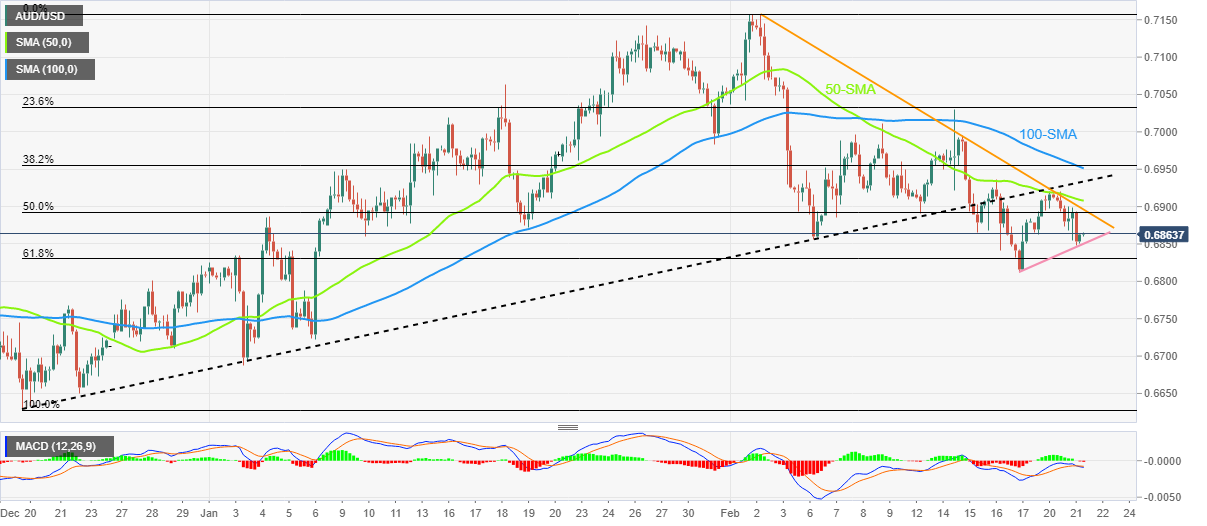
Trend: Further downside expected
| Index | Change, points | Closed | Change, % |
|---|---|---|---|
| NIKKEI 225 | -58.84 | 27473.1 | -0.21 |
| Hang Seng | -357.47 | 20529.49 | -1.71 |
| KOSPI | 3.84 | 2458.96 | 0.16 |
| ASX 200 | -15.2 | 7336.3 | -0.21 |
| FTSE 100 | -36.55 | 7977.75 | -0.46 |
| DAX | -79.93 | 15397.62 | -0.52 |
| CAC 40 | -26.96 | 7308.65 | -0.37 |
| Dow Jones | -697.1 | 33129.59 | -2.06 |
| S&P 500 | -81.75 | 3997.34 | -2 |
| NASDAQ Composite | -294.97 | 11492.3 | -2.5 |
- NZD/USD is getting set for the RBNZ and holds potential support.
- Bulls eye a move into shorts with 0.6220s eyed.
NZD/USD was unable to hold in positive territory on Tuesday and came crashing down from the initial move up in Asia that was met with strong supply for the entire day. The pair fell from a high of 0.6261 and dropped to a low for the day at 0.6202.
It's been several days that have been driven by the sentiment surrounding the Federal Reserve in between data releases, but today is all about the Reserve Bank of New Zealand.
The market is anticipating a 50bp hike in the Overnight Cash Rate, OCR, to 4.75%, although pricing is a little short of 50bp for today, potentially reflecting the cyclone impact on spending and confidence, as analysts at Westpac said in a note today. Markets price the OCR to peak around 5.4%.
All in all, the outlook for inflation around the world is higher and that is the commodities bloc positive for which the Kiwi trades as a proxy. There is quite a lot of length that has been building into the US dollar and the Kiwi was been running low on gas for several days which could mean that the path of least resistance is to the upside for a short squeeze as the following analysis leans towards:
NZD/USD H4 chart
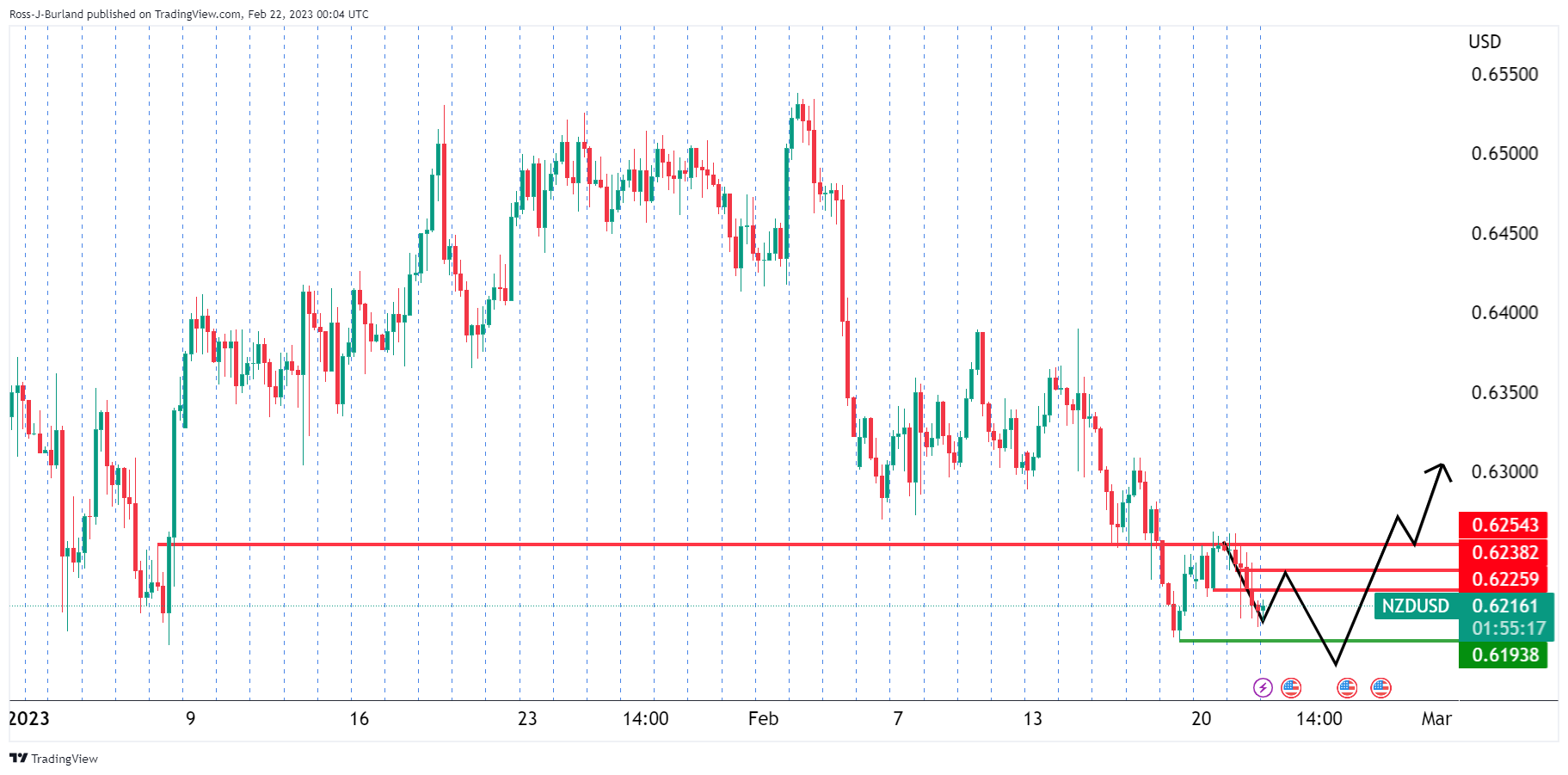
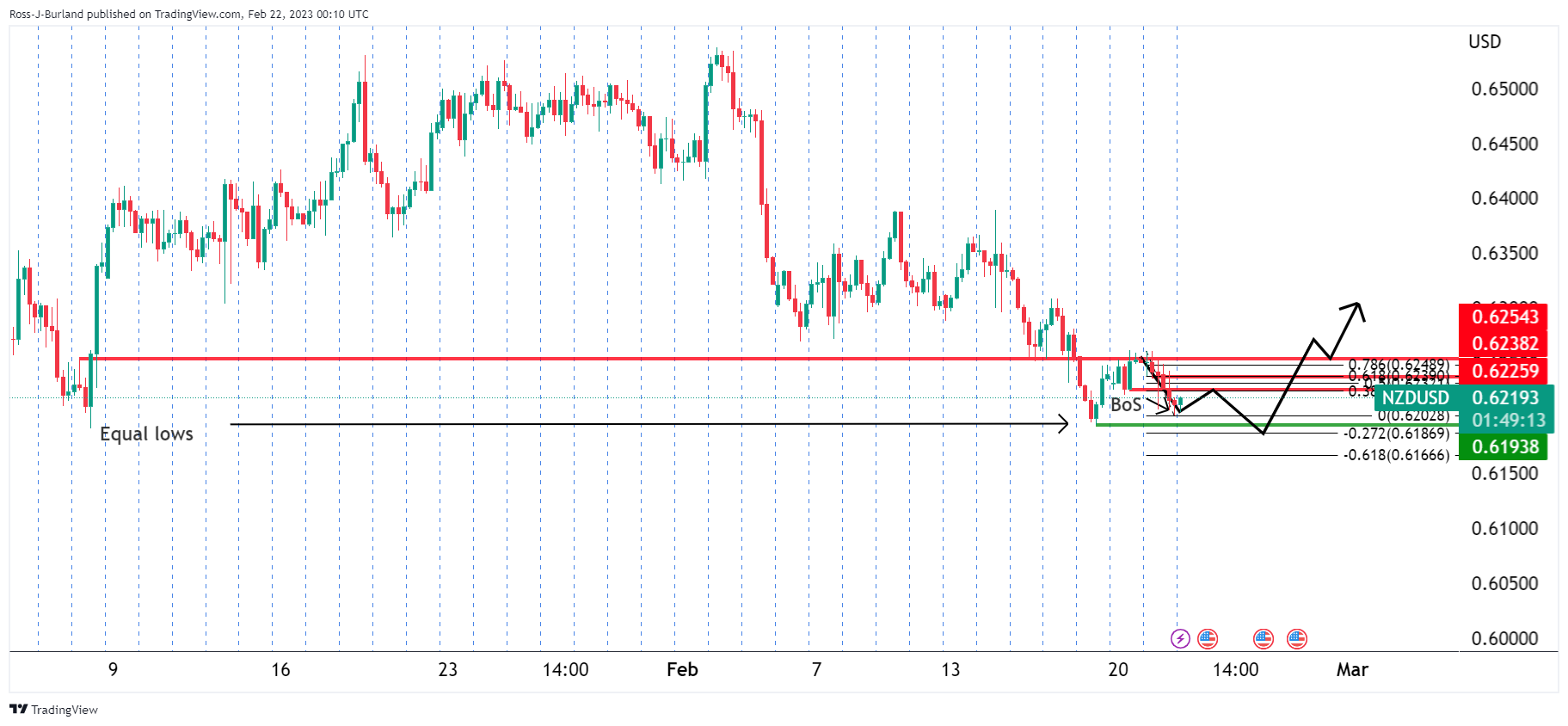
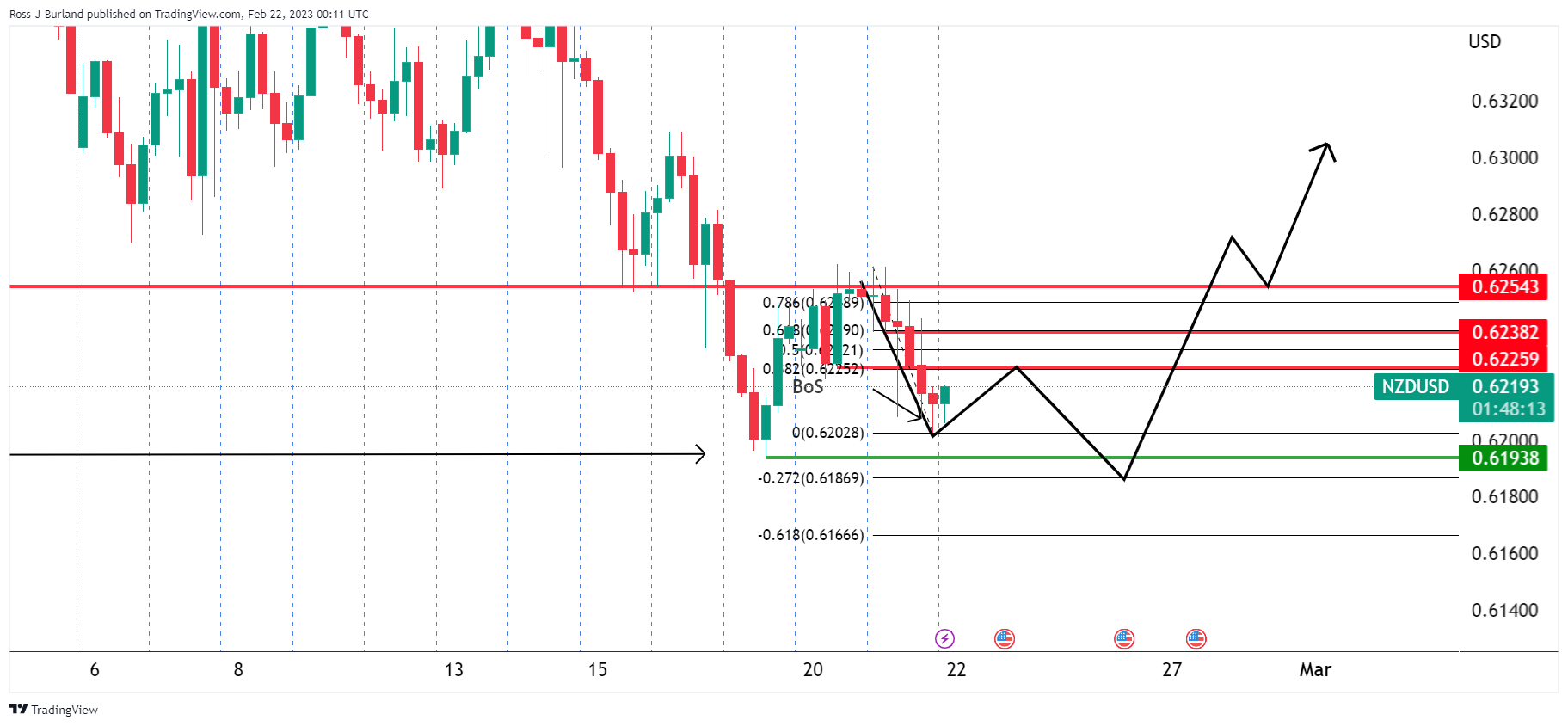
The above schematic on the four-hour chart represents a move into the prior support that meets a 38.2% Fibonacci before moving back into the equal lows before a capitulation of the bears (US dollar bulls) to take on the 0.63s in a short squeeze.
On the other hand, should the RBNZ be more hawkish than expected, there is room for a short squeeze into shorts from 0.6250:
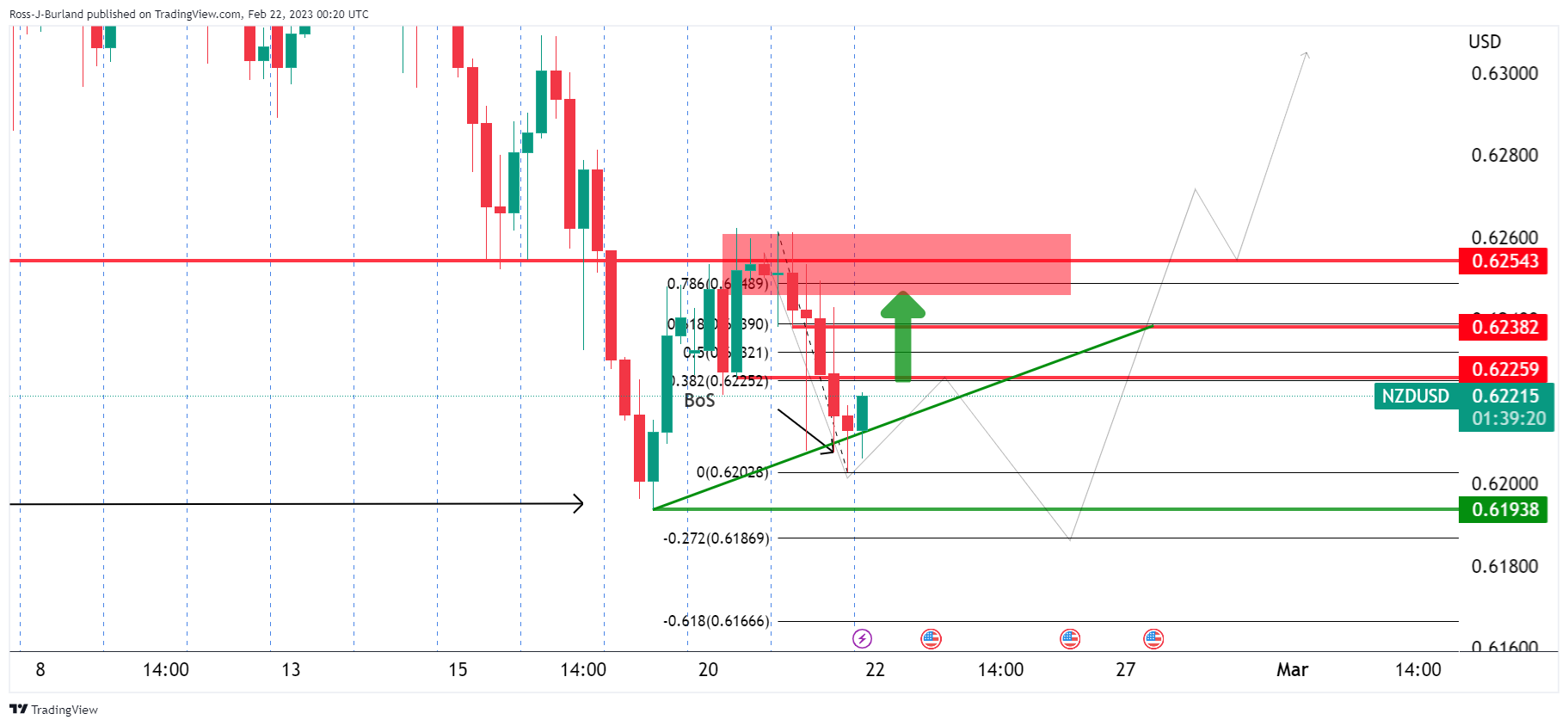
| Pare | Closed | Change, % |
|---|---|---|
| AUDUSD | 0.68546 | -0.71 |
| EURJPY | 143.735 | 0.22 |
| EURUSD | 1.06452 | -0.35 |
| GBPJPY | 163.512 | 1.18 |
| GBPUSD | 1.21105 | 0.61 |
| NZDUSD | 0.62123 | -0.63 |
| USDCAD | 1.3538 | 0.66 |
| USDCHF | 0.92783 | 0.58 |
| USDJPY | 135.015 | 0.59 |
- USD/JPY retreats from two-month high, sidelined of late.
- Yields remain sluggish after refreshing the multi-day top.
- Mixed Japan data contrasts with strong US statistics, hawkish Fed bets to keep buyers hopeful.
- FOMC Minutes should refrain from policy pivot talks to keep Yen pair buyers hopeful, Japan wage talks eyed as well.
USD/JPY bulls take a breather after a three-day winning streak, making rounds to 135.00 as Tokyo opens on Wednesday. In doing so, the Yen pair tracks the grinding of the US Treasury bond yields around multi-day top ahead of the key Federal Open Market Committee’s (FOMC) Monetary Policy Meeting Minutes. It should be noted that the recently softer Japan data and upbeat US statistics underpin the hawkish Fed bets to keep buyers hopeful.
Recently, Reuters Tankan Manufacturing Index for Japan came in as -5.0 for February versus -6.0 in January. On the same line, Tankan Non-Manufacturing Index eased to 17 for the said month versus 20.0 prior.
On Tuesday, the preliminary readings of the US S&P Global Manufacturing PMI rose to 47.8 from 46.9 prior and versus 47.3 market forecasts while the Services PMI jumped to the eight-month high to 50.5 compared to 47.2 expected and 46.8 previous readings. As a result, the S&P Global Composite PMI surpassed 47.5 analysts’ consensus and 46.8 previous reading to mark 50.2 figure.
Further, Japan’s wage talks and signals for higher payments to workers in Tokyo seem to underpin the need for hawkish Bank of Japan (BoJ) action even if the latest chatters favor Governor Haruhiko Kuroda’s one last shot at the ultra-easy monetary policy before he retires in April.
On the other hand, the FEDWATCH tool signals that the money market participants see the benchmark level peaking at 5.3% in July, and staying near those levels throughout the year, versus 5.10% expected by the US Federal Reserve (Fed).
It should be noted that the upbeat US data and hawkish Fed bets propelled the US Treasury bond yields the previous day. That said, the benchmark 10-year bond coupon refreshed a three-month high near 3.95% while the two-year counterpart also jumped to the highest levels since early November 2022, to 4.73% at the latest. By the press time, the US 10-year and two-year Treasury bond yields remain sidelined near 3.96% and 4.73%.
On a different page, Wall Street closed in the red as geopolitical fears emanating from Russia and China joined the aforementioned hawkish Fed bets, as well as downbeat earnings forecasts from the tops US retailers including Home Depot and Wall Mart.
Amid these plays, S&P 500 Futures print mild gains by the press time while Japan’s Nikkei 225 drops 0.85% on a day by the press time.
Moving on, a cautious mood ahead of the key data/events could entertain USD/JPY traders before the Fed Minutes. However, any mention of the policy pivot in the Minutes should weigh on the price as BoJ doves aren’t far from the field.
Technical analysis
A daily closing beyond the 100-day Exponential Moving Average (EMA), around 134.75 by the press time, directs USD/JPY buyers towards mid-December 2022 tops surrounding 138.20.
- Oil price is declining towards $75.50 as the expectations for more rate hikes by the Fed are escalating.
- Producers in China are failing to lift the WPI from deflation, indicating that the retail demand is still stagnant.
- The oil inventory data by the US API will be keenly watched.
West Texas Intermediate (WTI), futures on NYMEX, have dropped after failing to surpass the critical resistance of $77.50. The oil price is expected to extend its downside to near $75.50 as investors are worried that accelerating chances of further policy tightening by the Federal Reserve (Fed) will strengthen recession fears in the United States.
The release of the upbeat preliminary S&P US PMI data was loud and clear that economic activities are routing to the expansionary road led by solid consumer spending. A sheer recovery in retail demand could renew the fears of a rebound in inflationary pressures. Also, Fed chair Jerome Powell has already cleared that inflation is persistent and the consideration of a pause in policy tightening would be premature.
On Wednesday, the release of the Federal Open Market Committee (FOMC) minutes will determine what authorities are planning for the terminal rate and targets decided for inflation for the current year and a roadmap for achieving the 2% inflation target.
The US Dollar Index (DXY) is gathering strength to deliver a break above the immediate resistance of 103.90 amid the risk aversion theme.
Meanwhile, fading hopes of a sheer recovery in China after lifting the pandemic controls by the administration is impacting the oil price. Producers are failing to lift the Wholesale Price Index (WPI) from deflation, which indicates that the retail demand is still stagnant. Therefore, the inability of the Chinese government in spurting the overall demand despite releasing helicopter money is barricading the black gold.
Wednesday’s release of the weekly crude stockpiles for the week ending February 17 by the US American Petroleum Institute (API) will be keenly watched. The inventory data is delayed to Wednesday as US markets were closed on Monday on account of Presidents’ Day.
© 2000-2024. All rights reserved.
This site is managed by Teletrade D.J. LLC 2351 LLC 2022 (Euro House, Richmond Hill Road, Kingstown, VC0100, St. Vincent and the Grenadines).
The information on this website is for informational purposes only and does not constitute any investment advice.
The company does not serve or provide services to customers who are residents of the US, Canada, Iran, The Democratic People's Republic of Korea, Yemen and FATF blacklisted countries.
Making transactions on financial markets with marginal financial instruments opens up wide possibilities and allows investors who are willing to take risks to earn high profits, carrying a potentially high risk of losses at the same time. Therefore you should responsibly approach the issue of choosing the appropriate investment strategy, taking the available resources into account, before starting trading.
Use of the information: full or partial use of materials from this website must always be referenced to TeleTrade as the source of information. Use of the materials on the Internet must be accompanied by a hyperlink to teletrade.org. Automatic import of materials and information from this website is prohibited.
Please contact our PR department if you have any questions or need assistance at pr@teletrade.global.
















